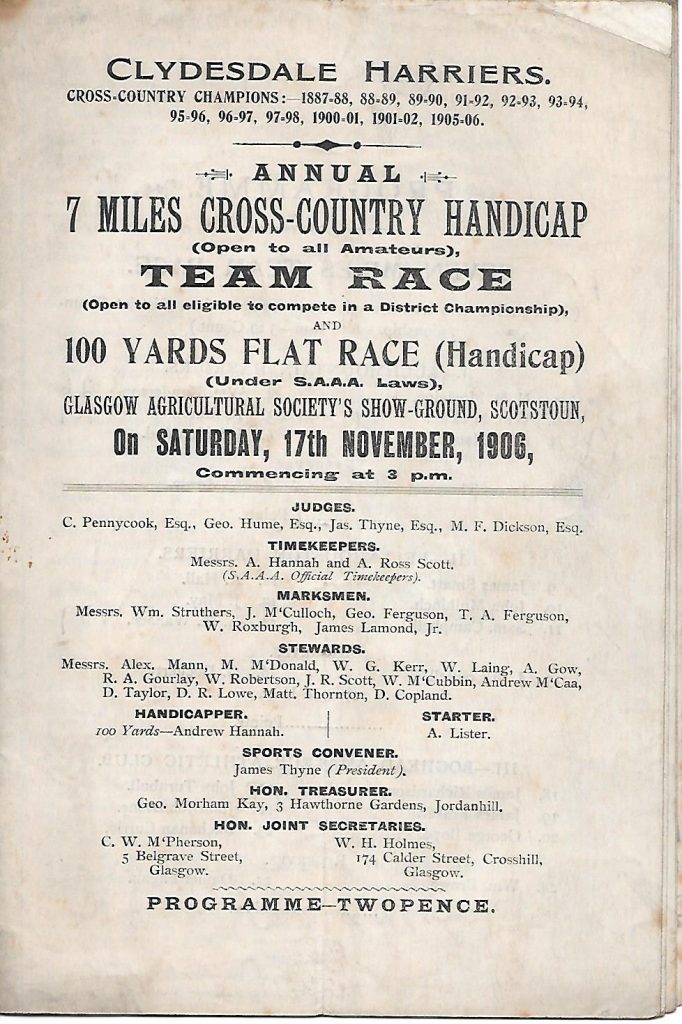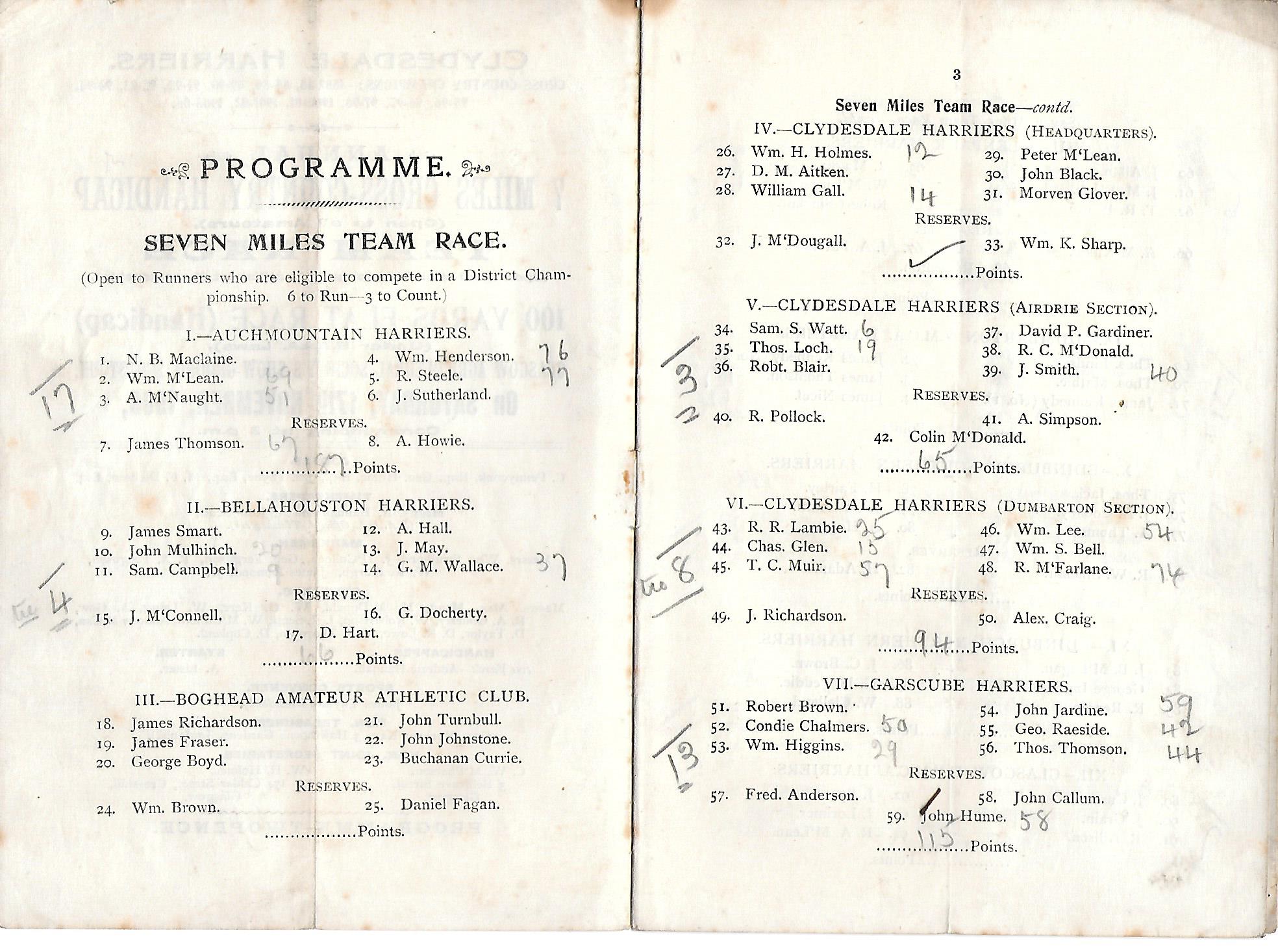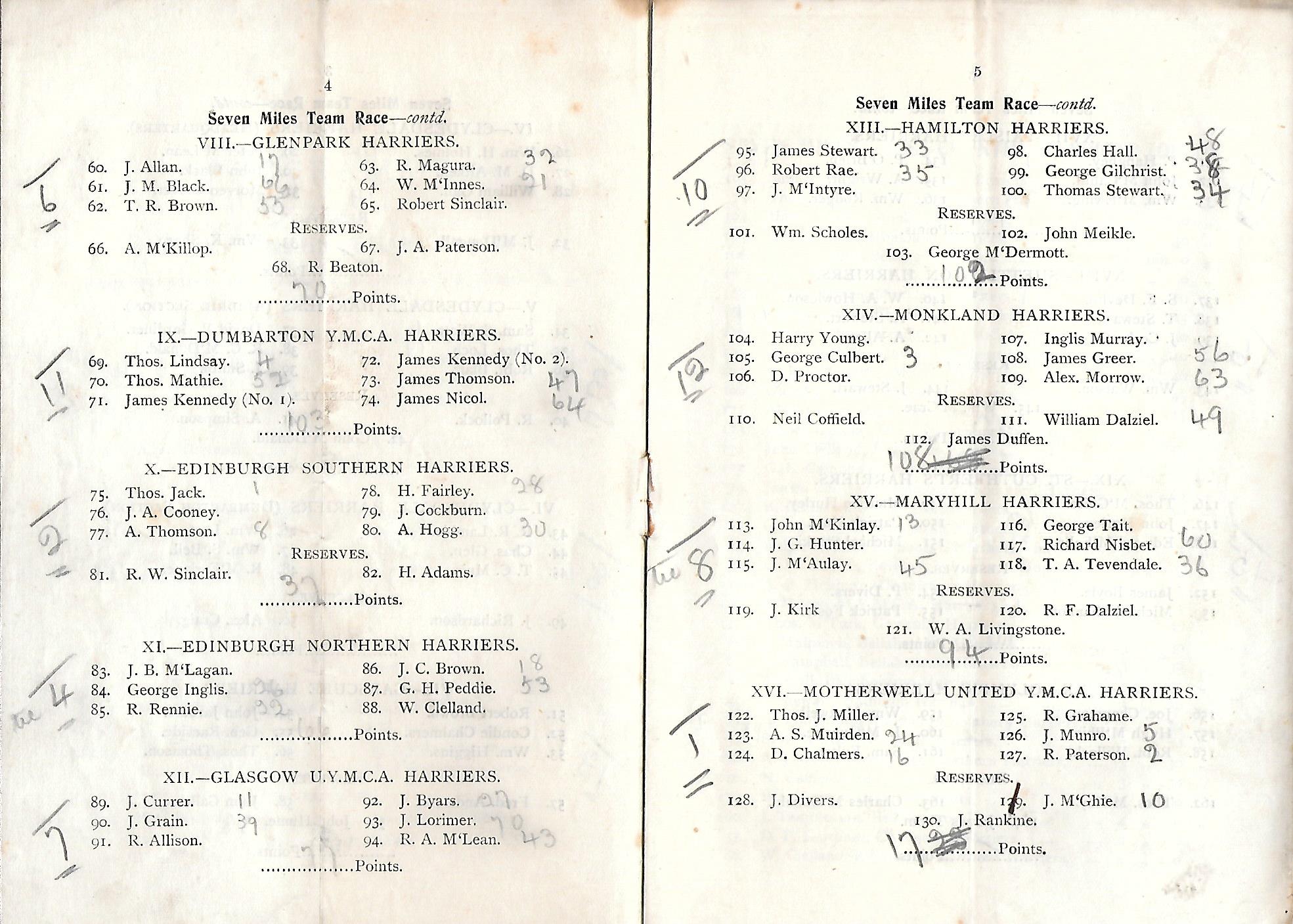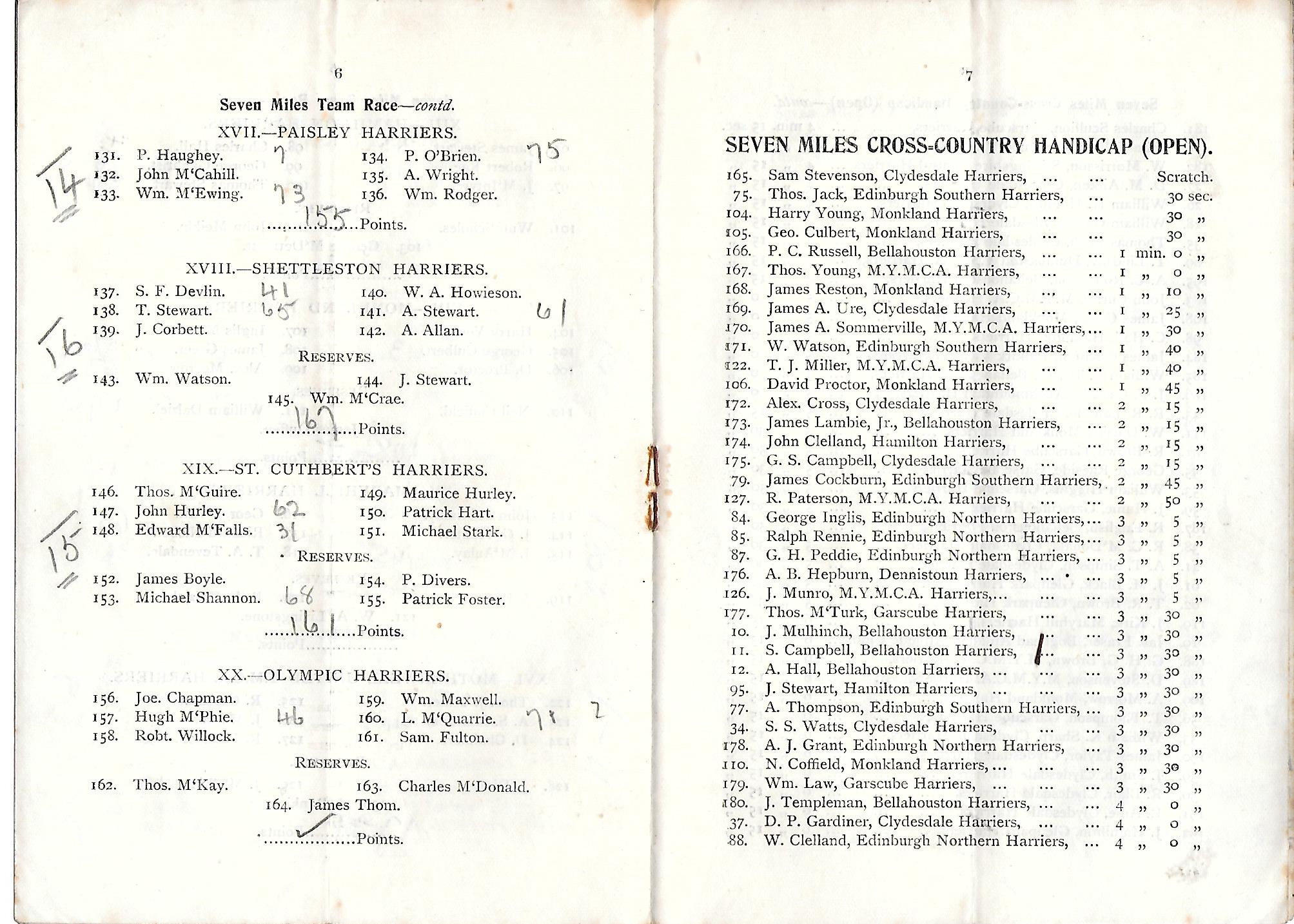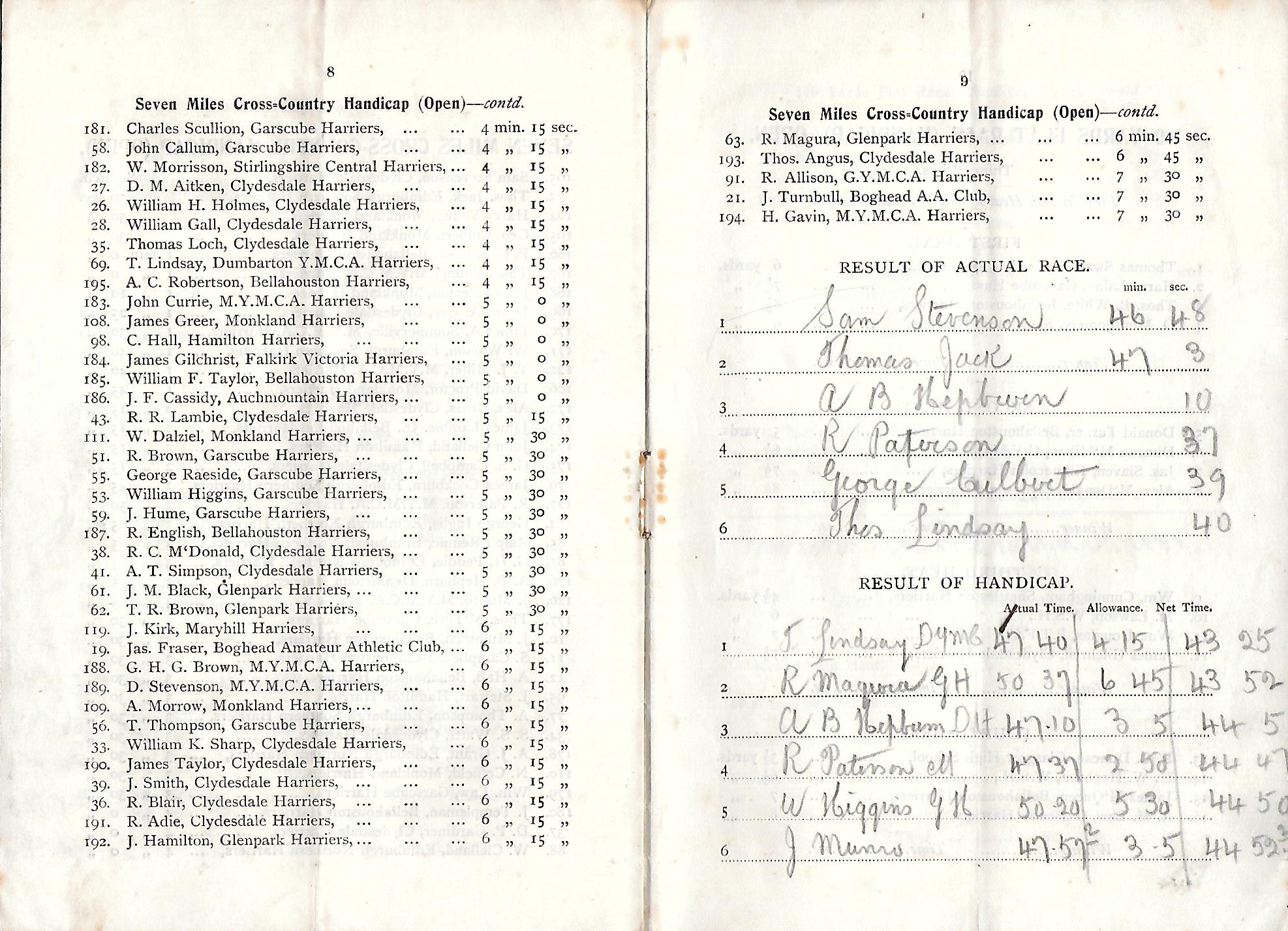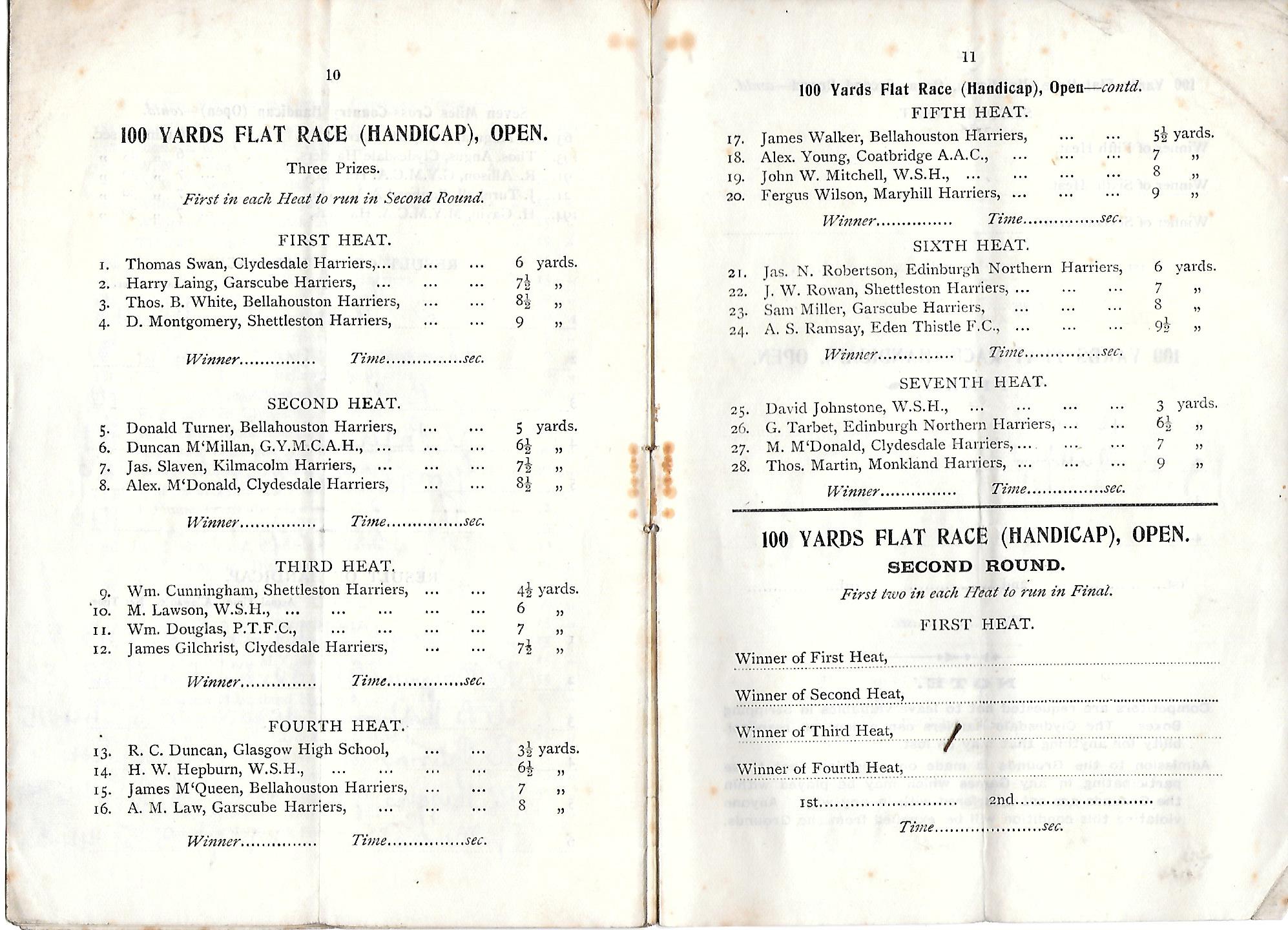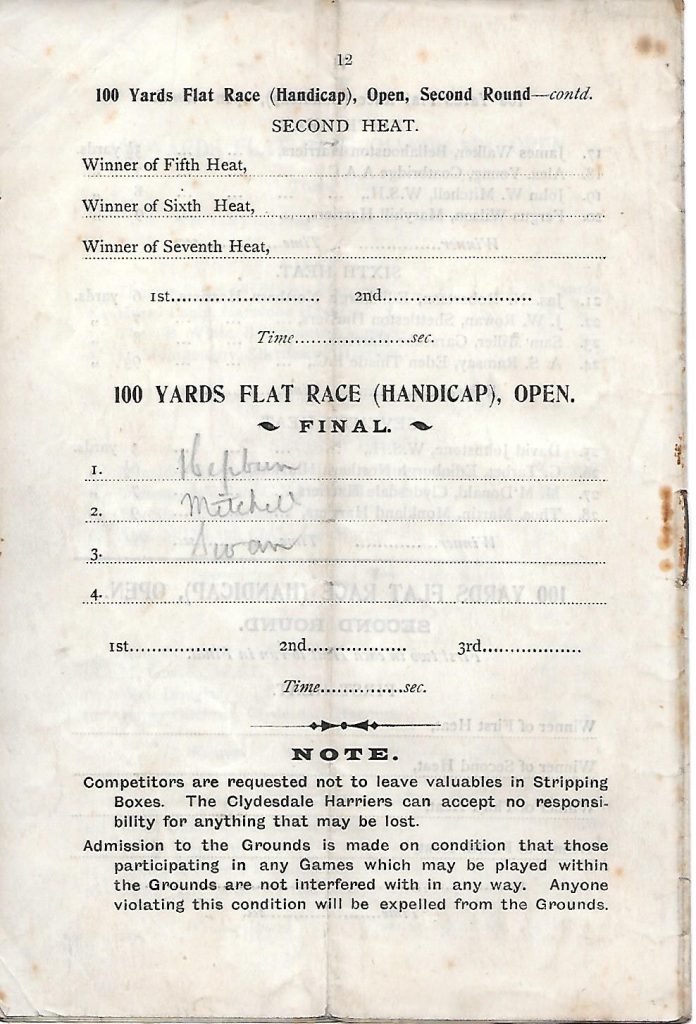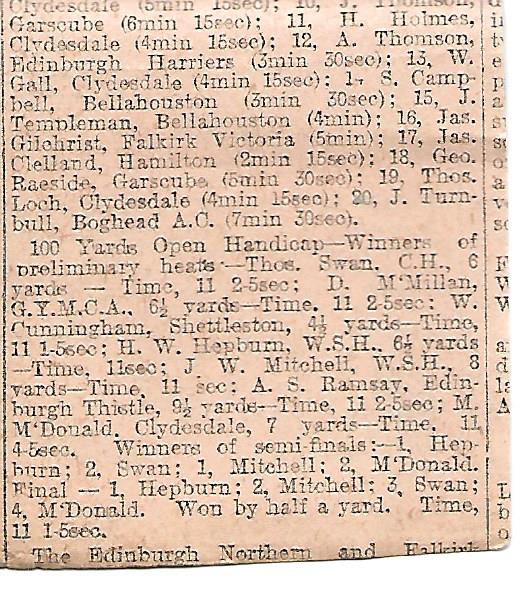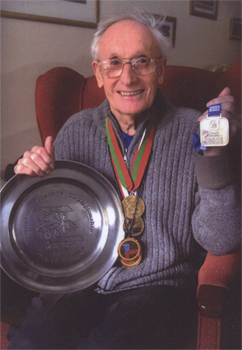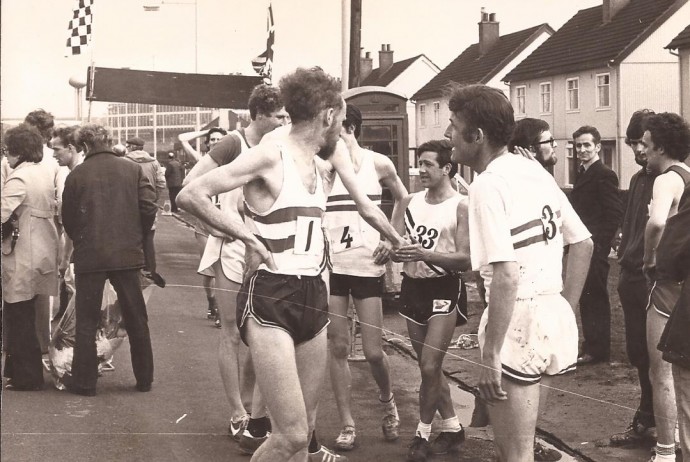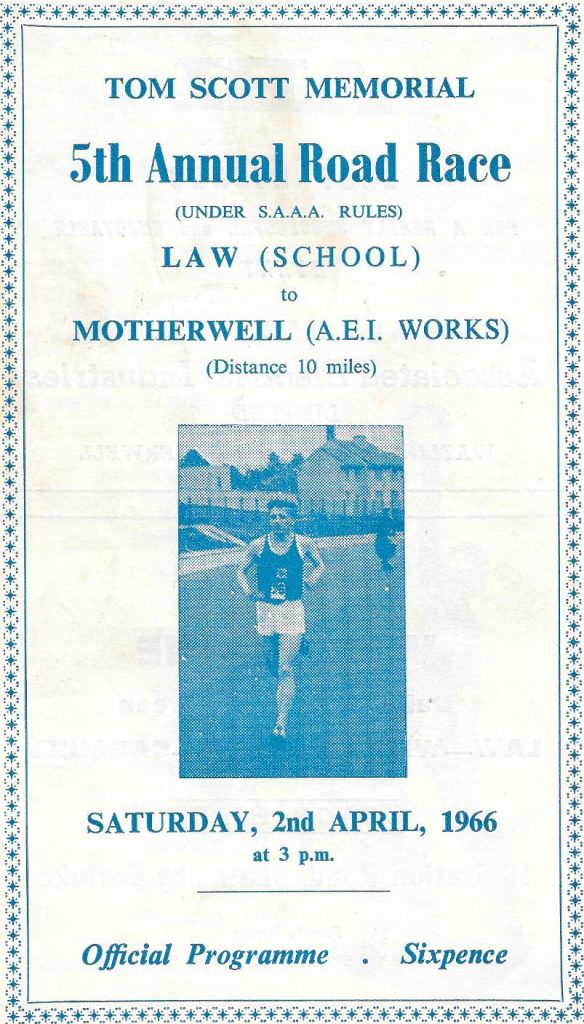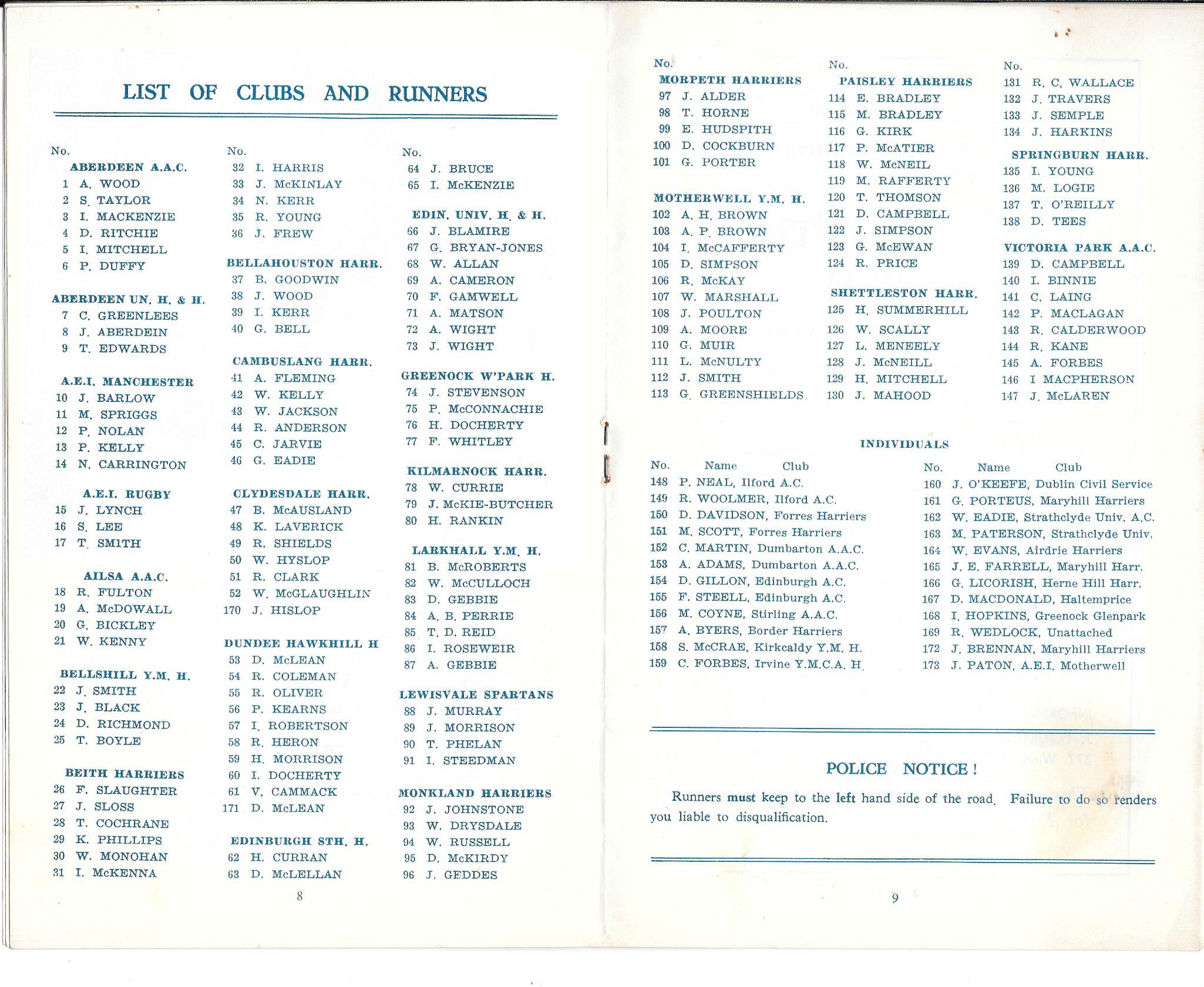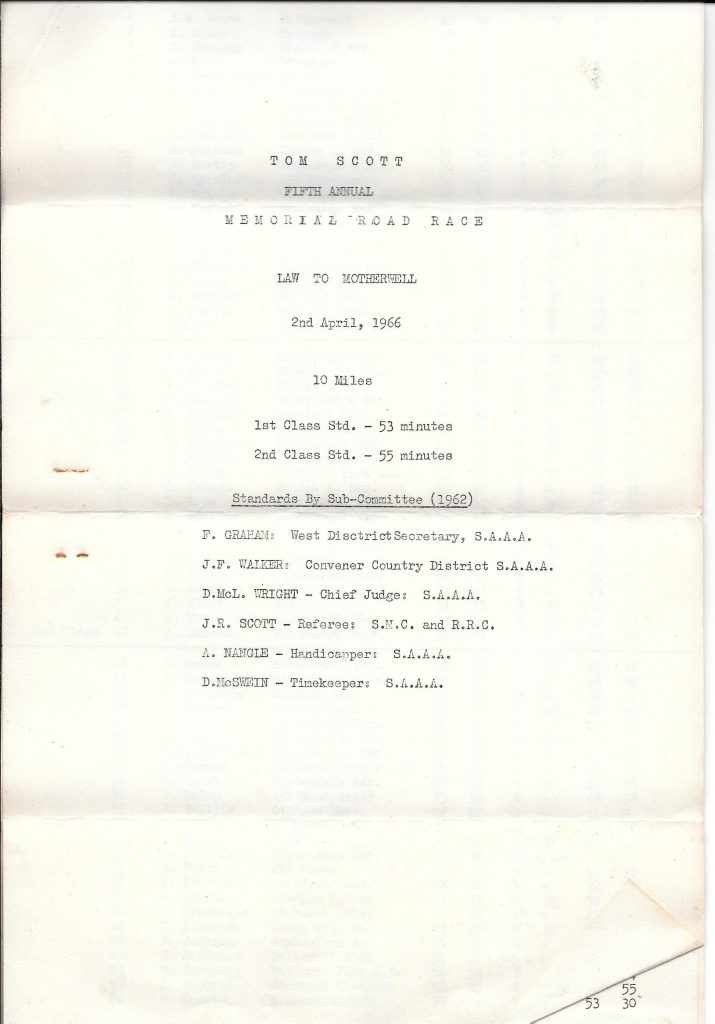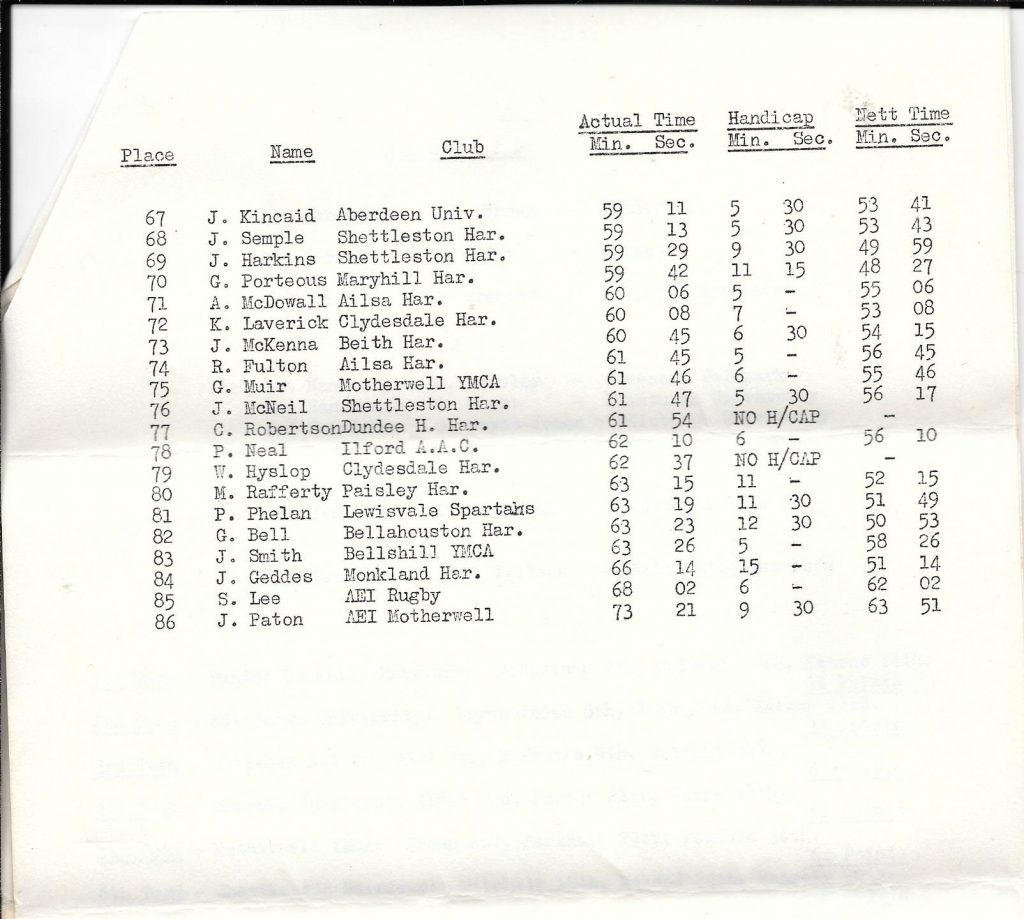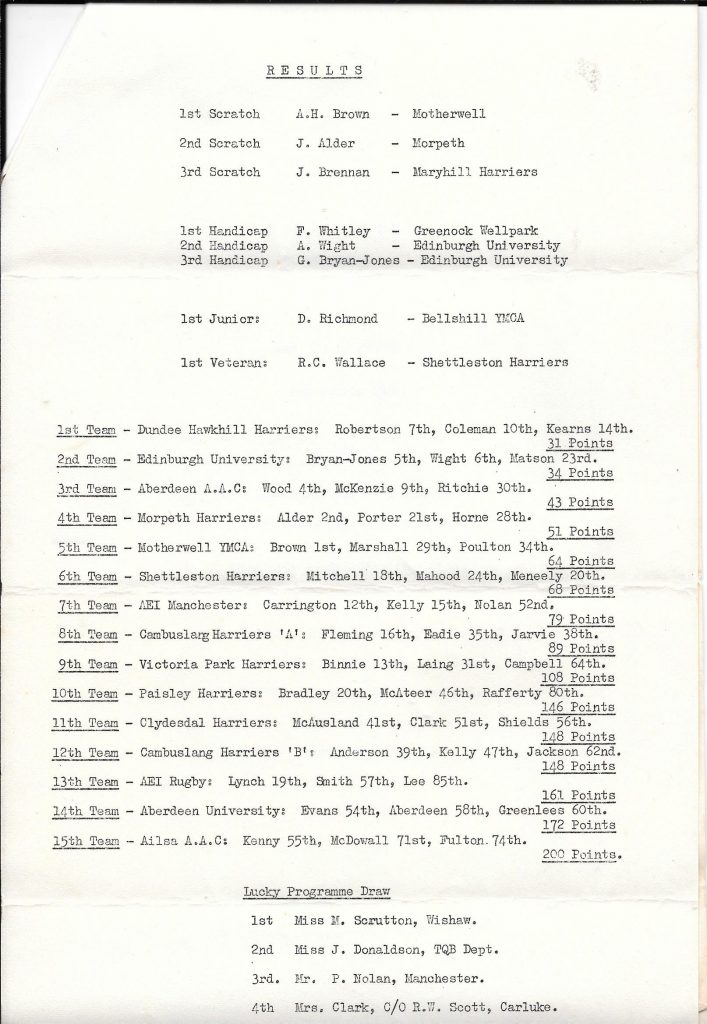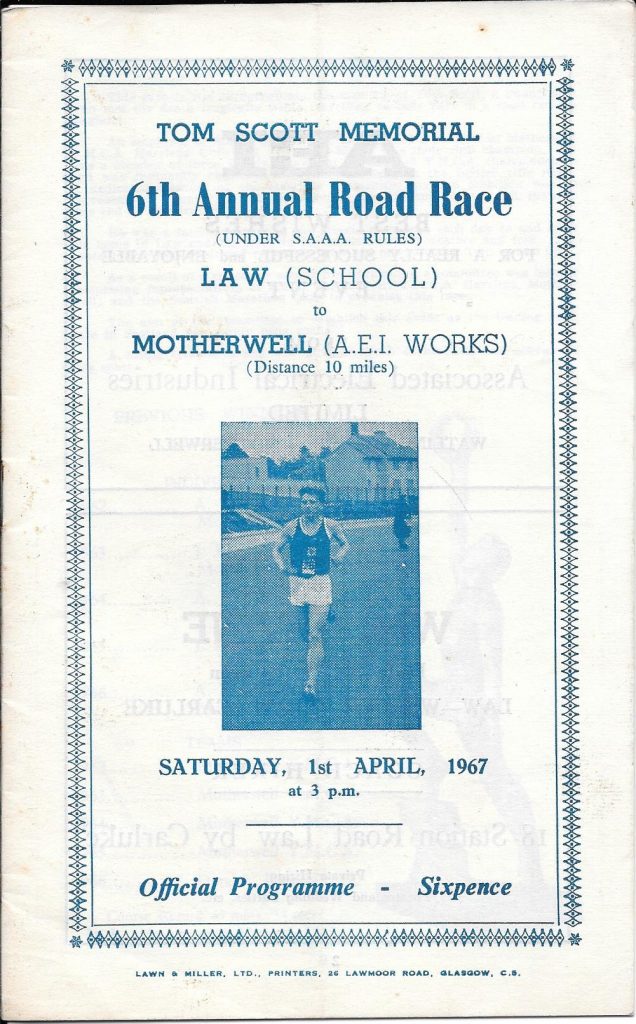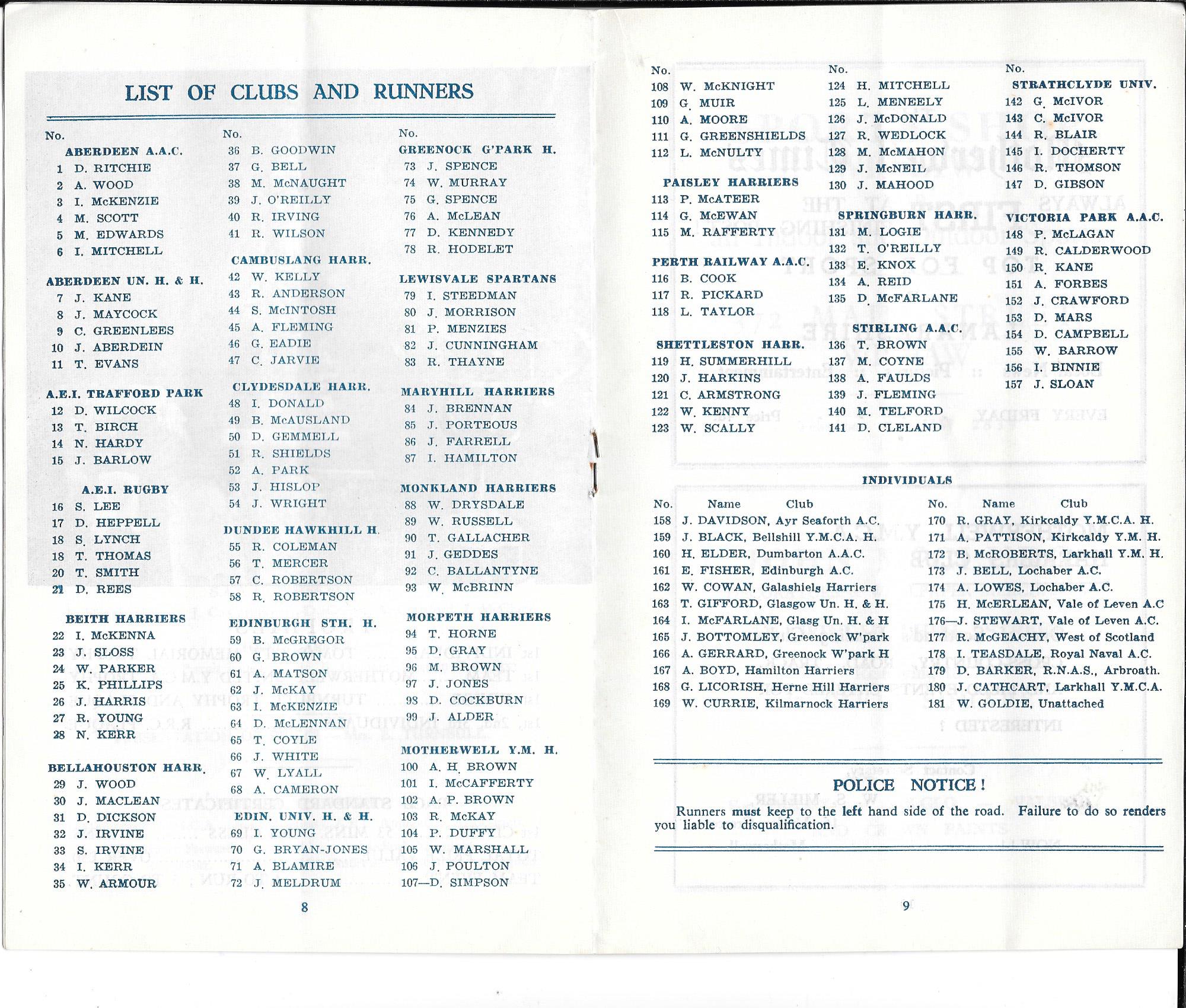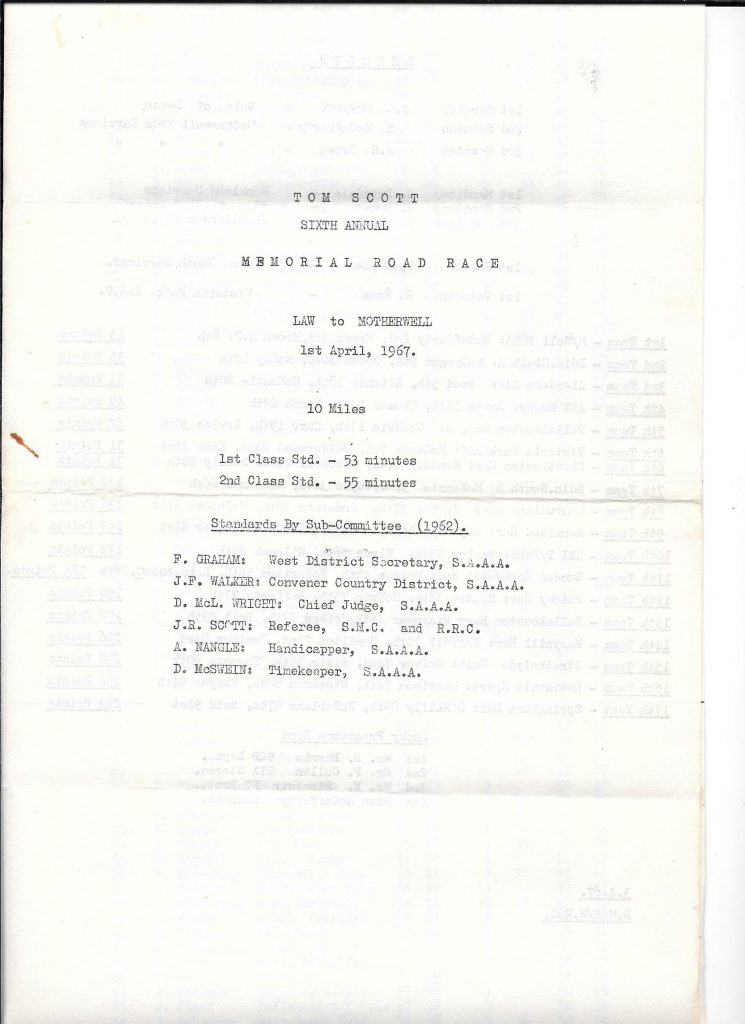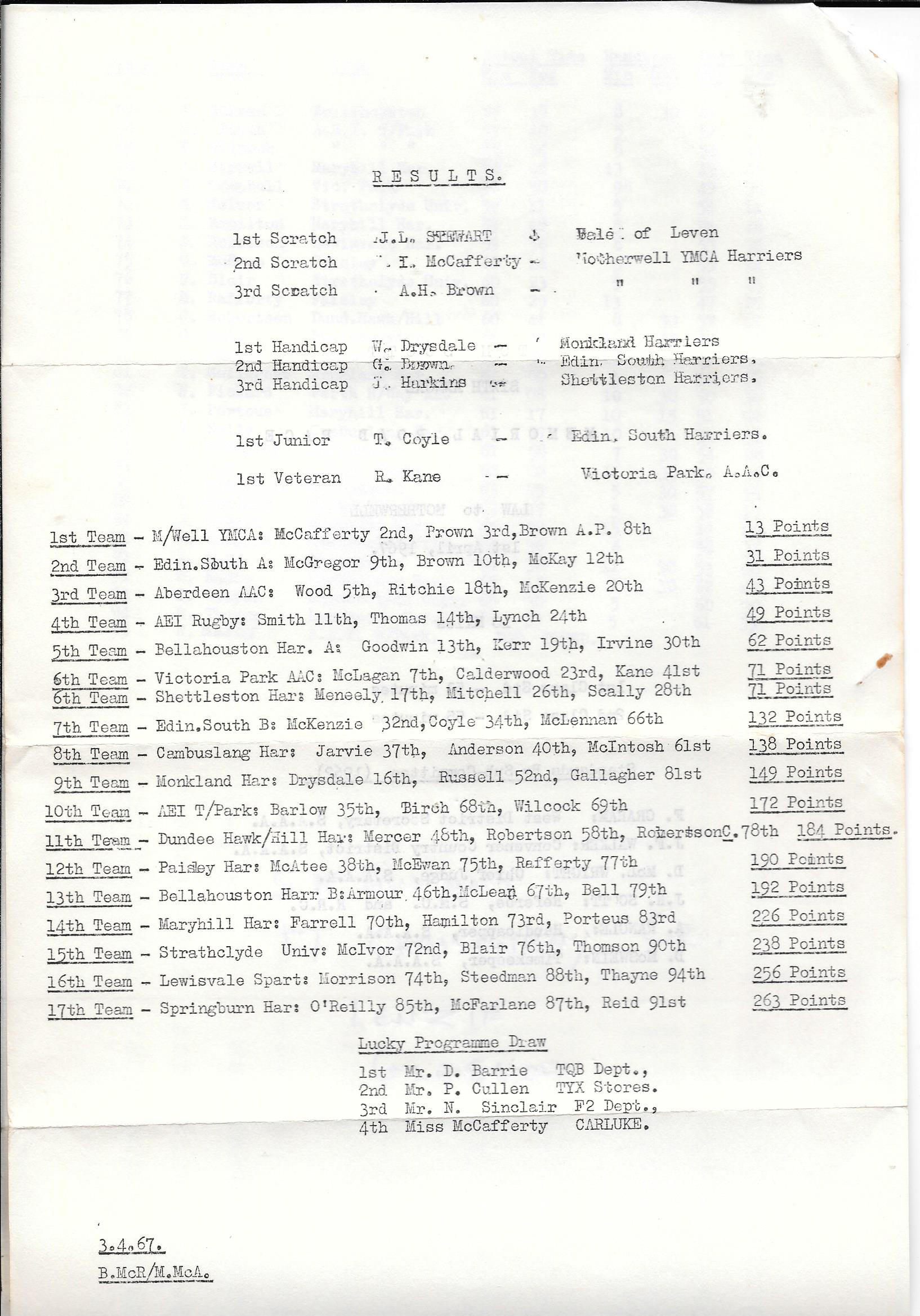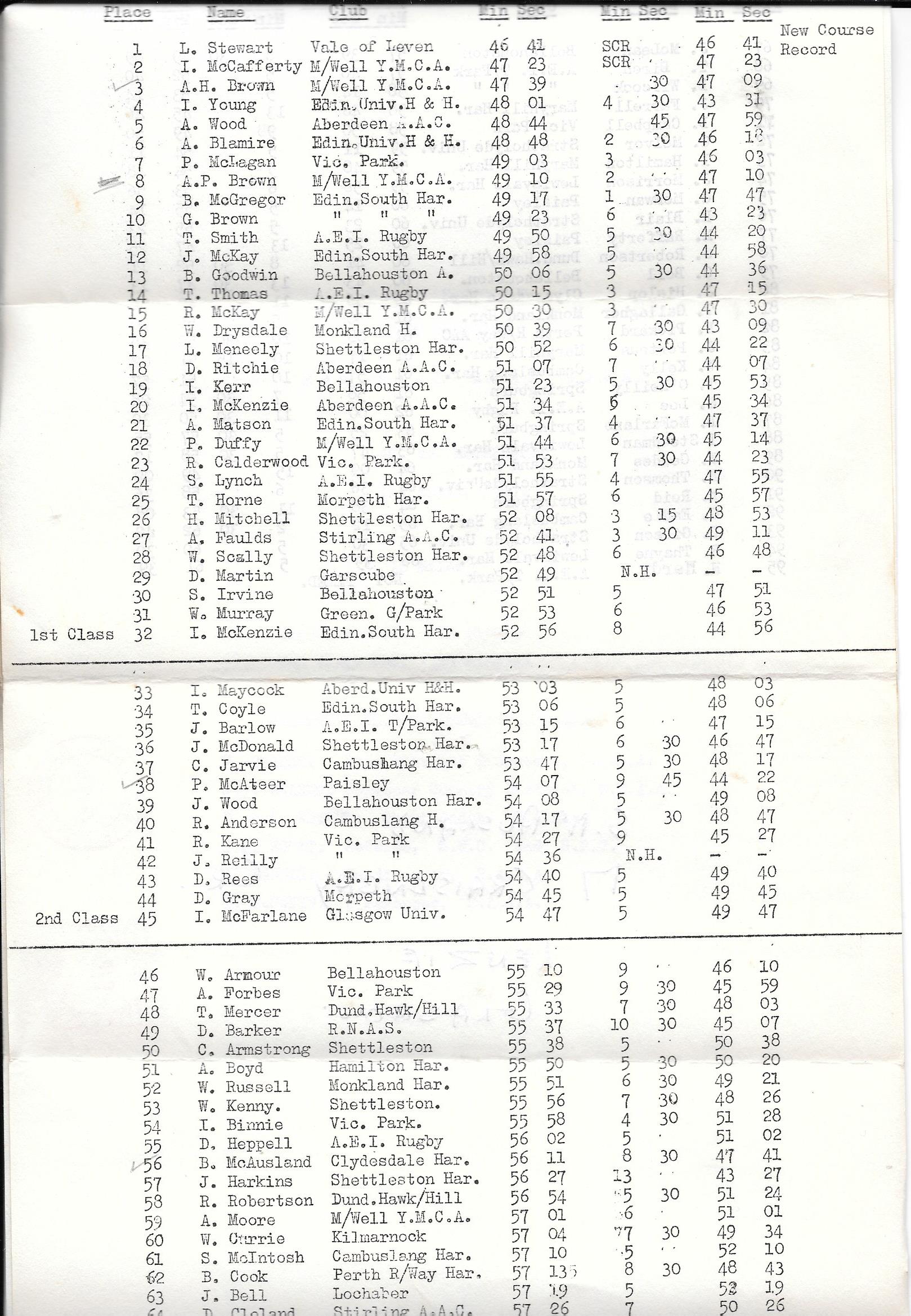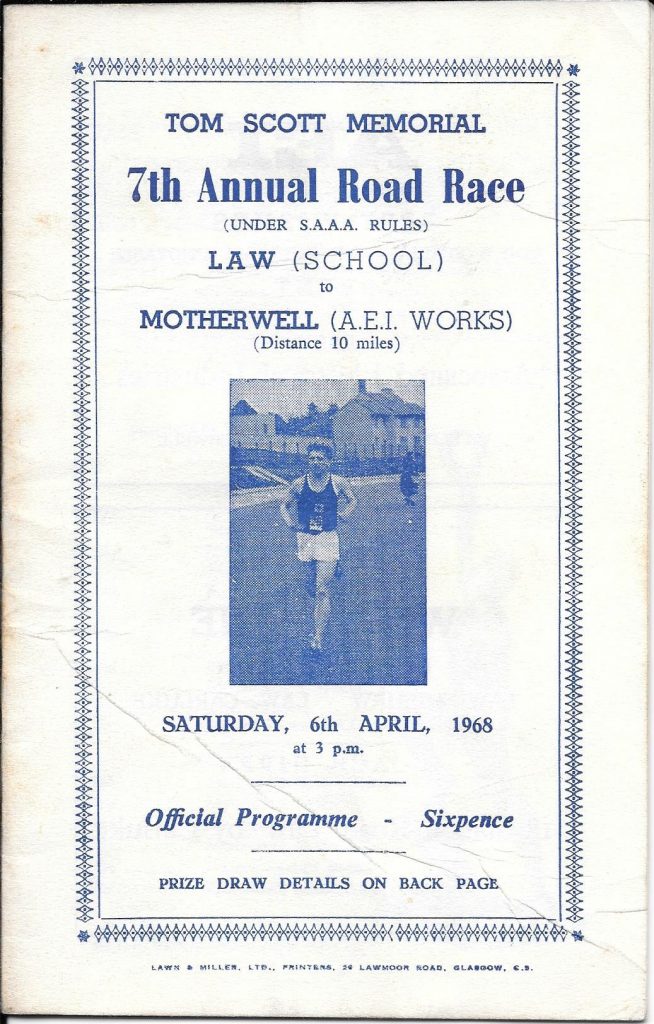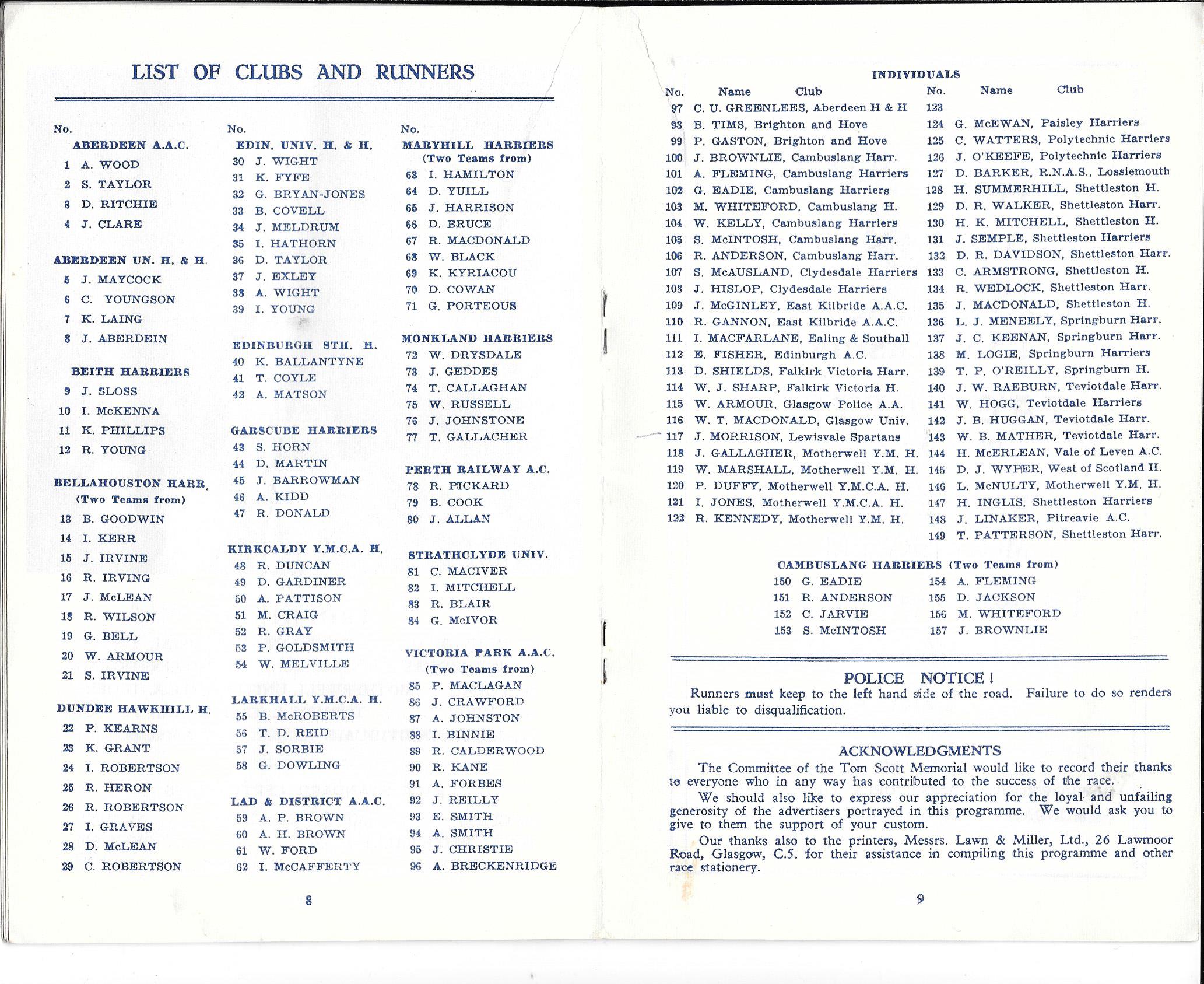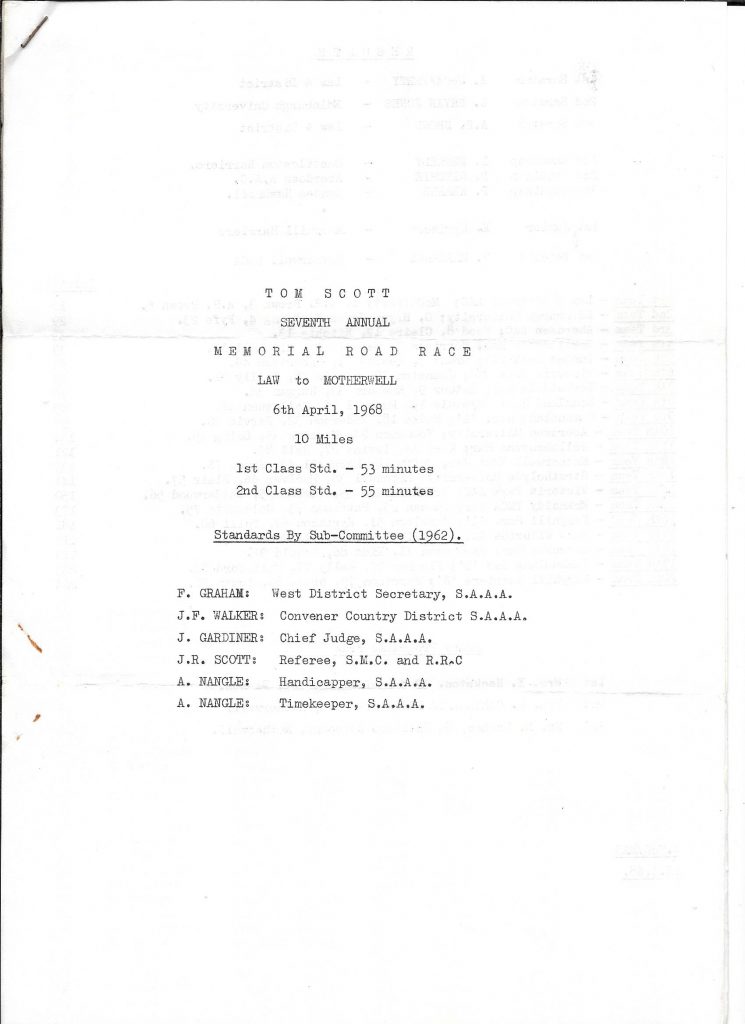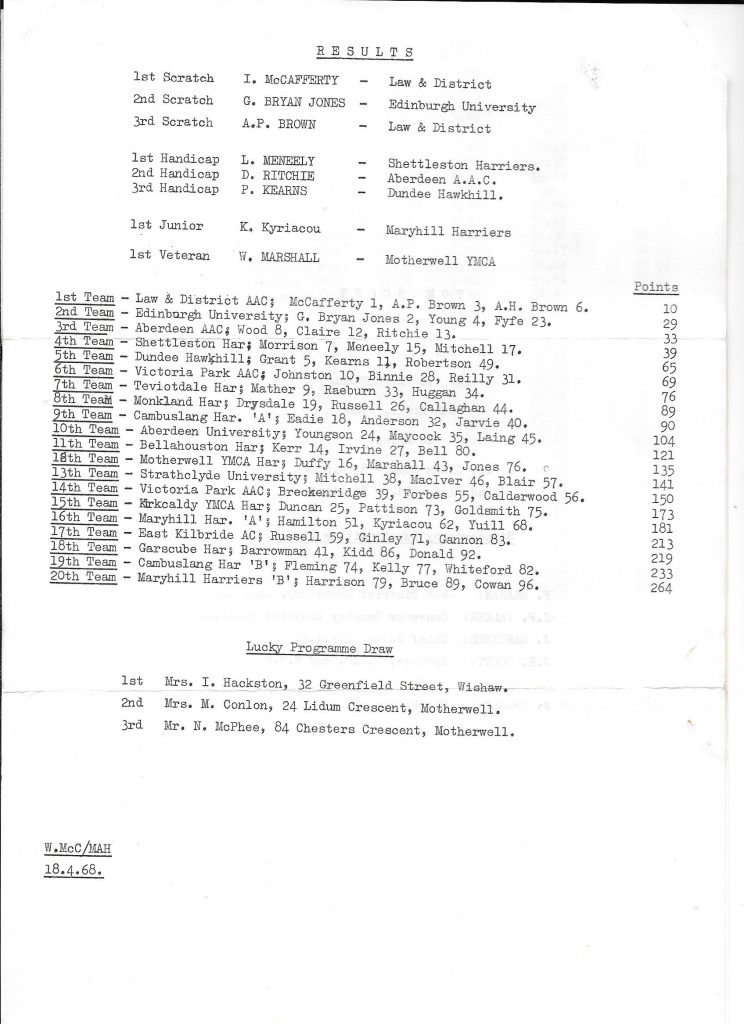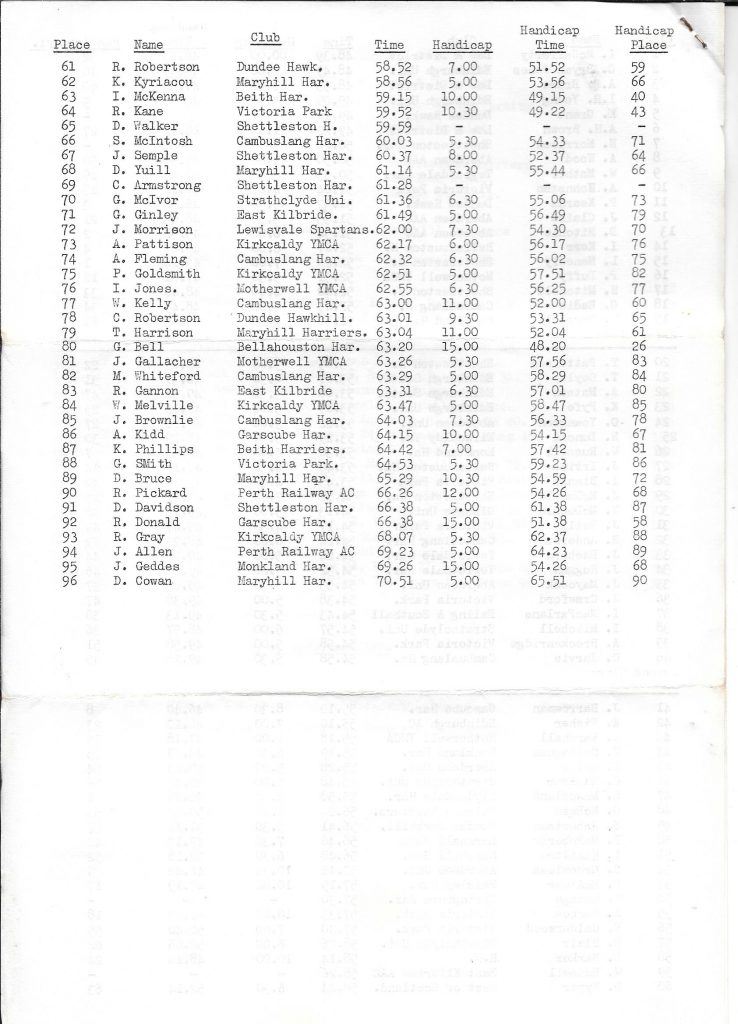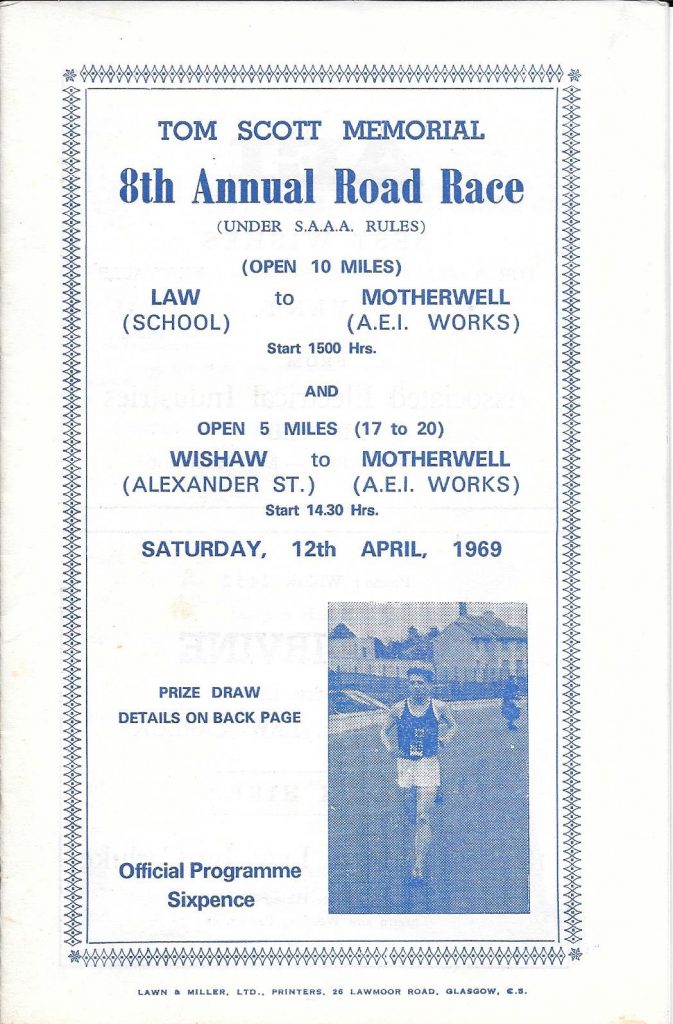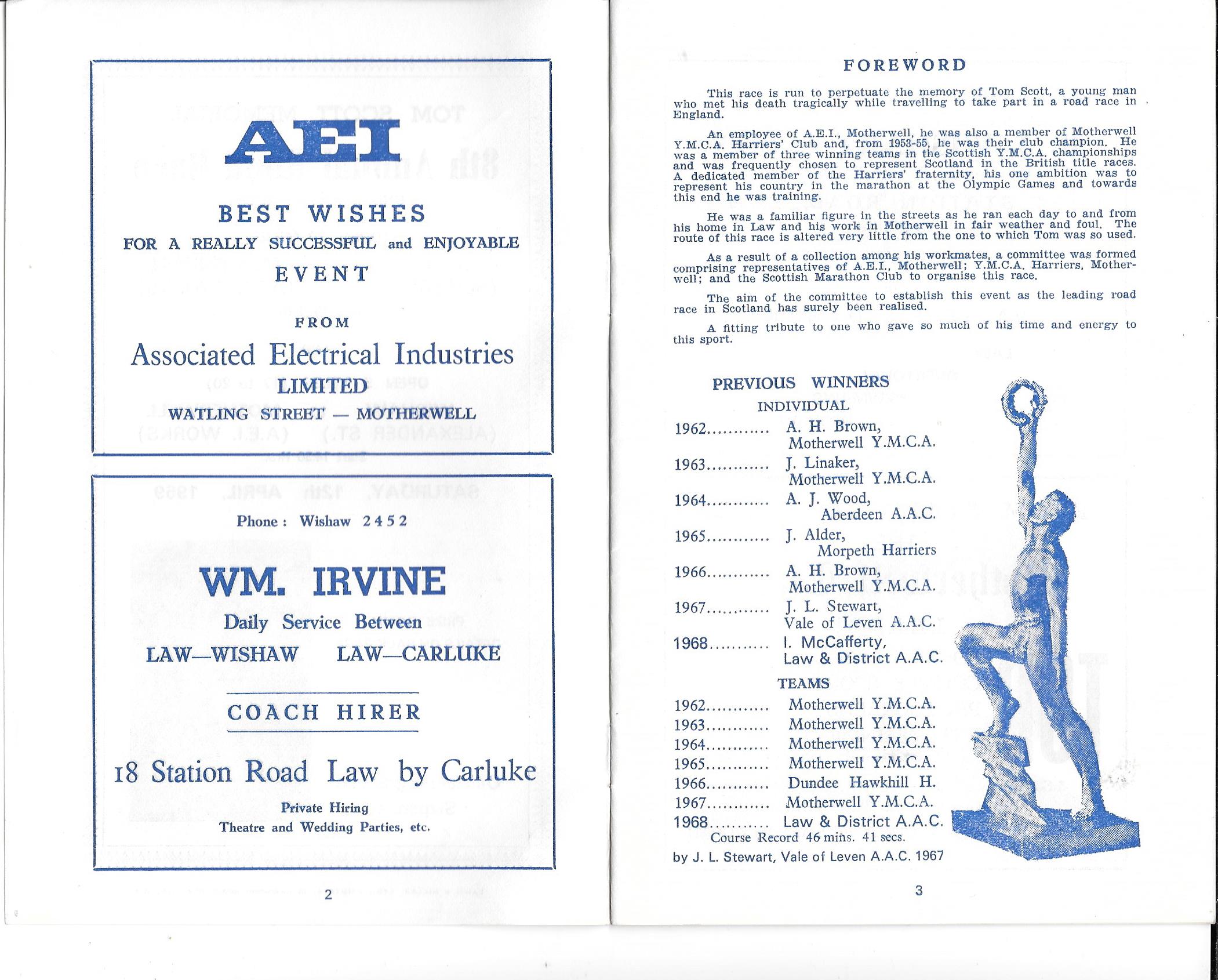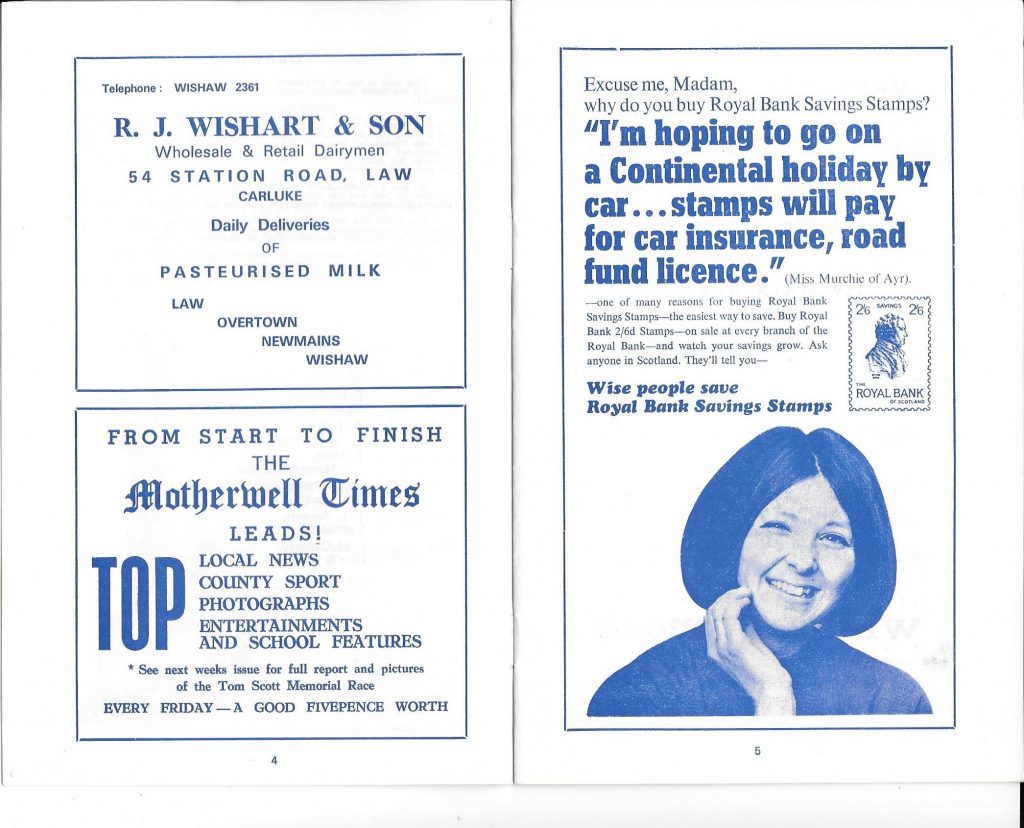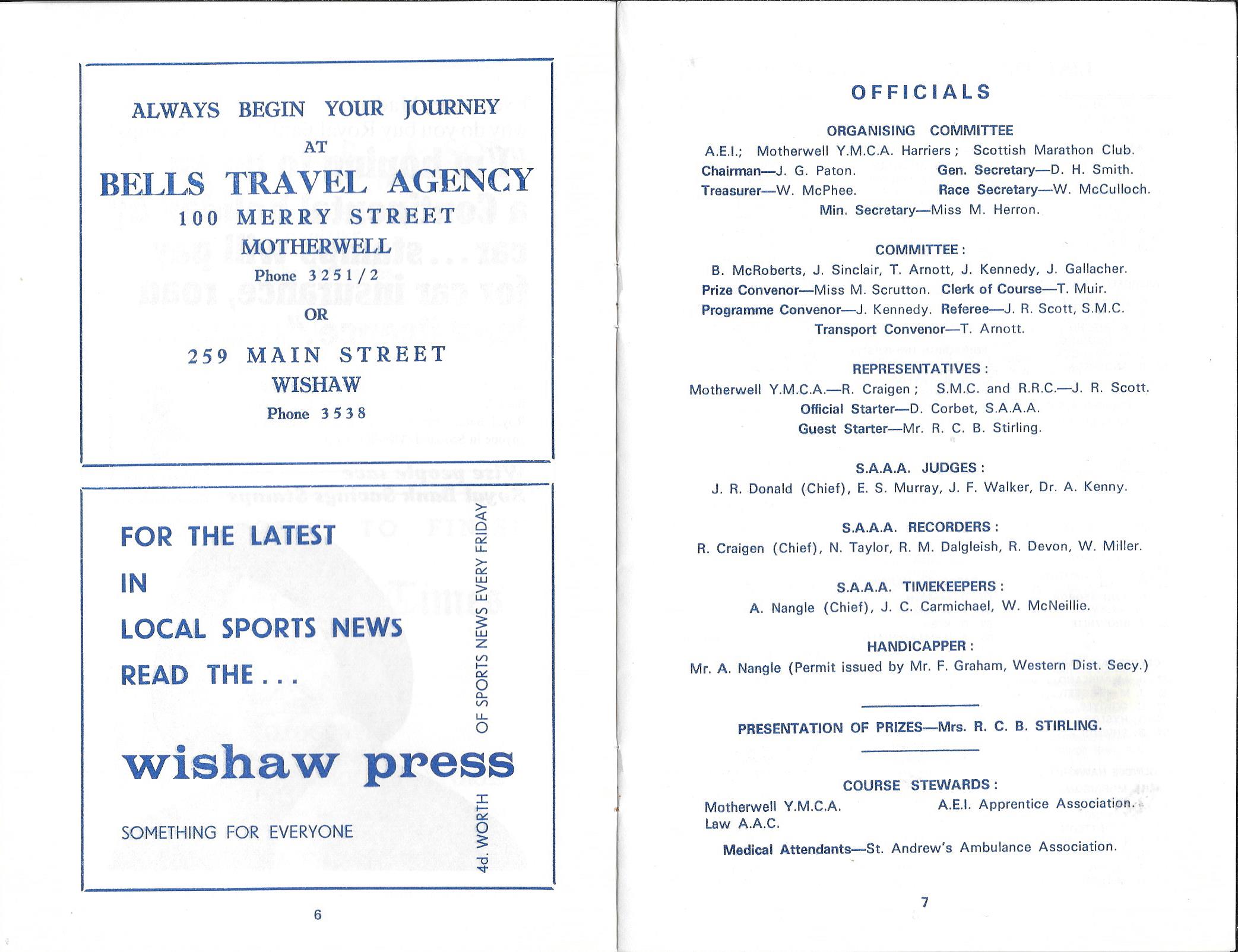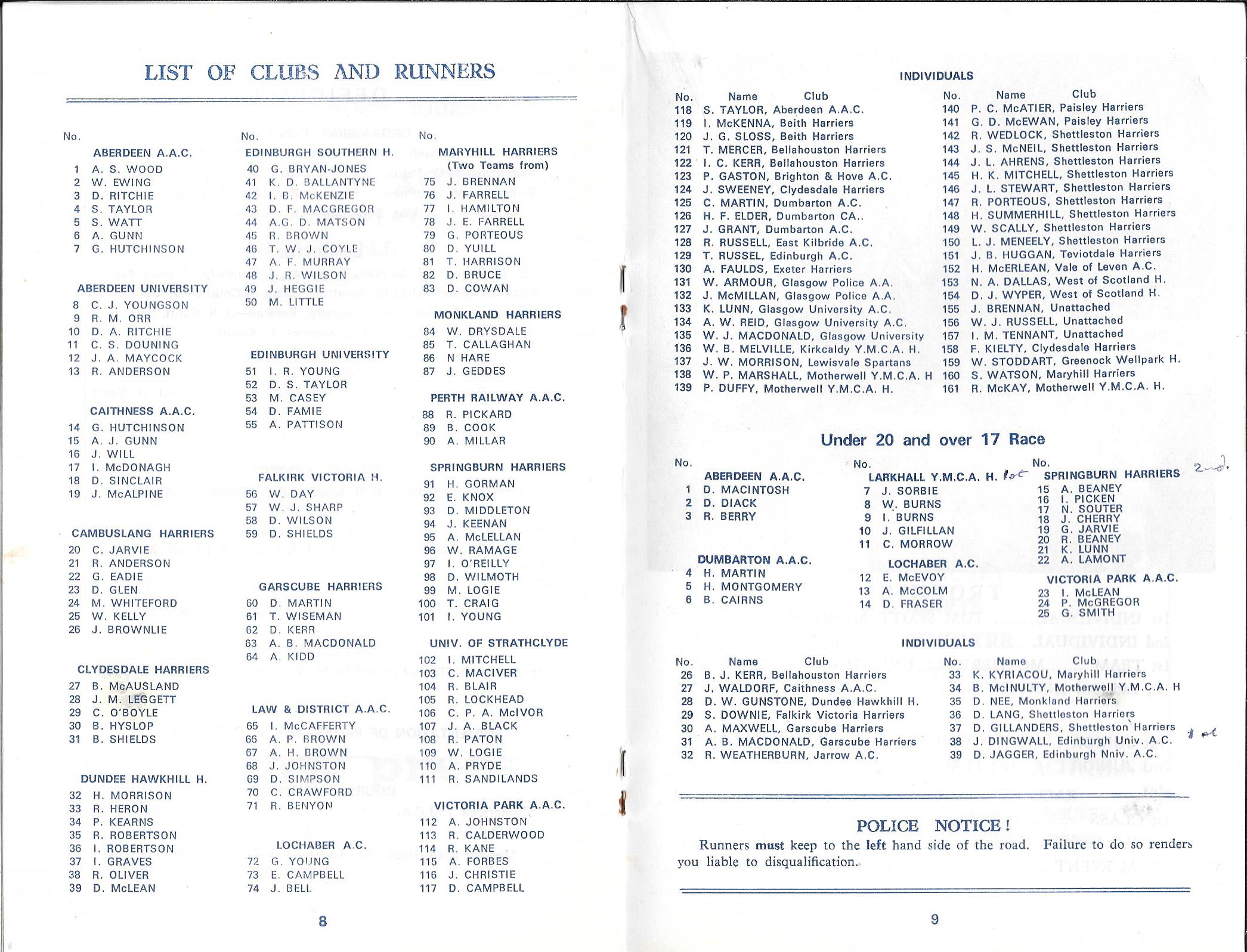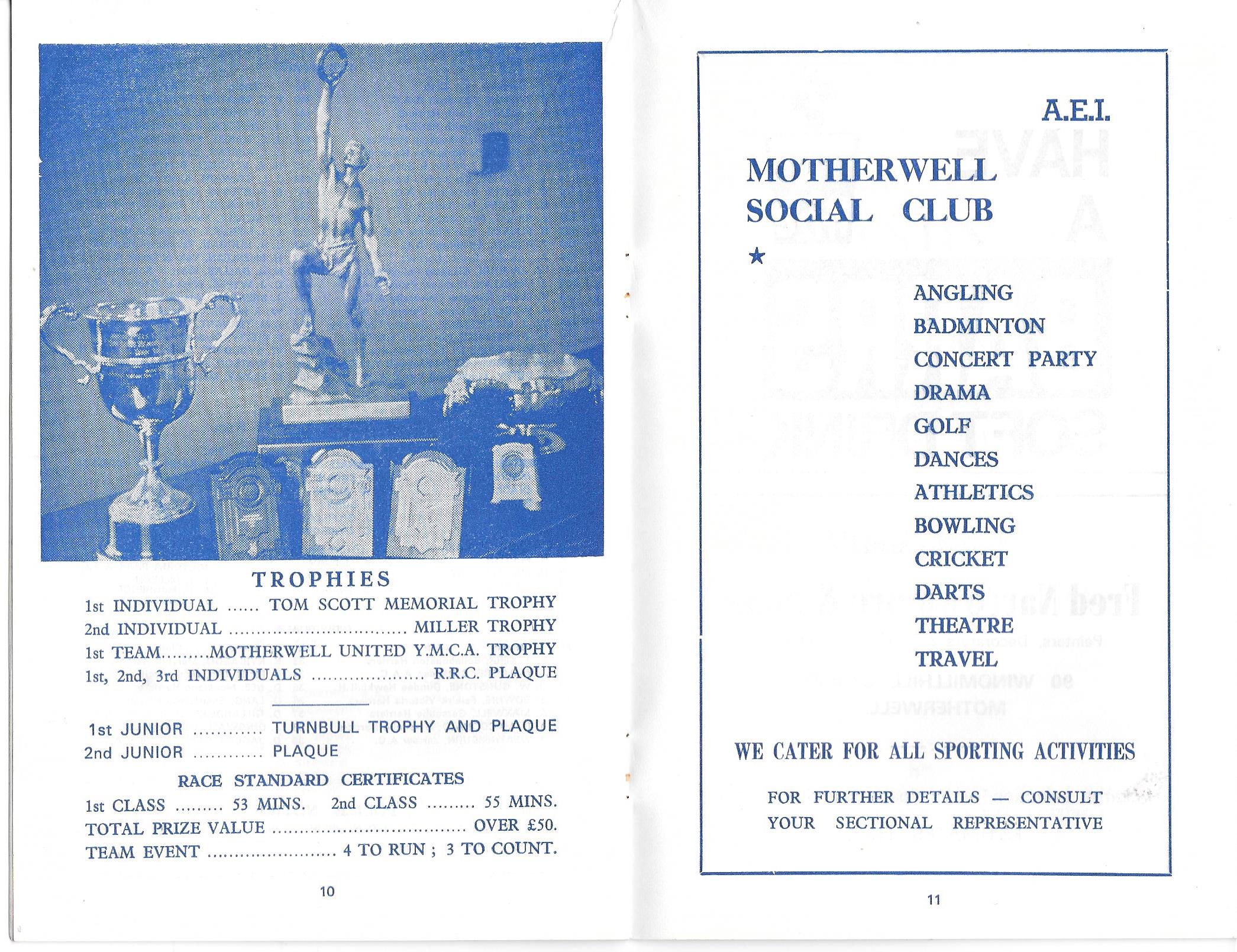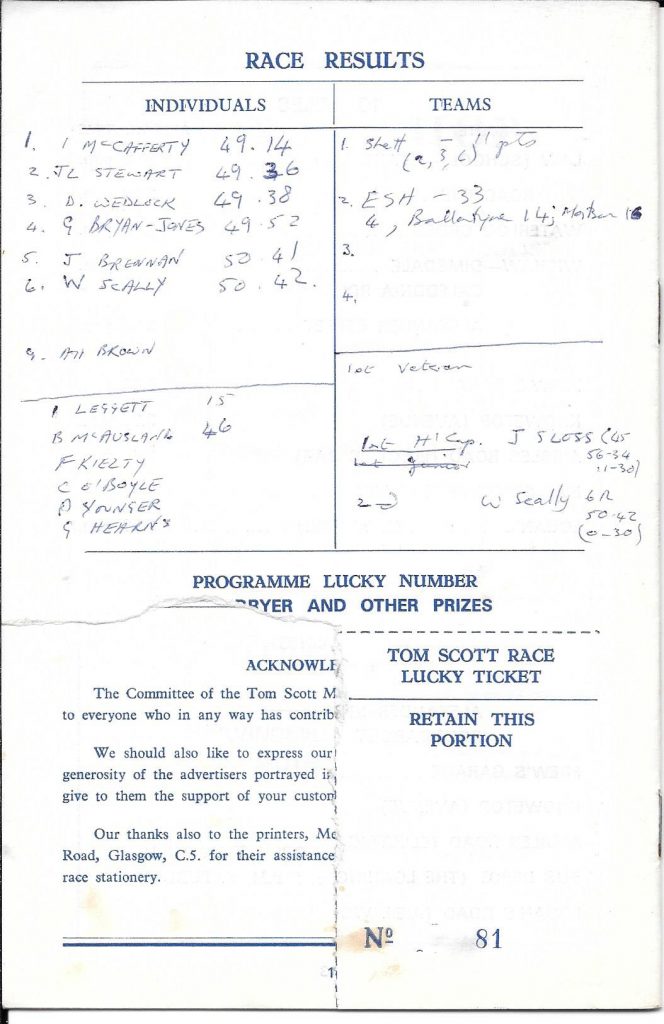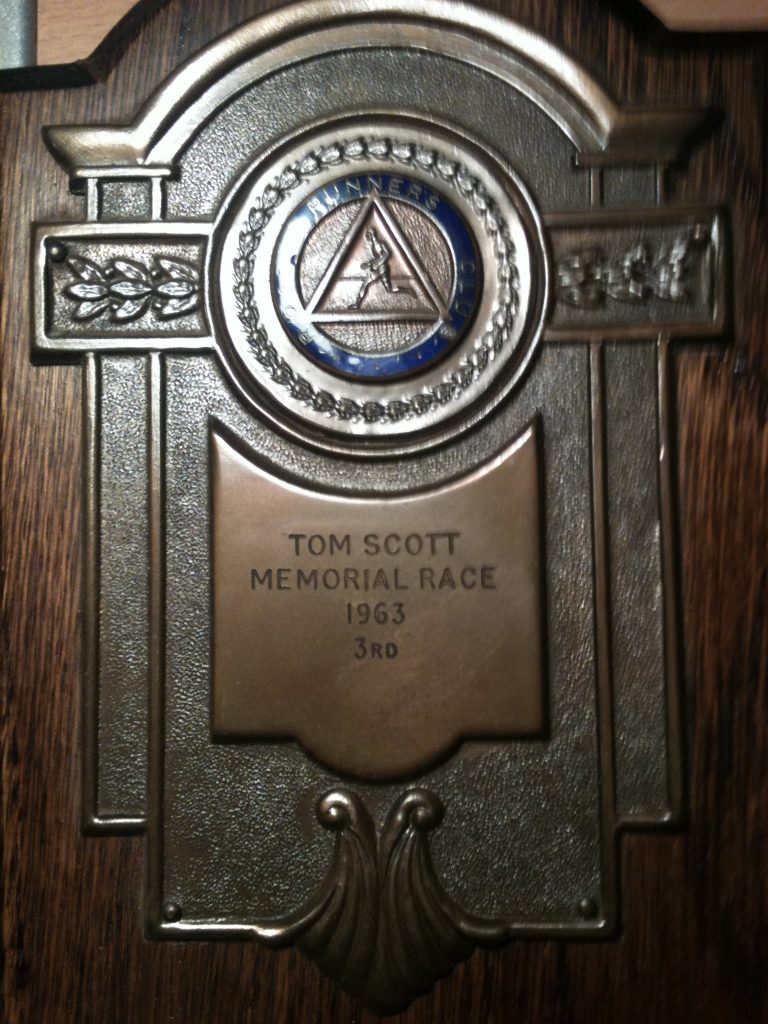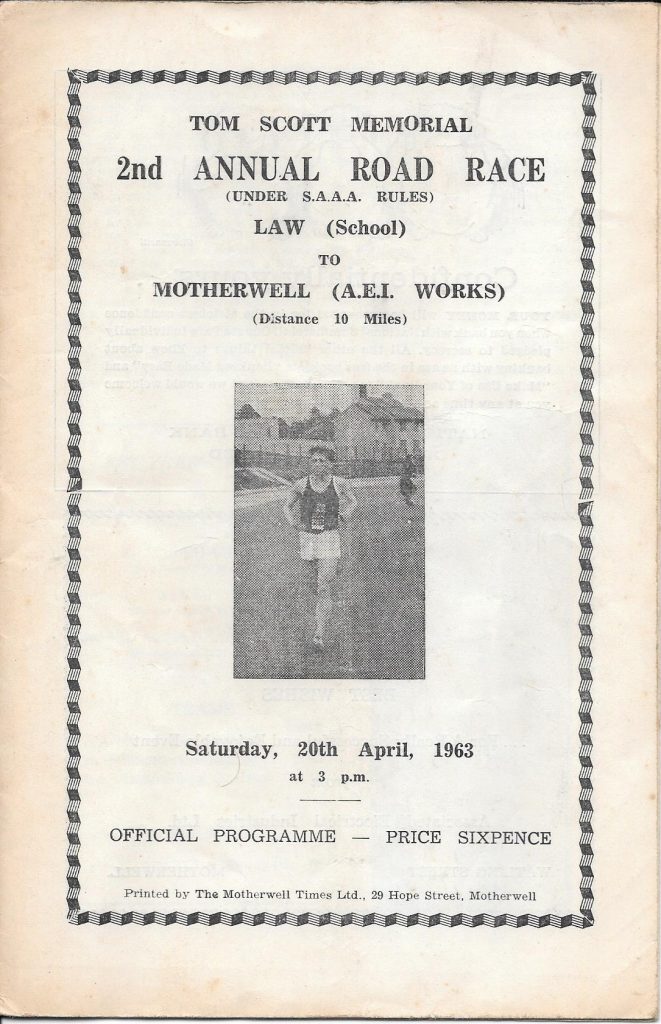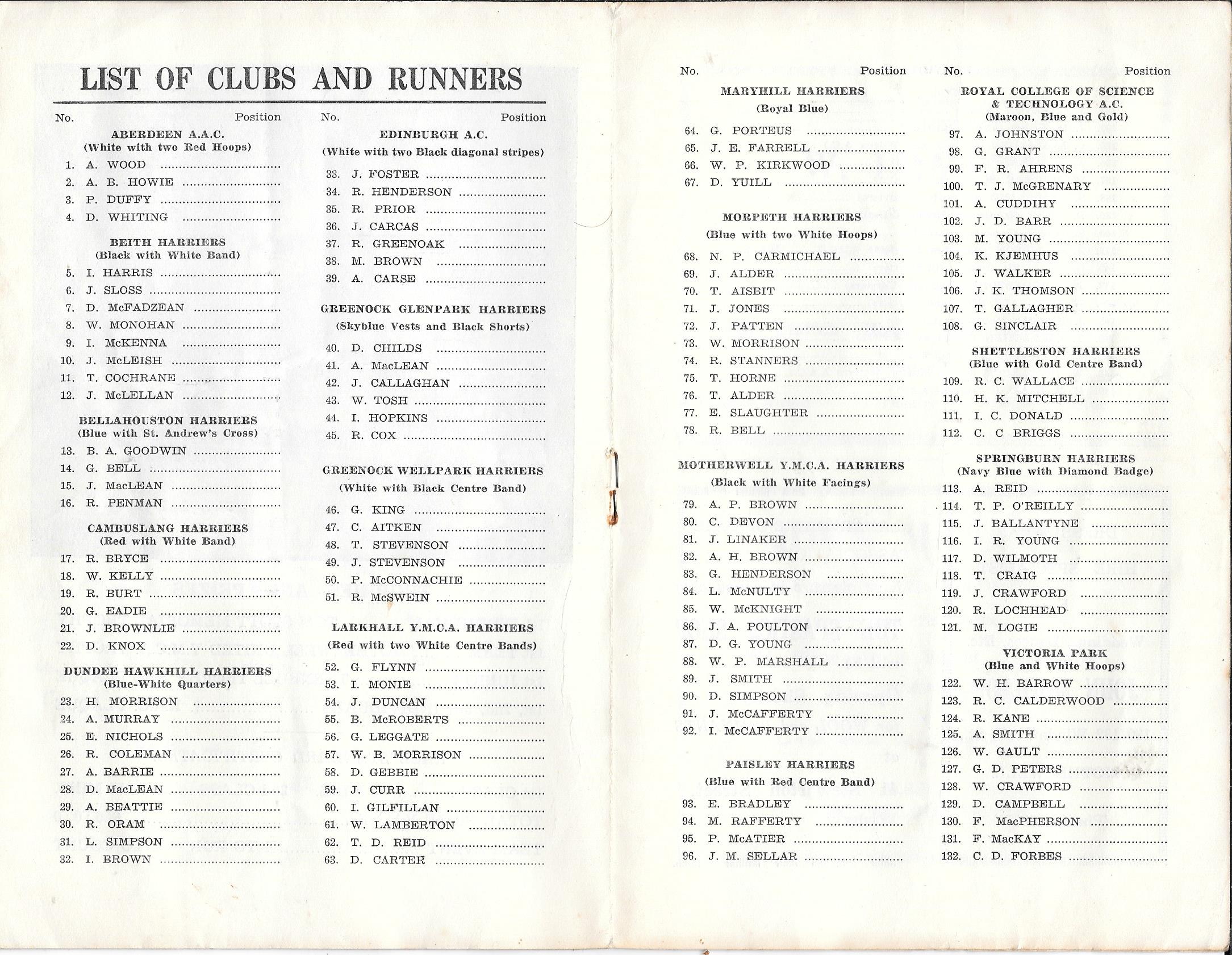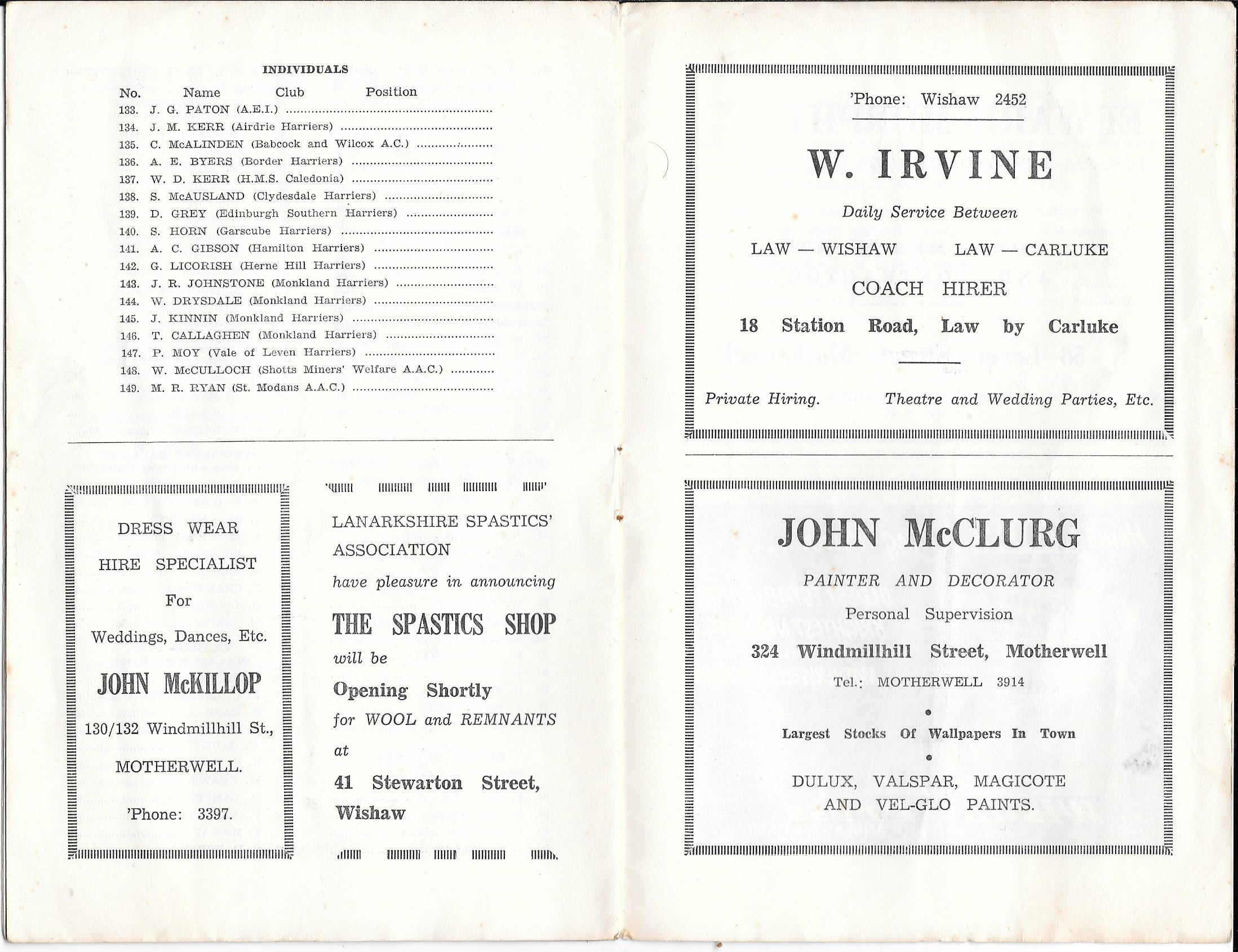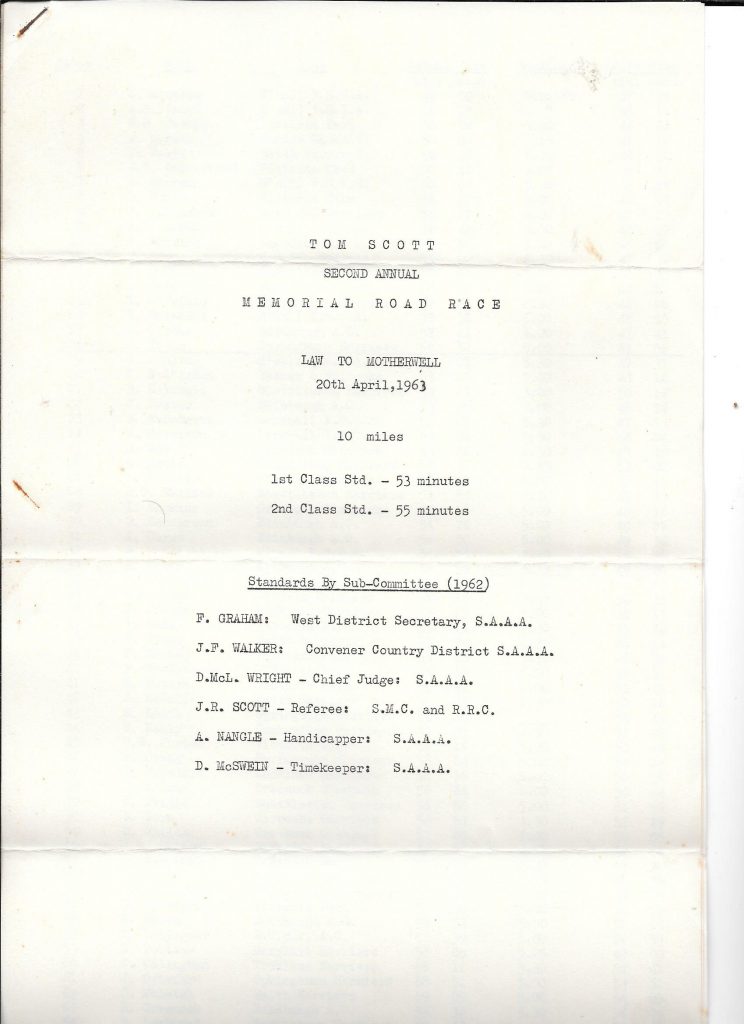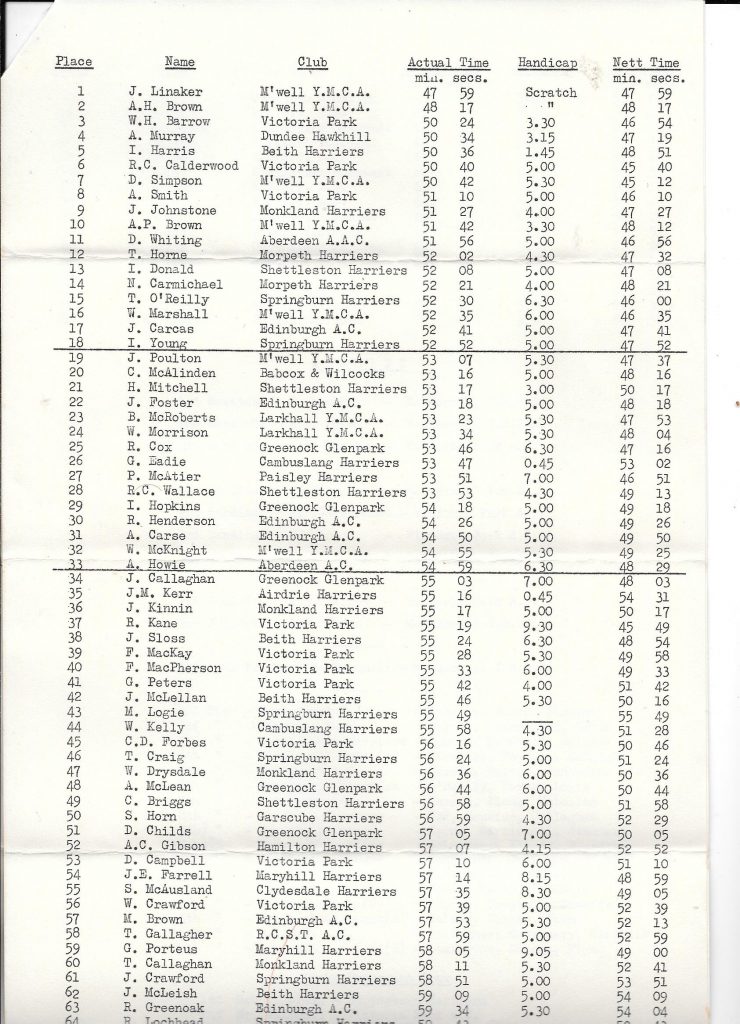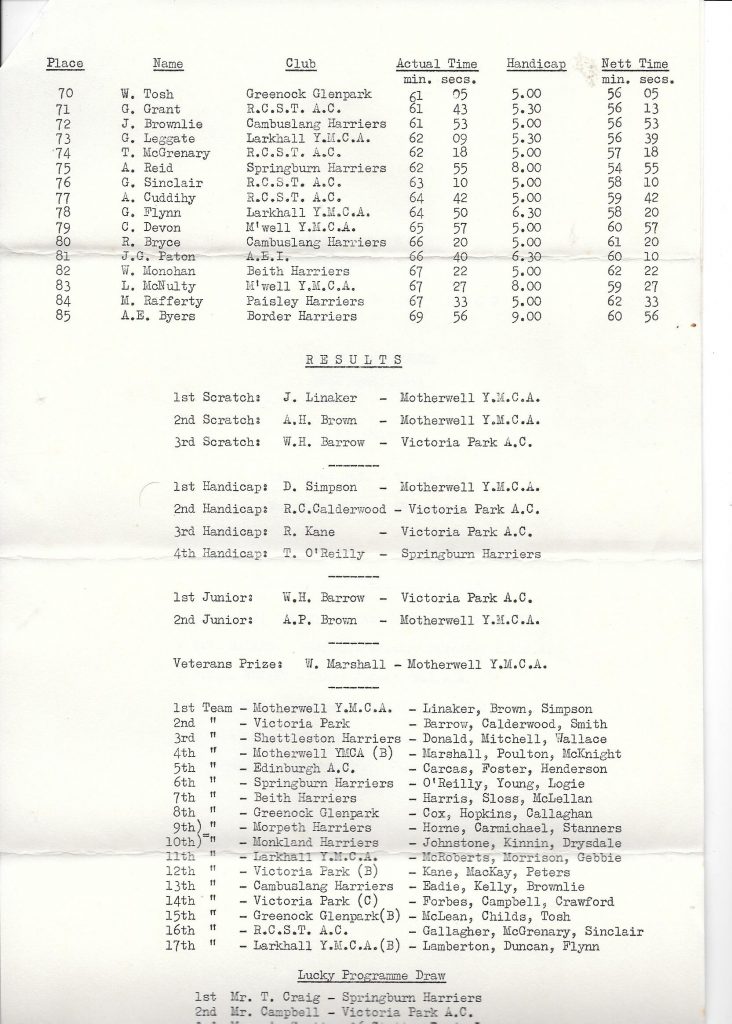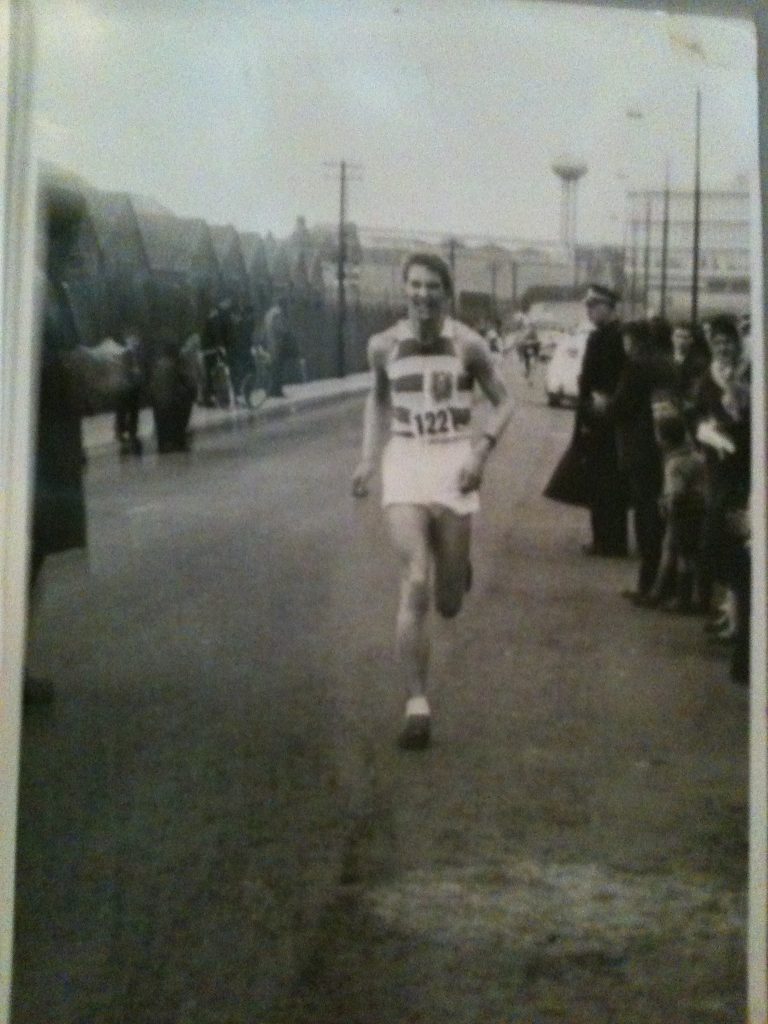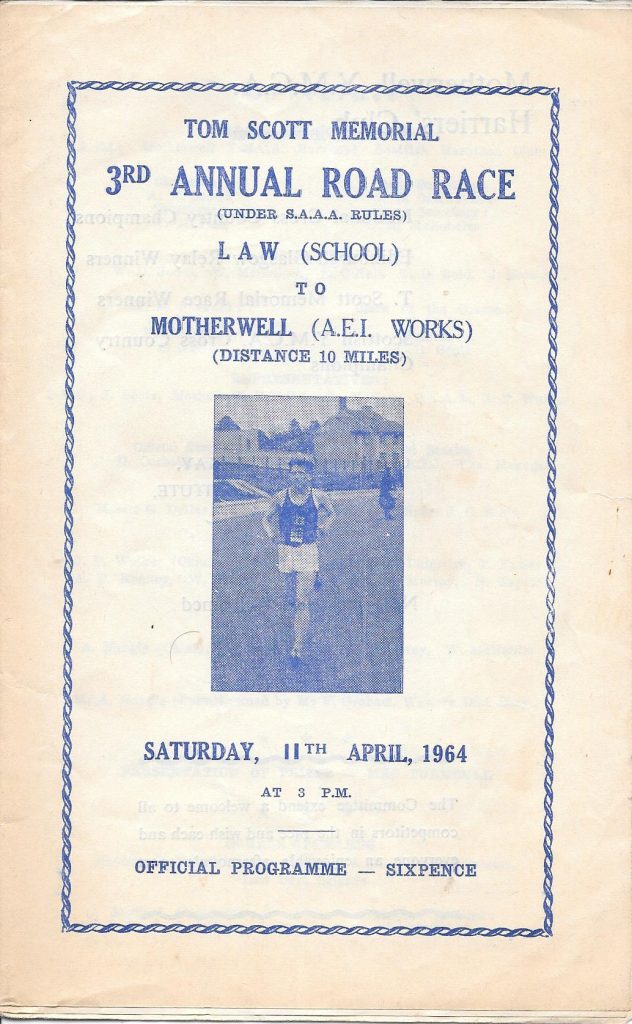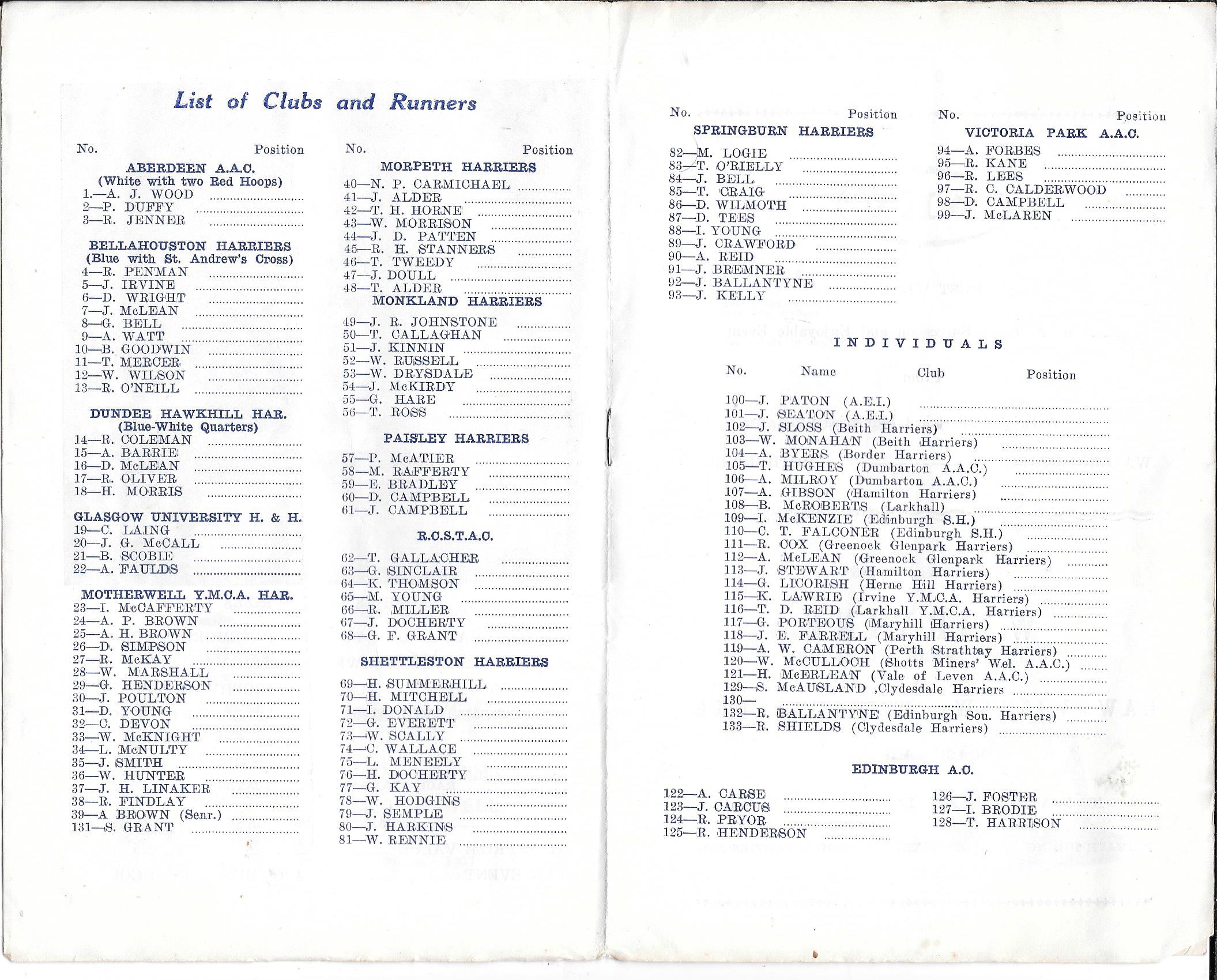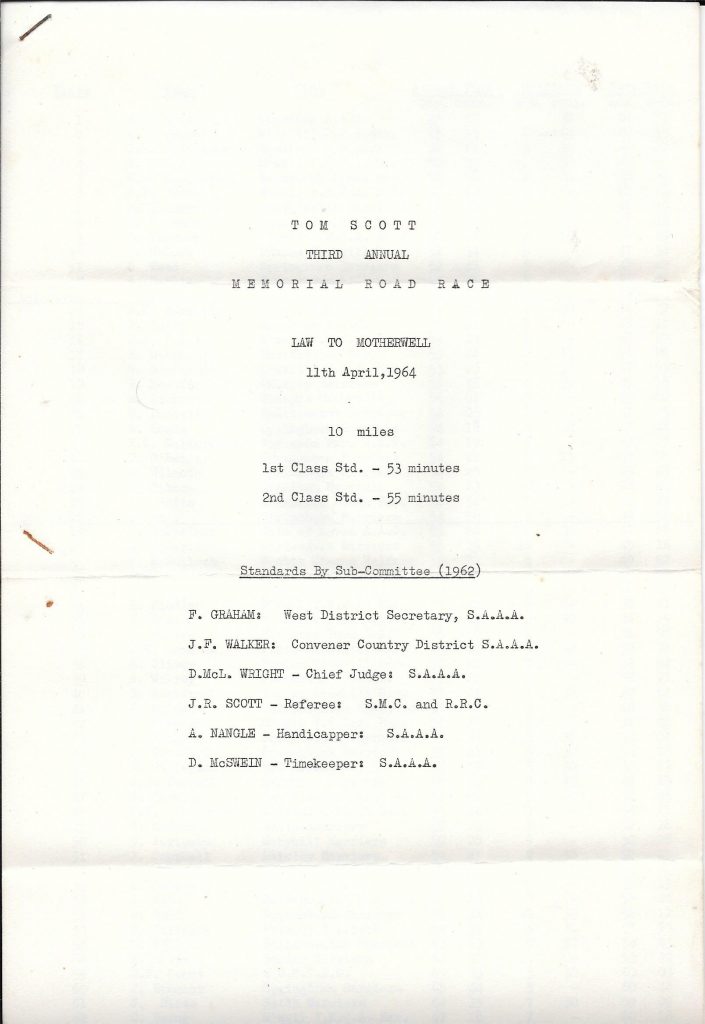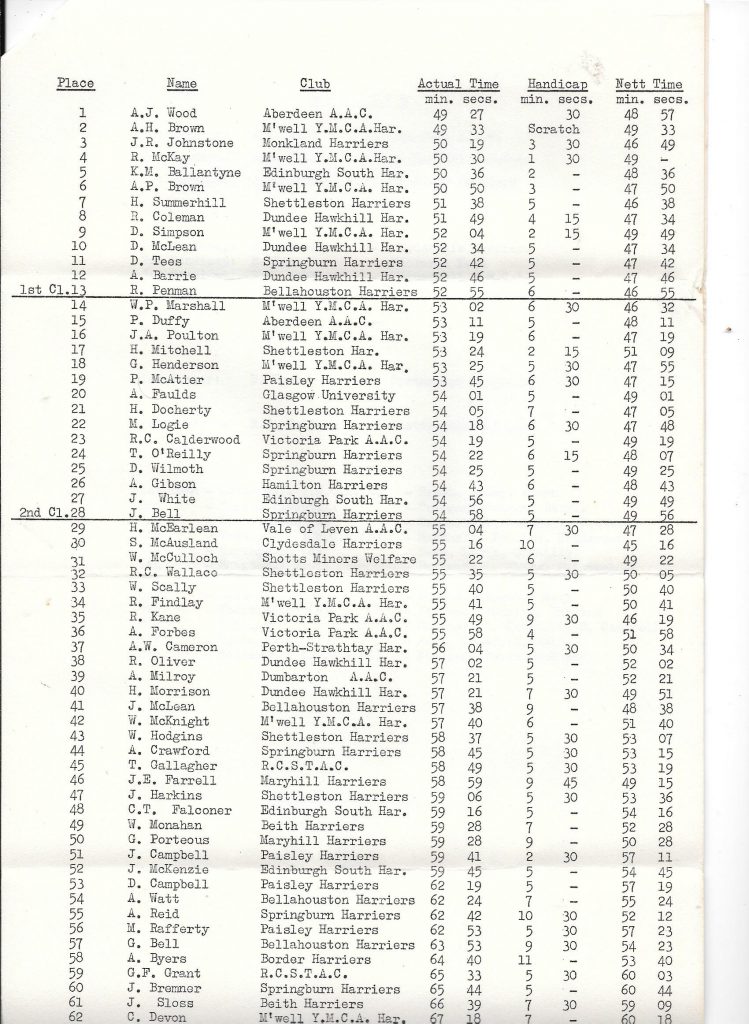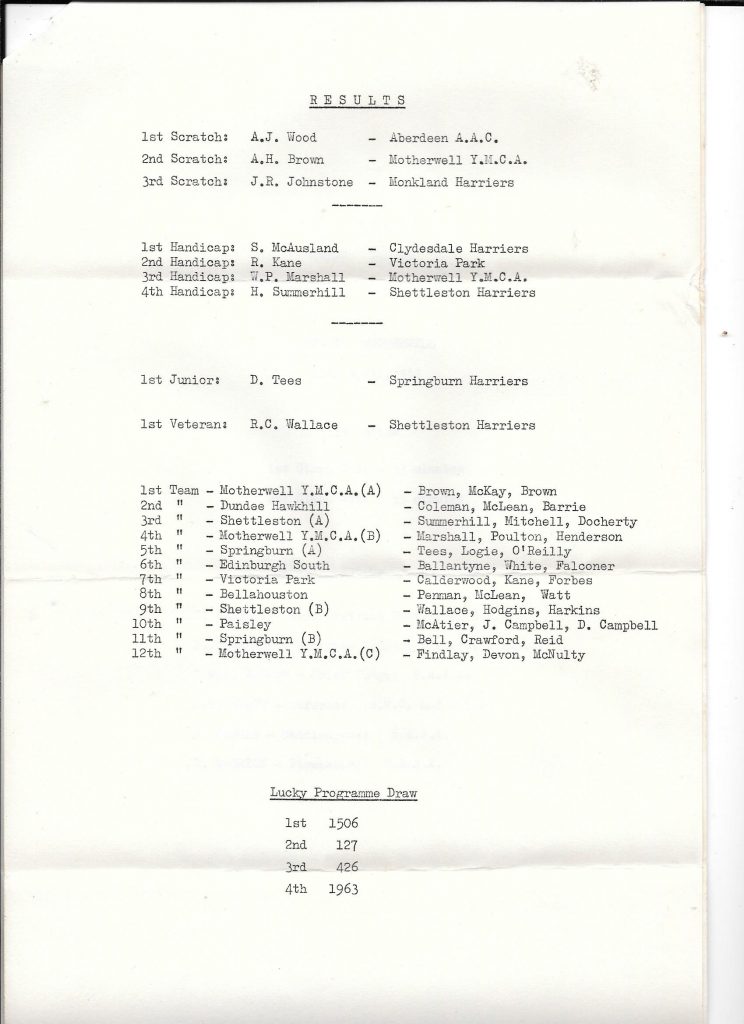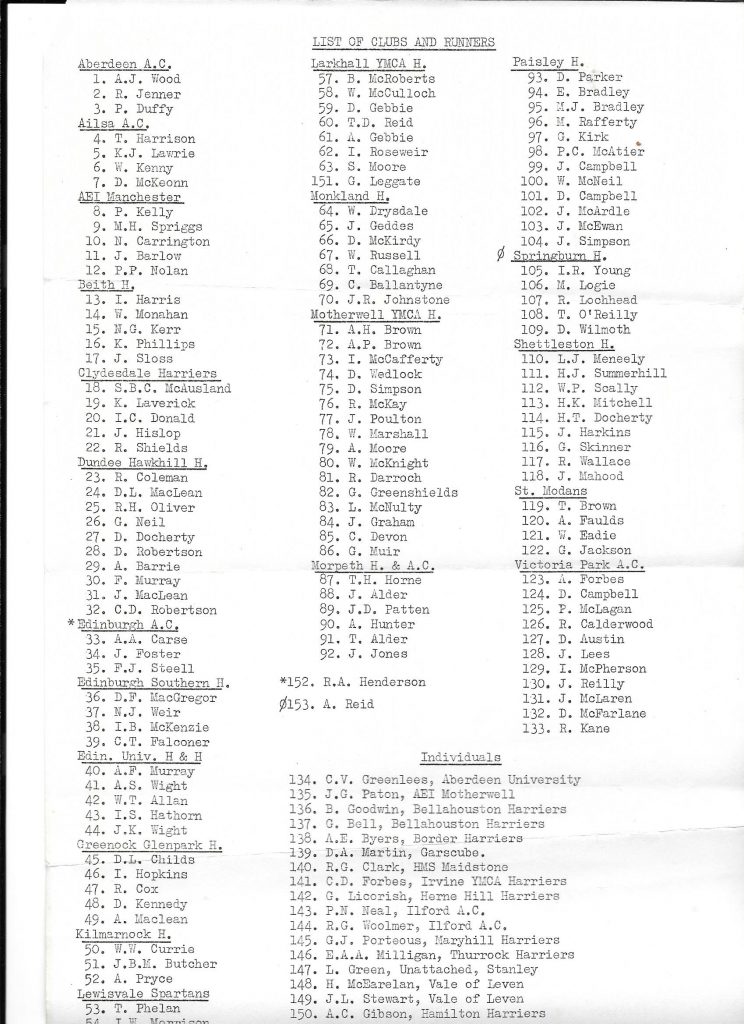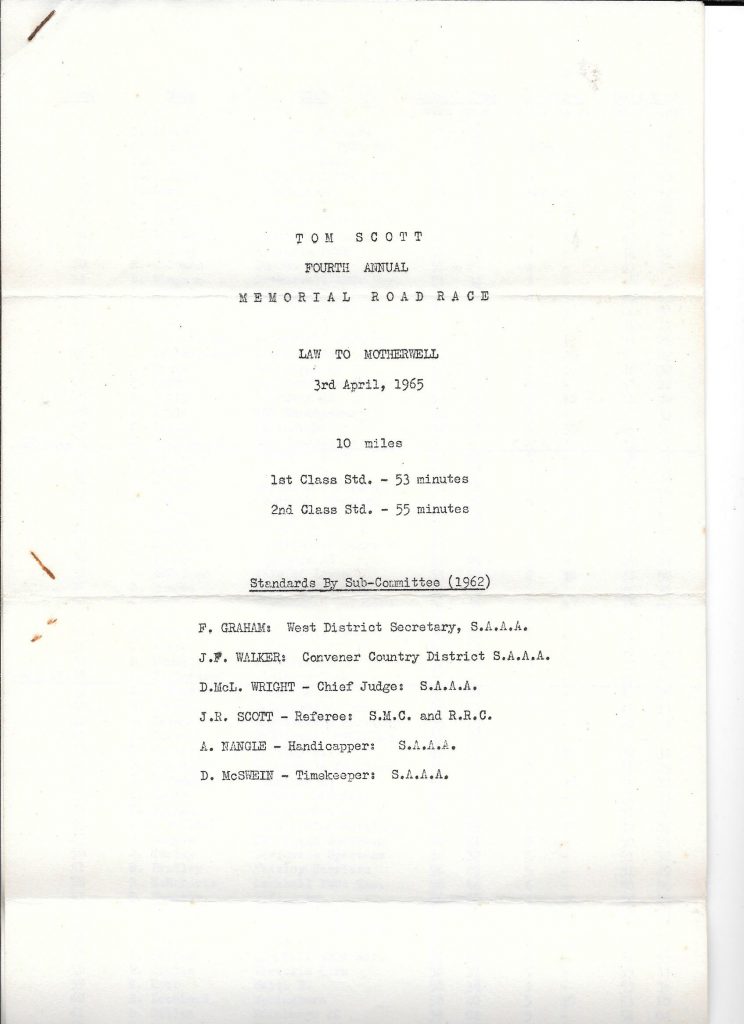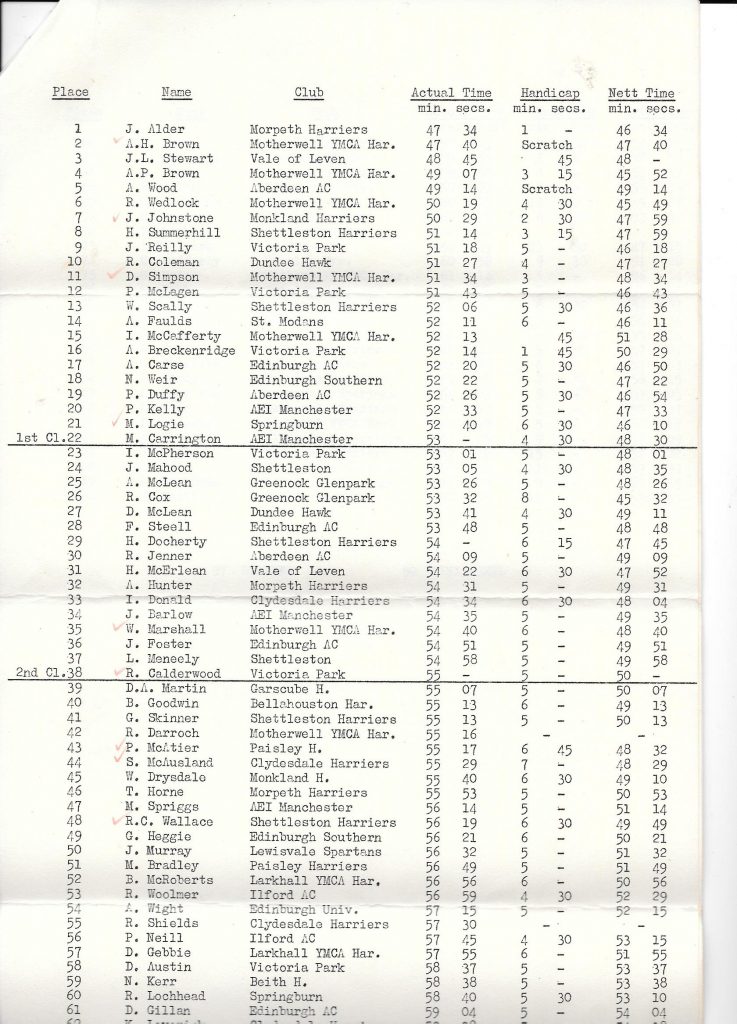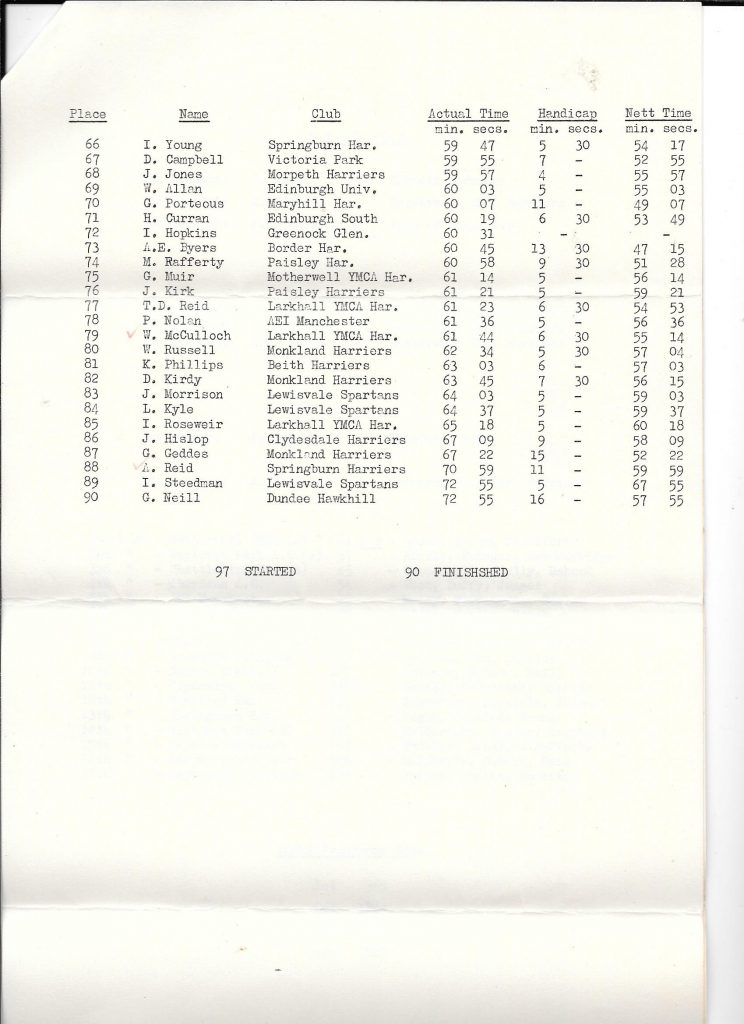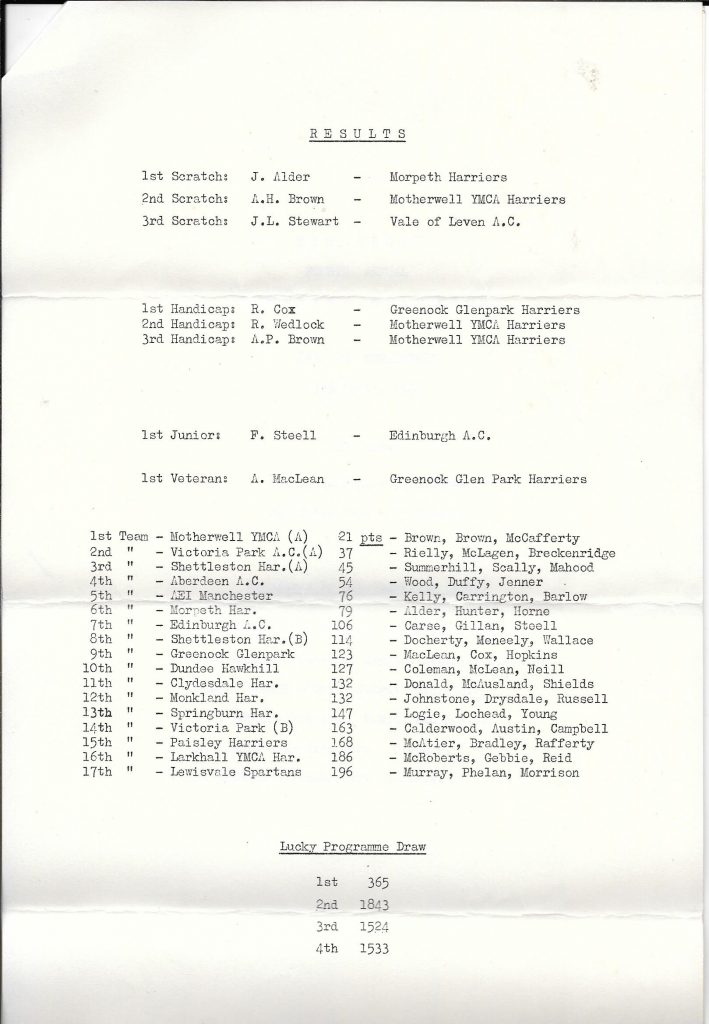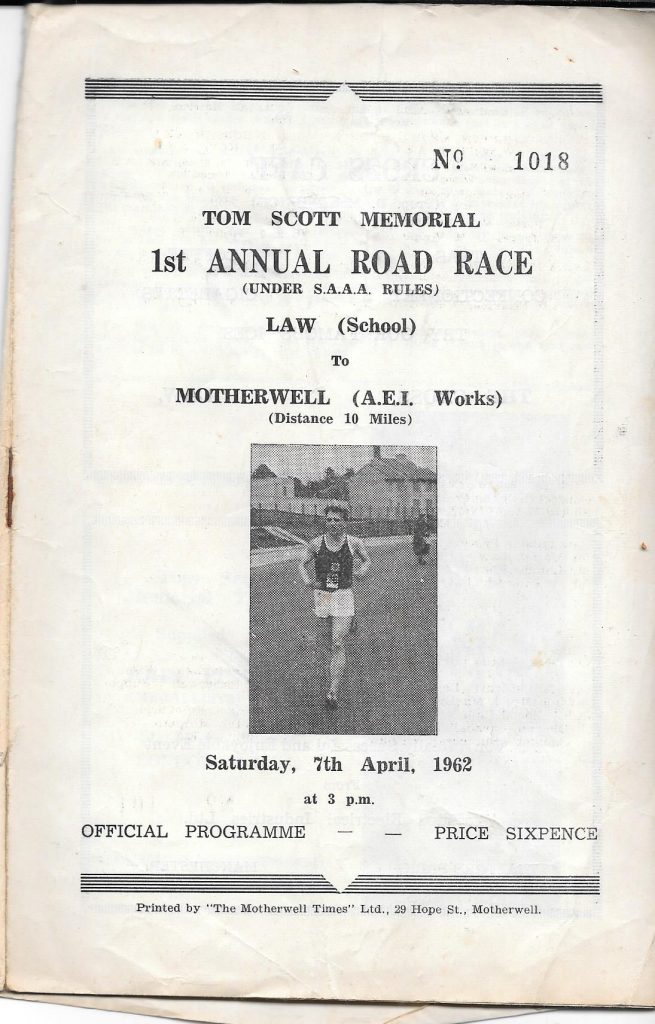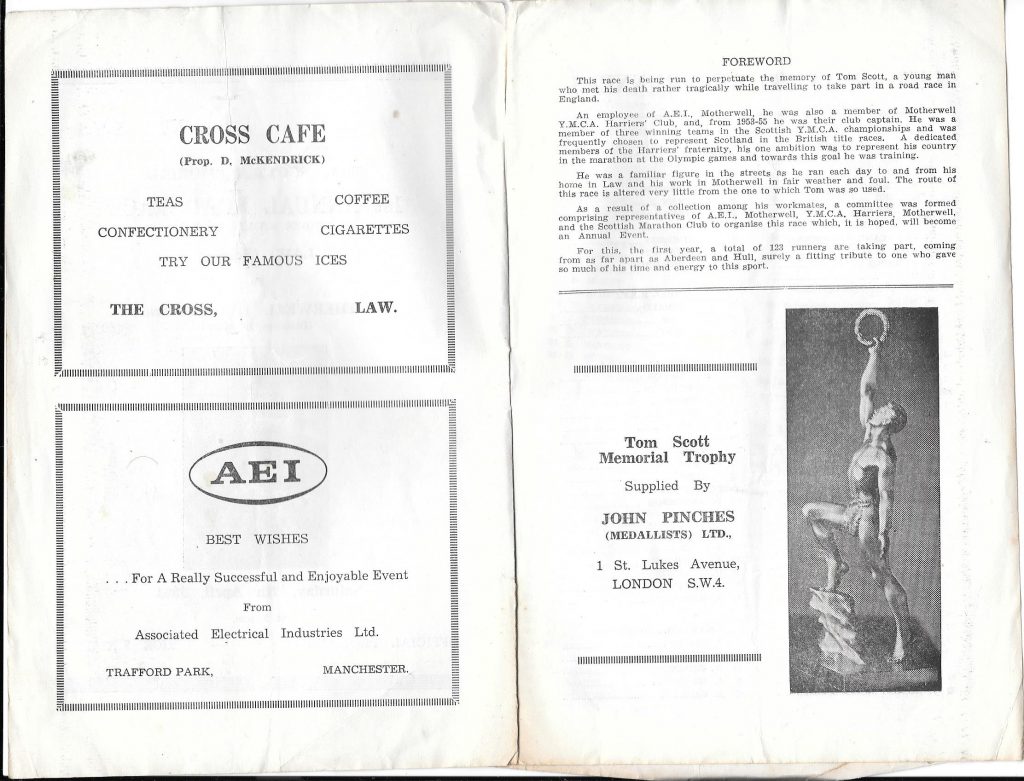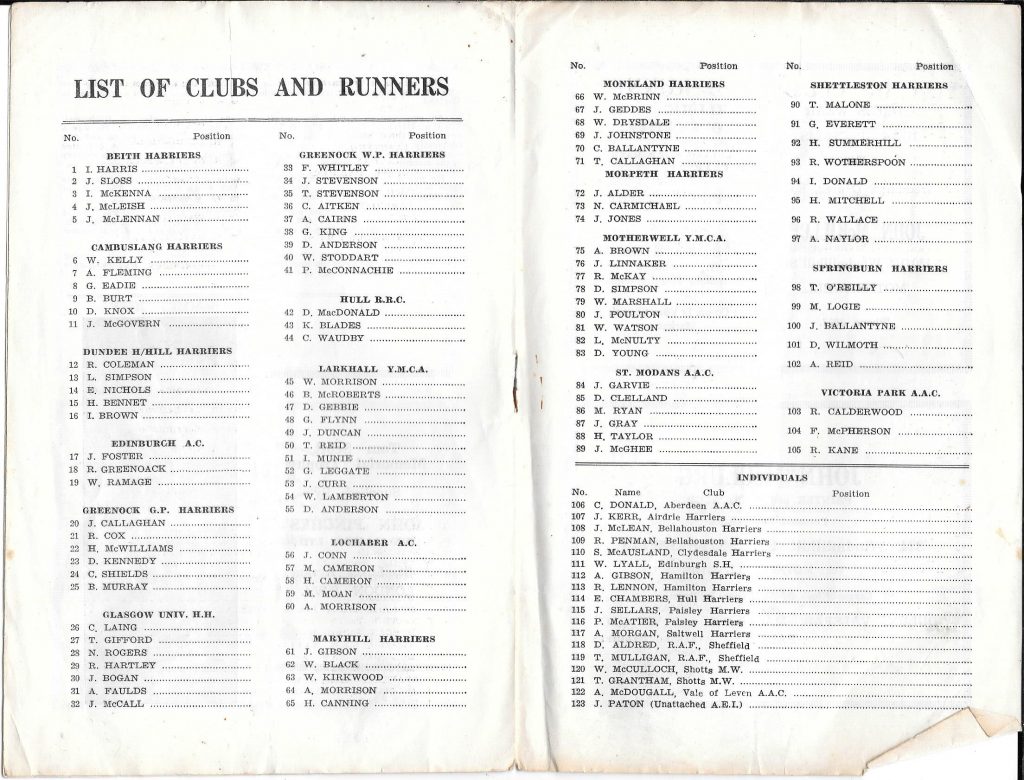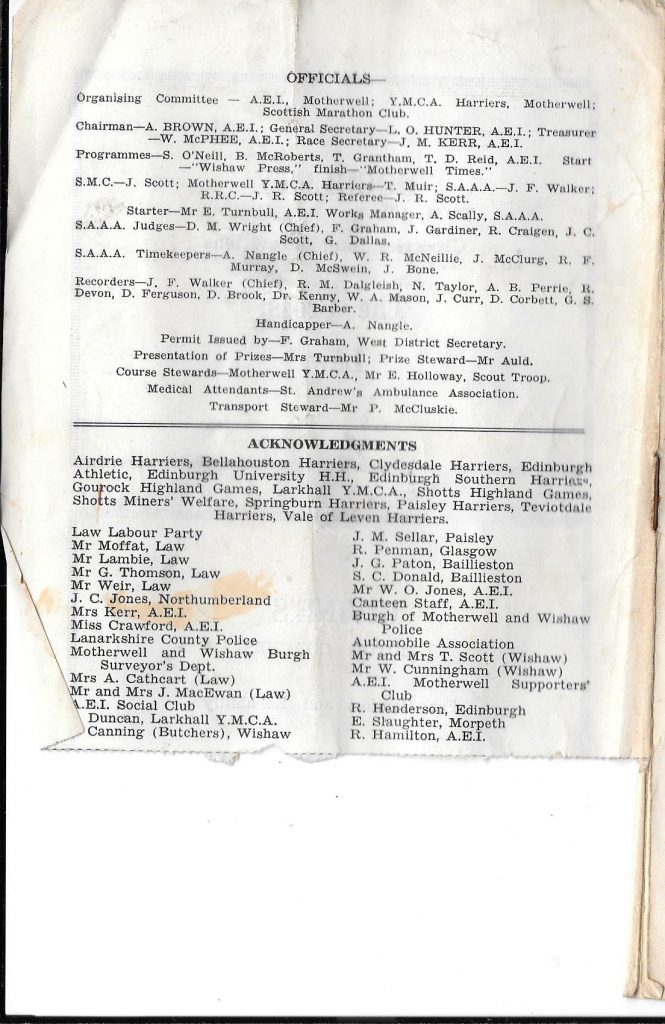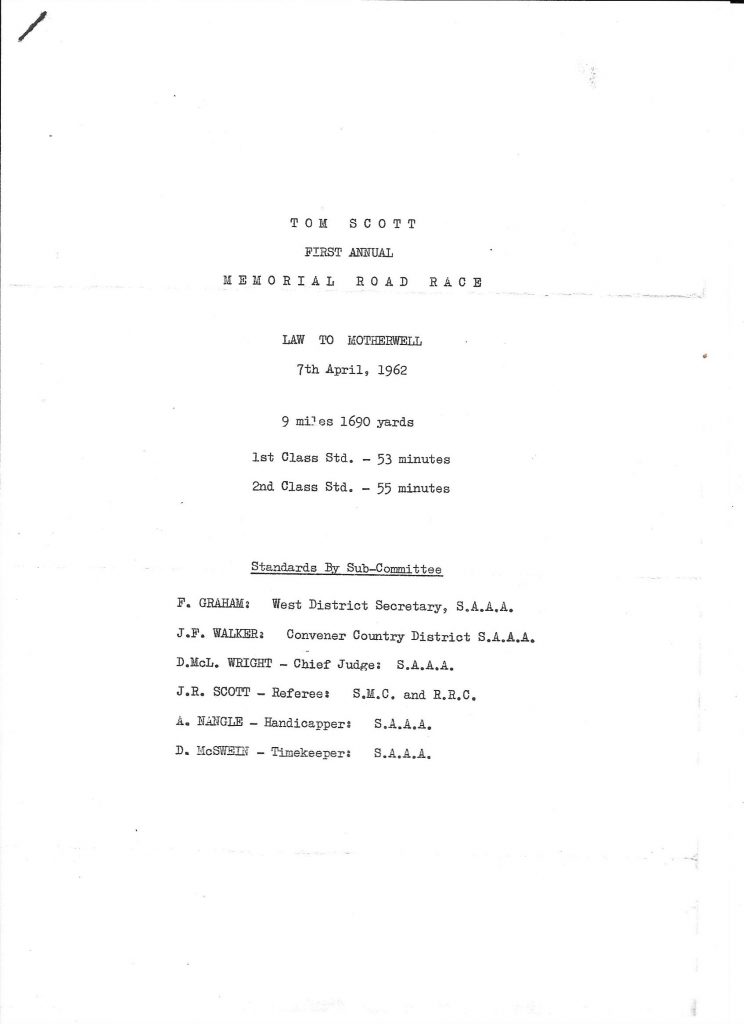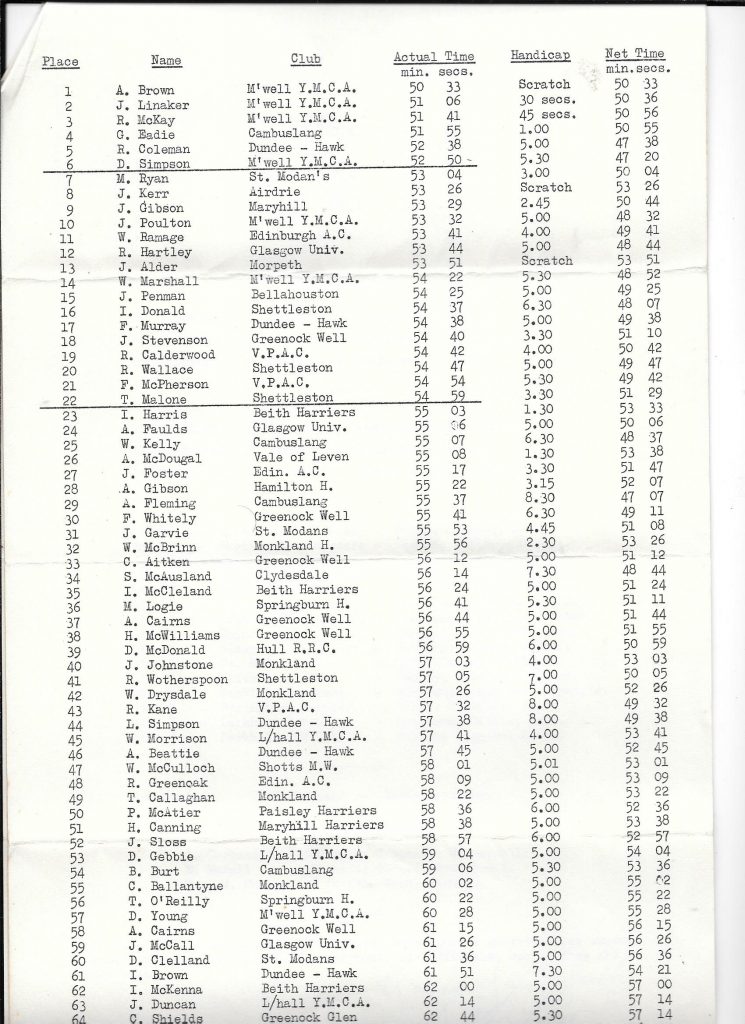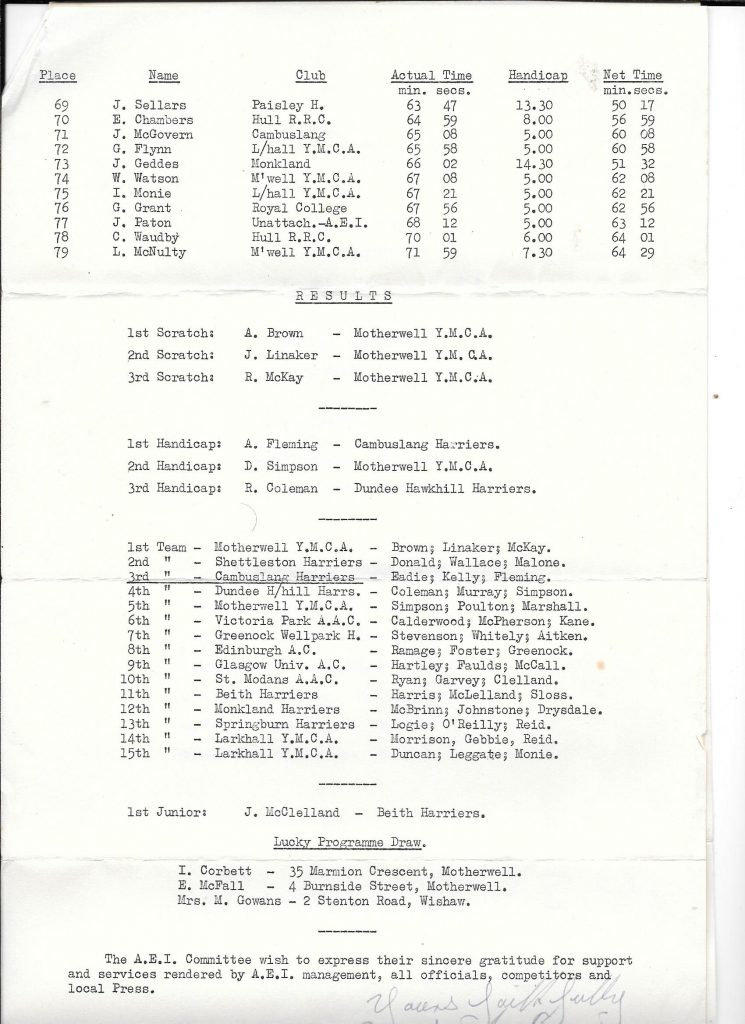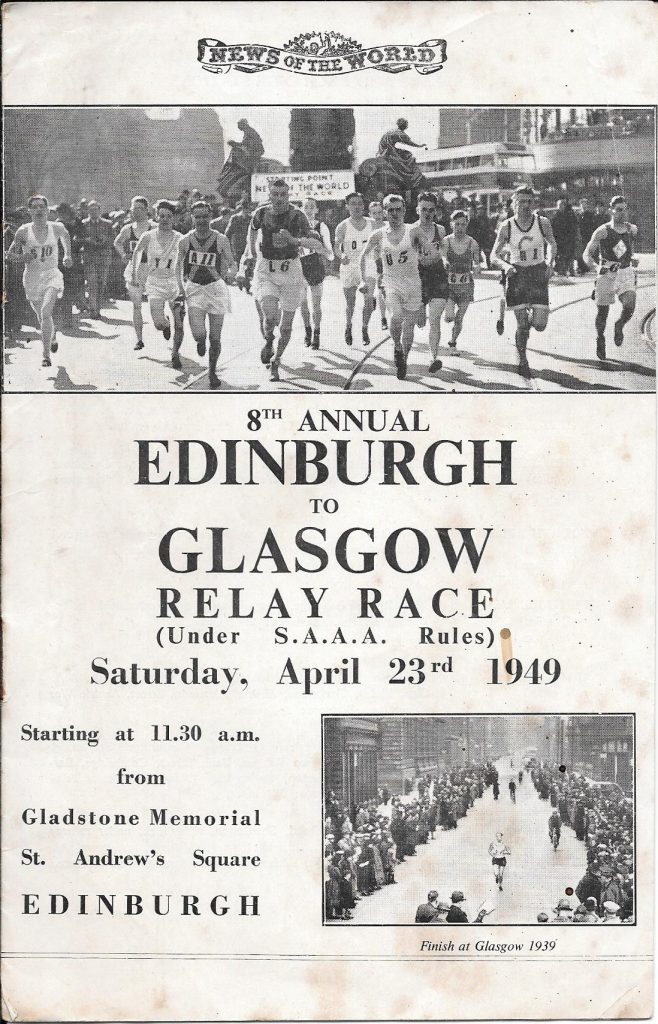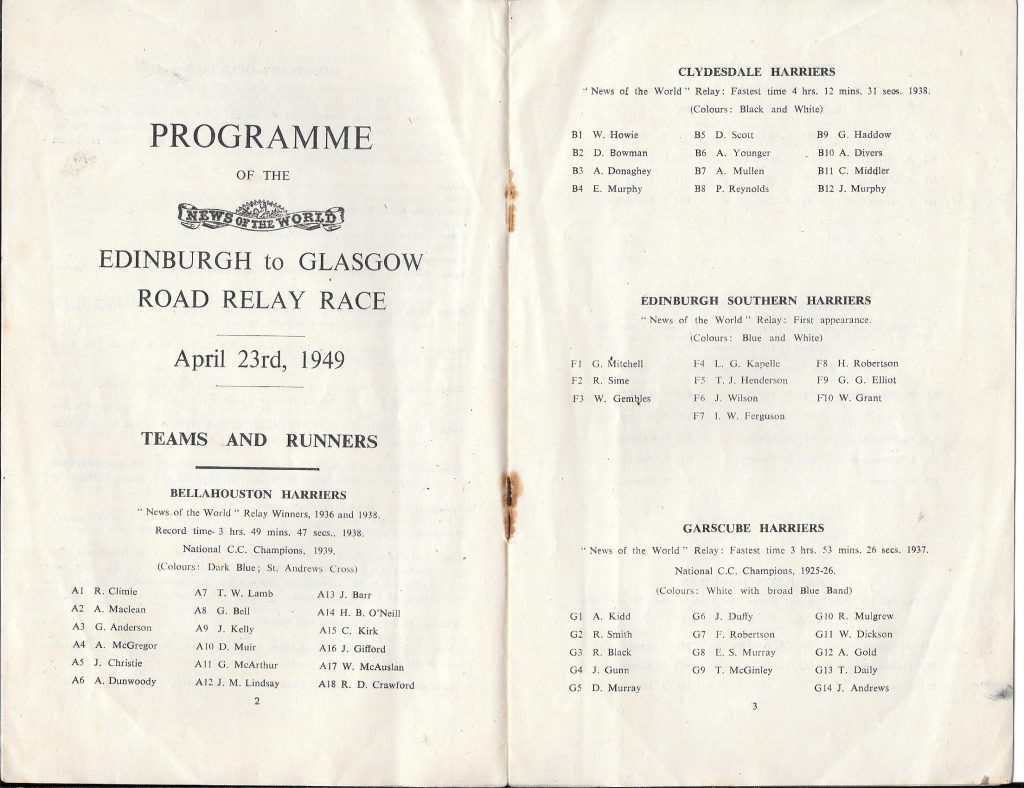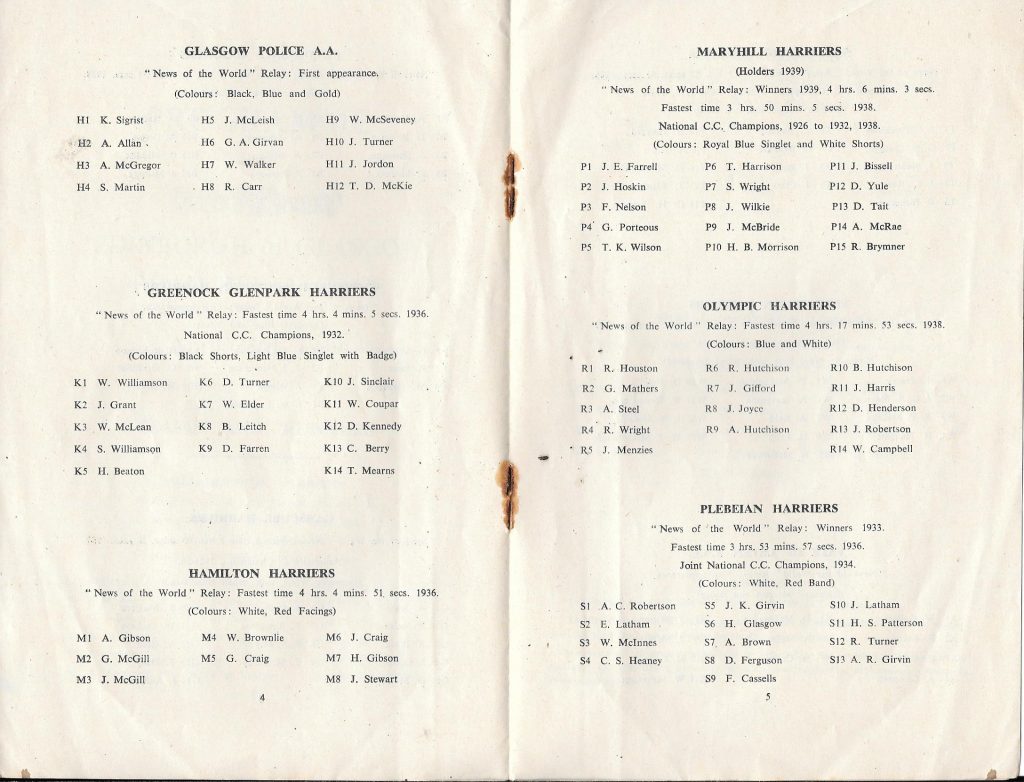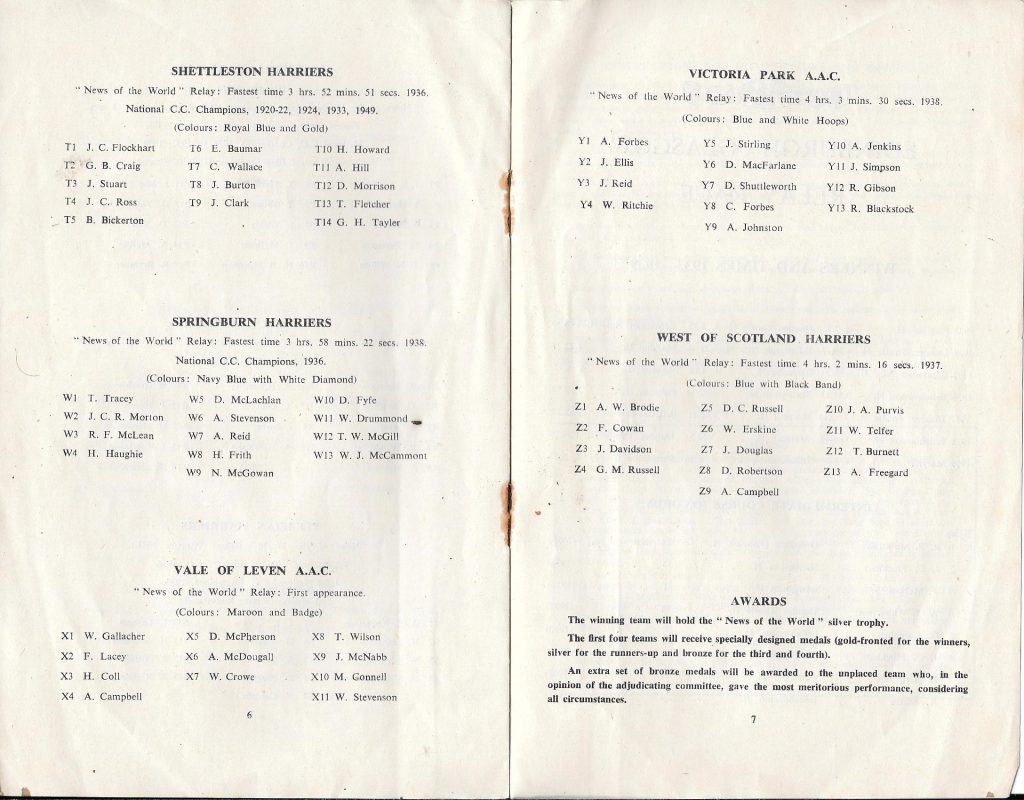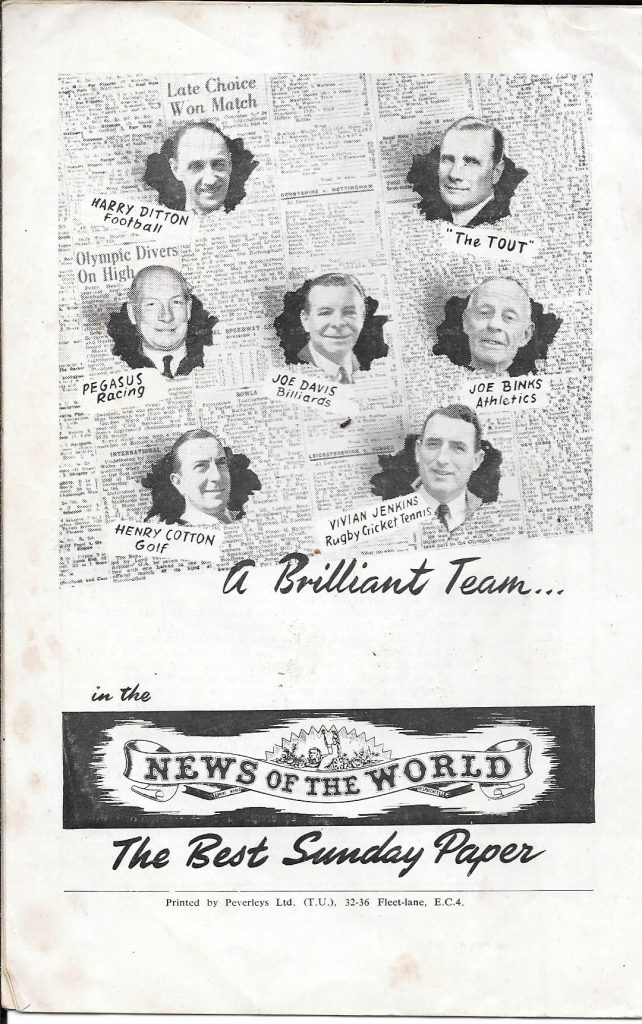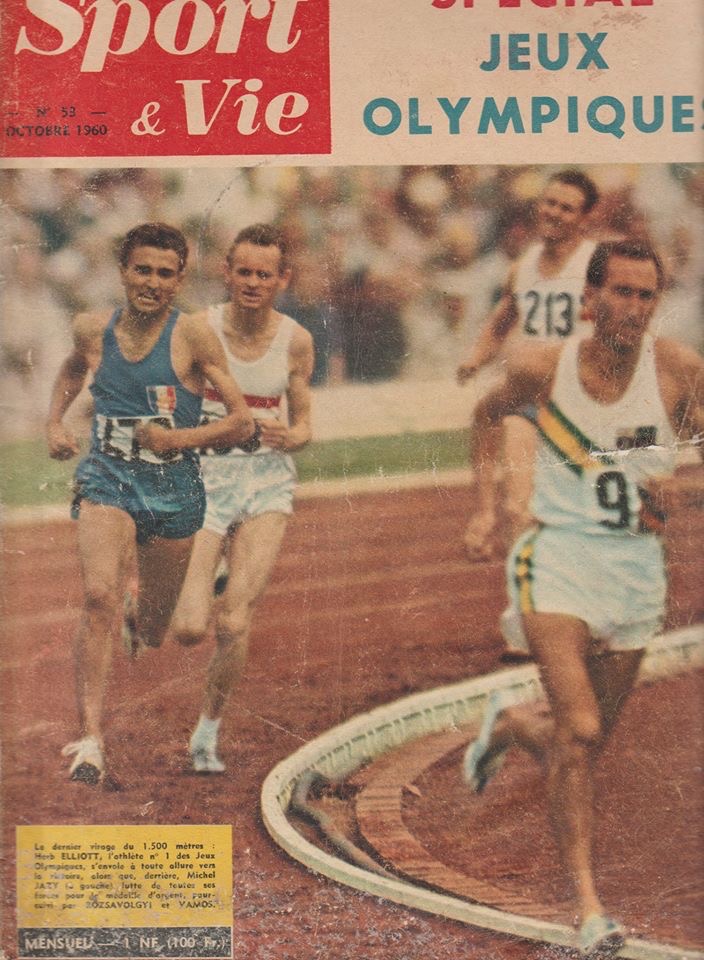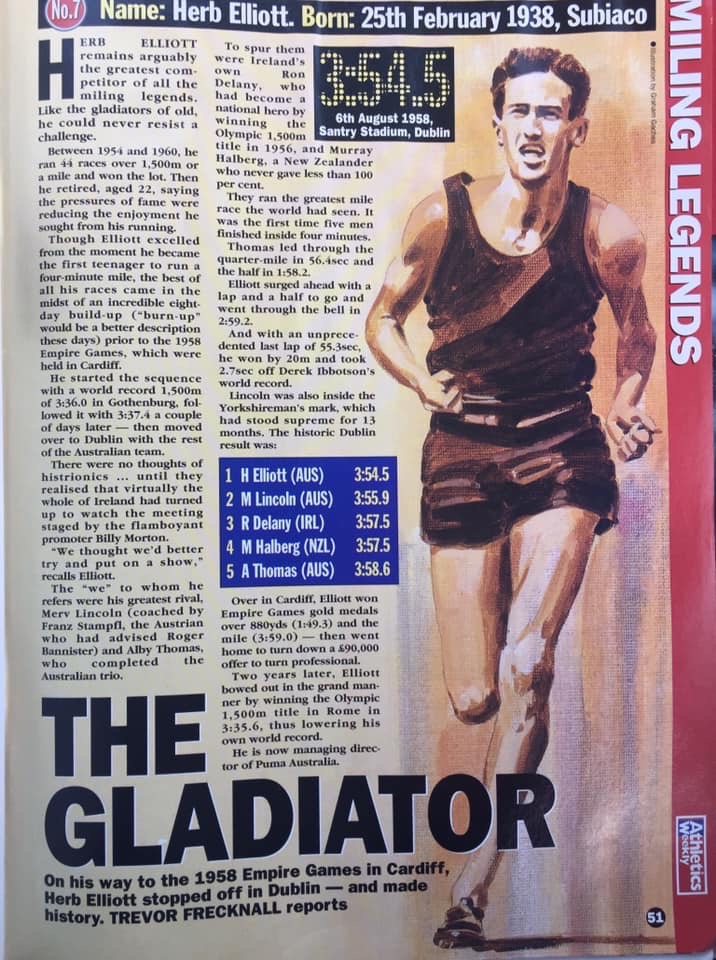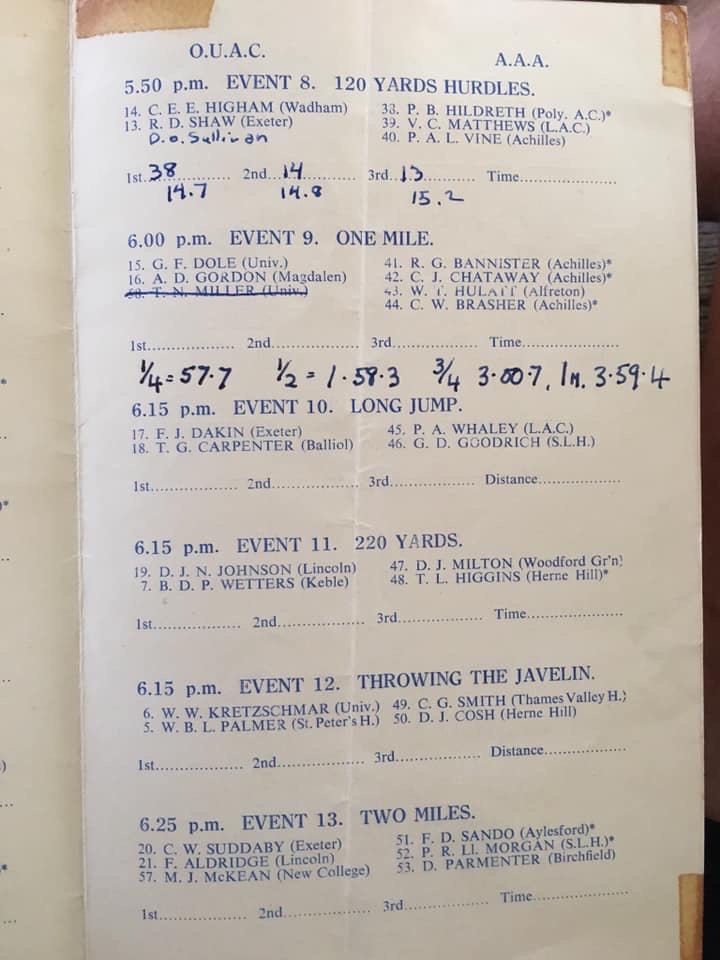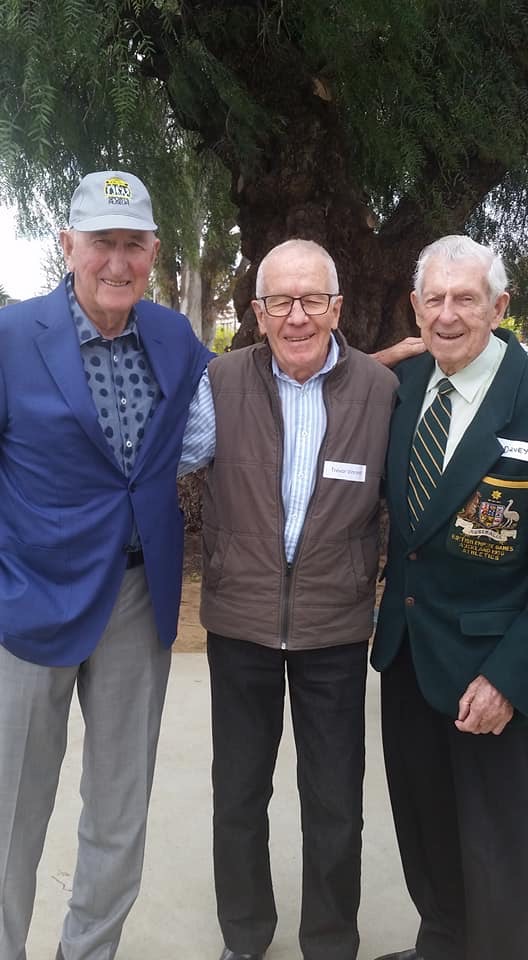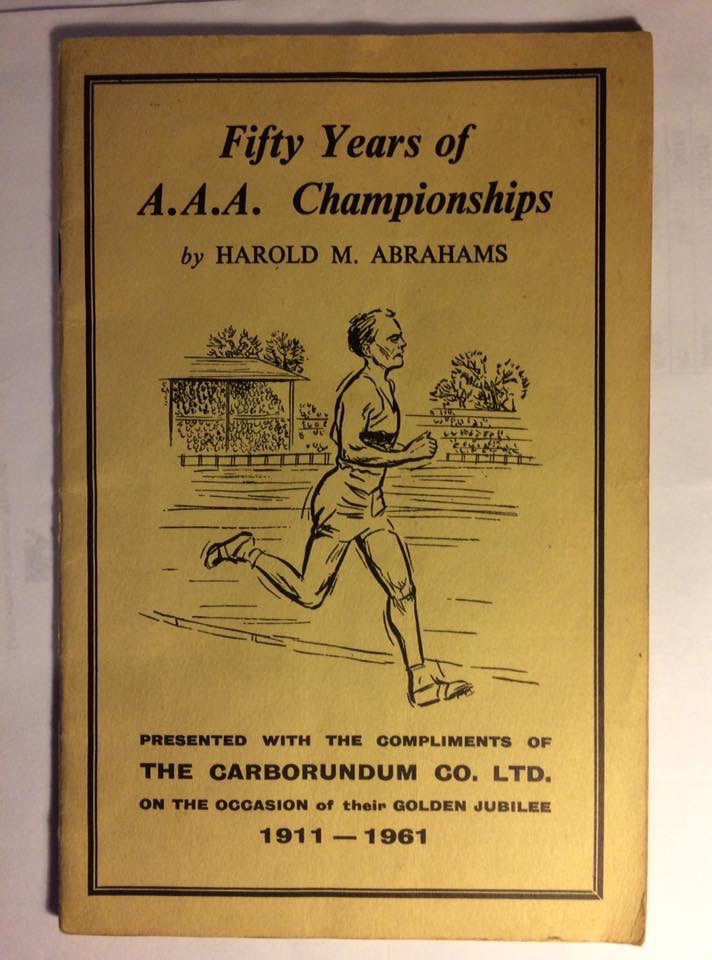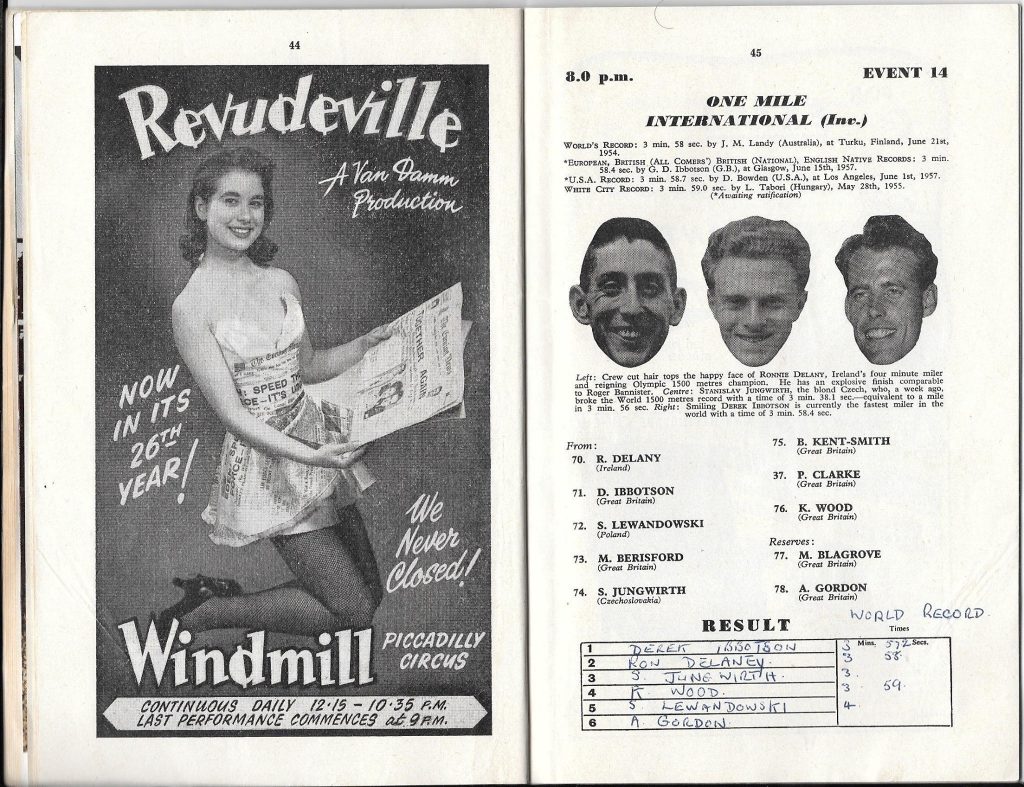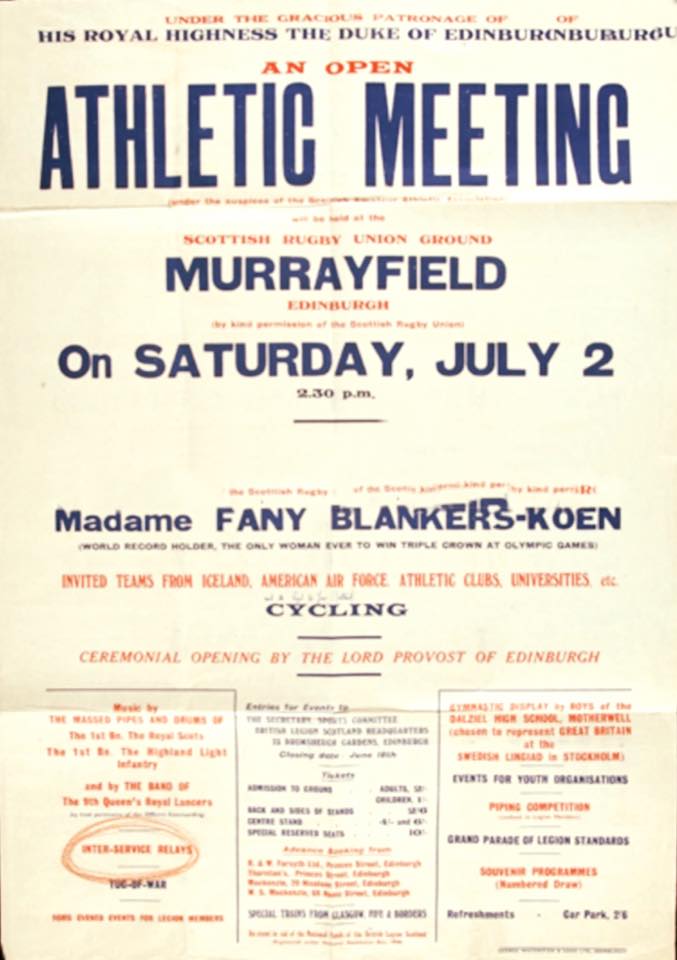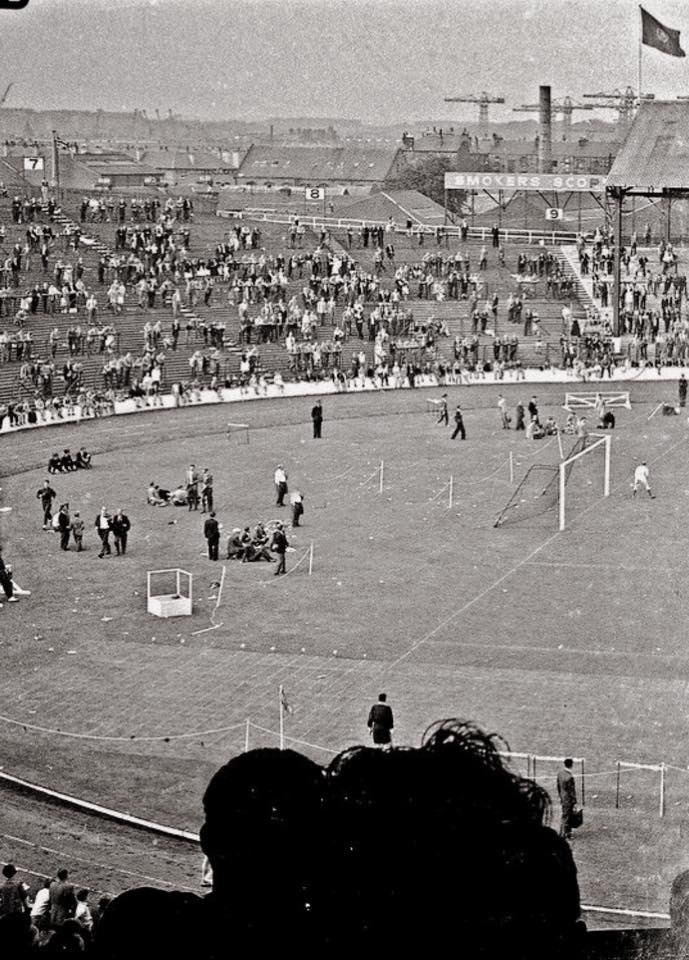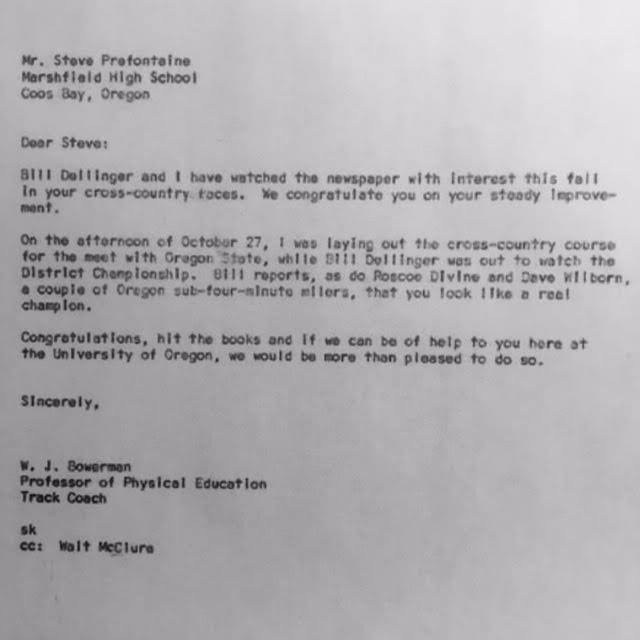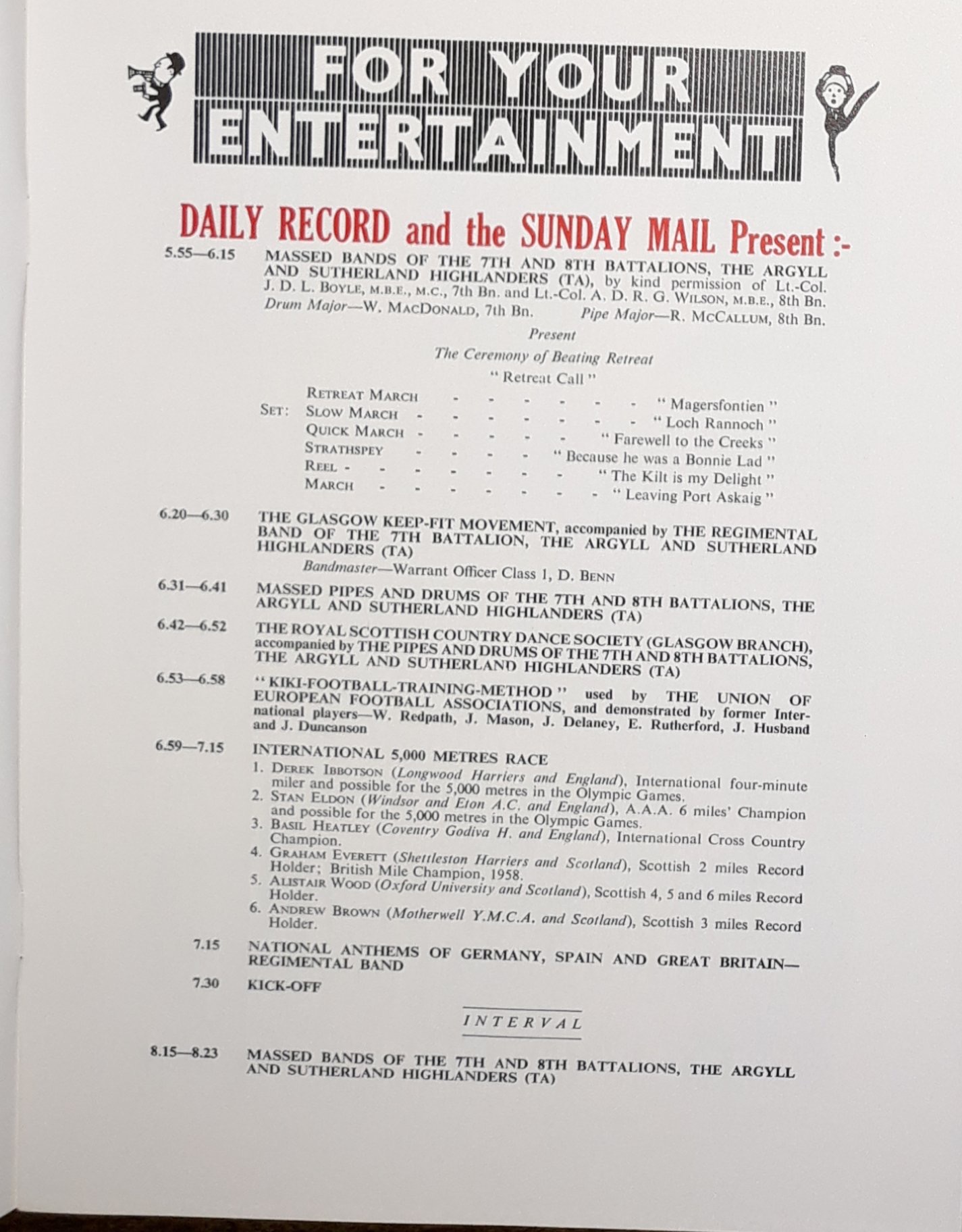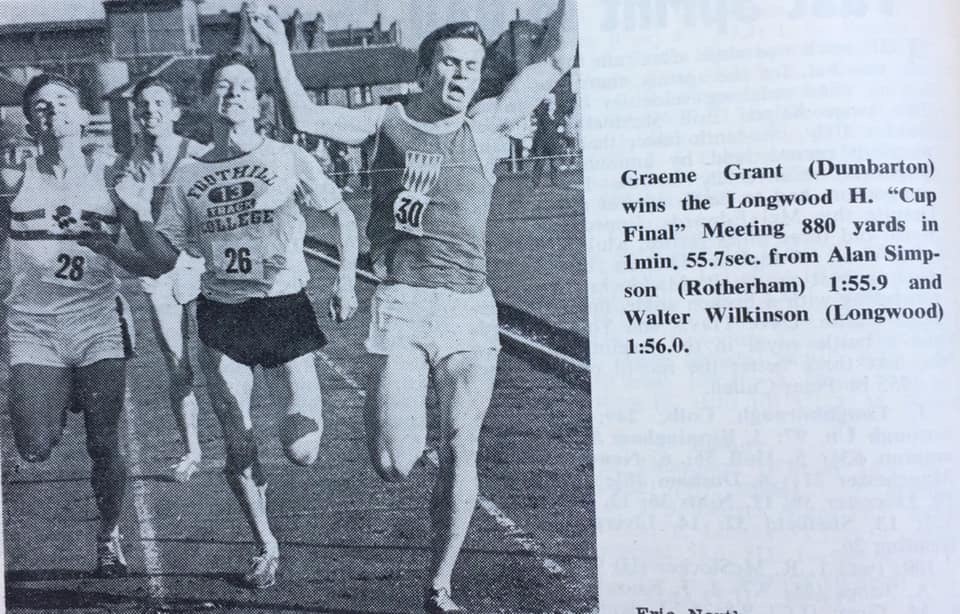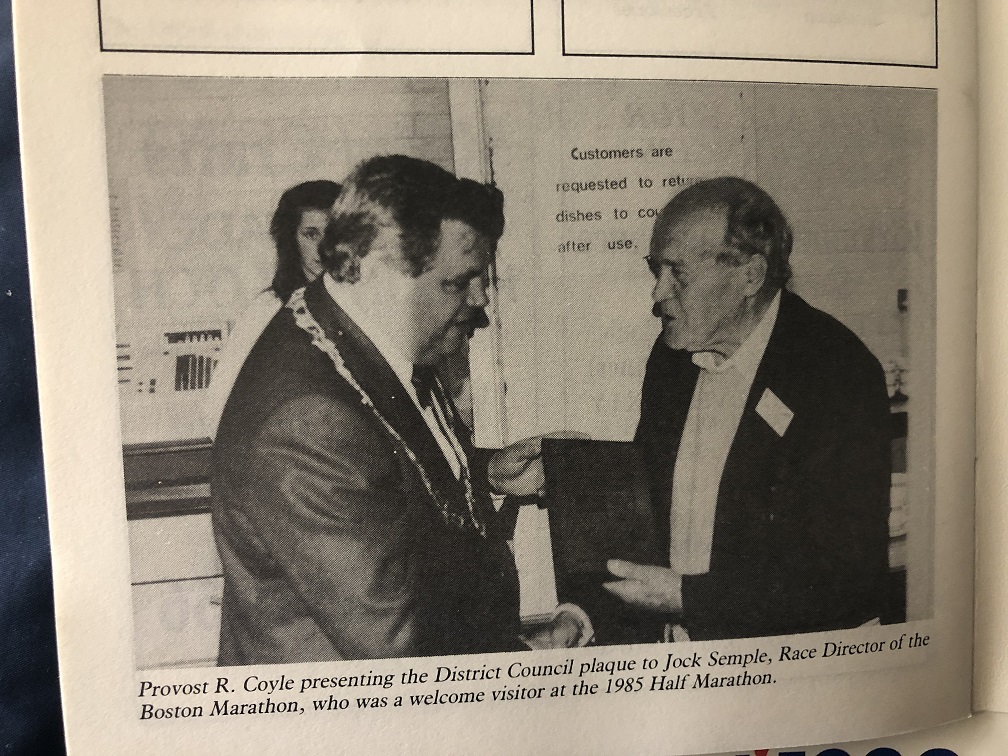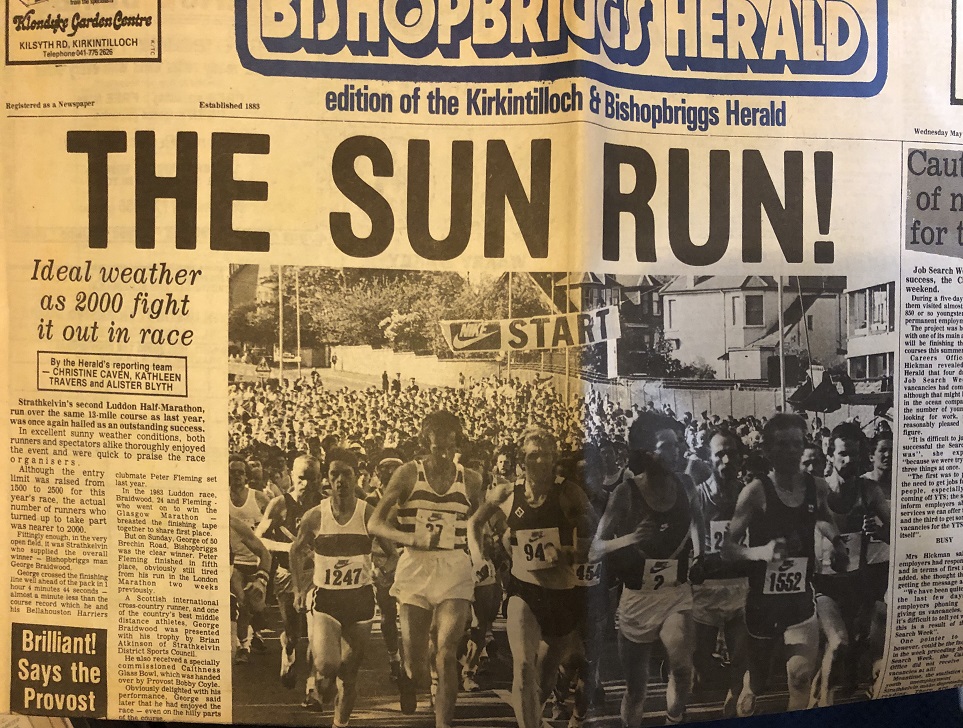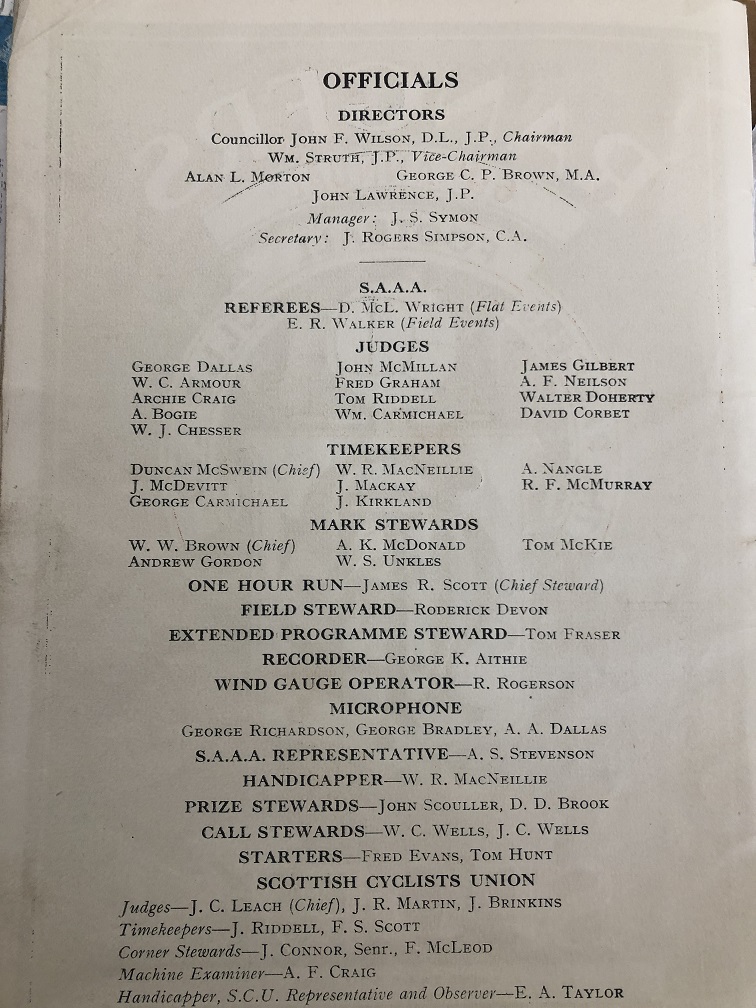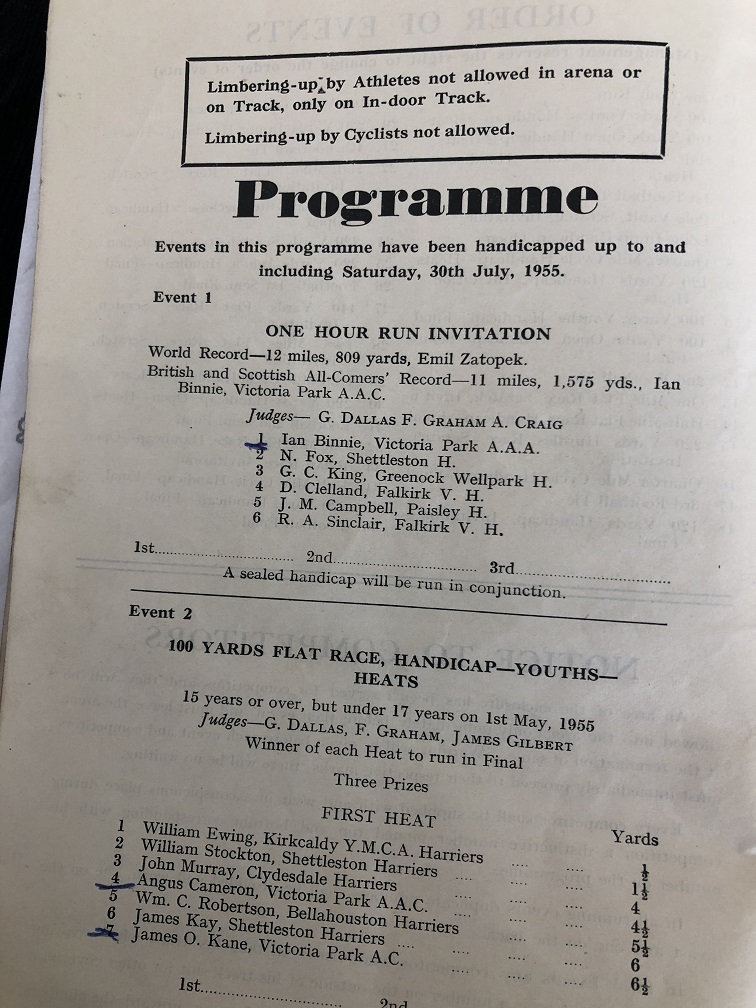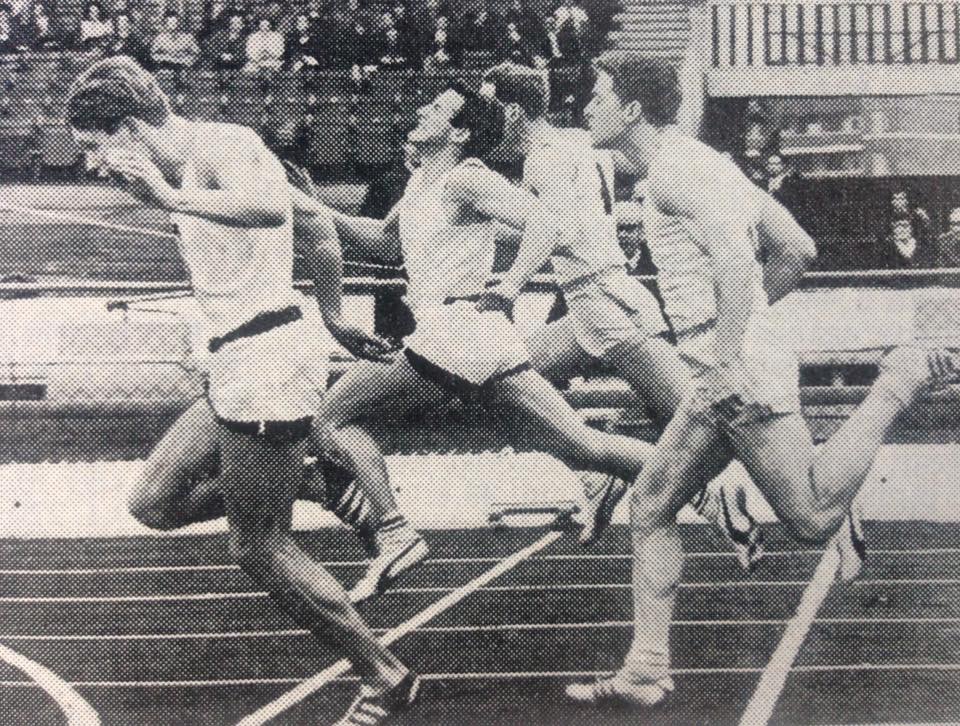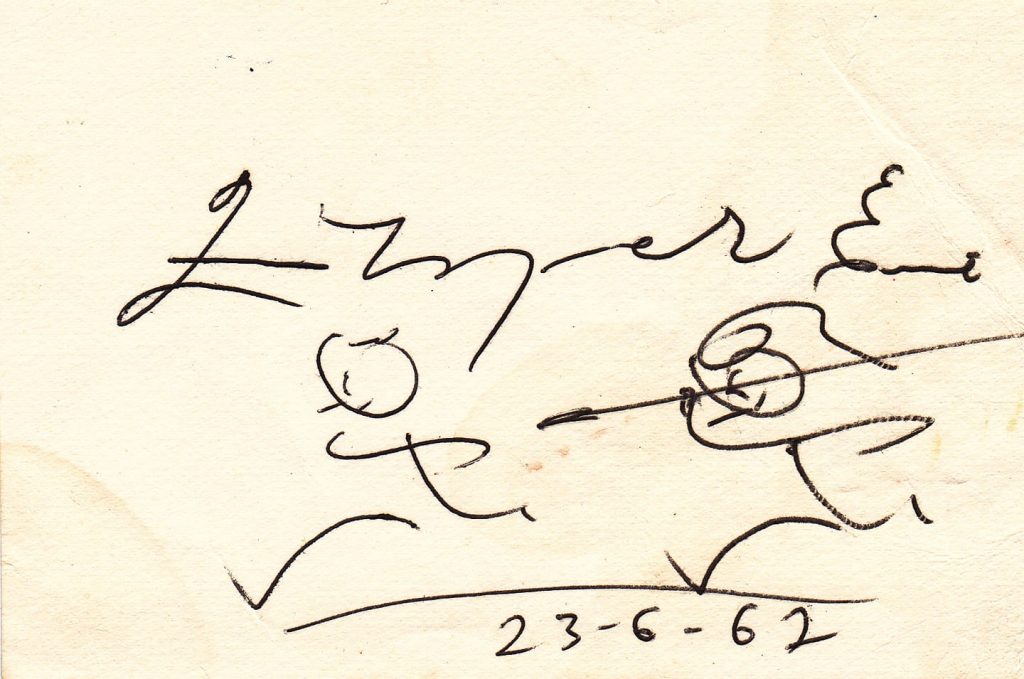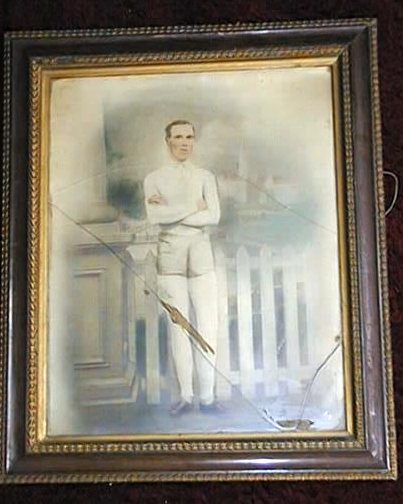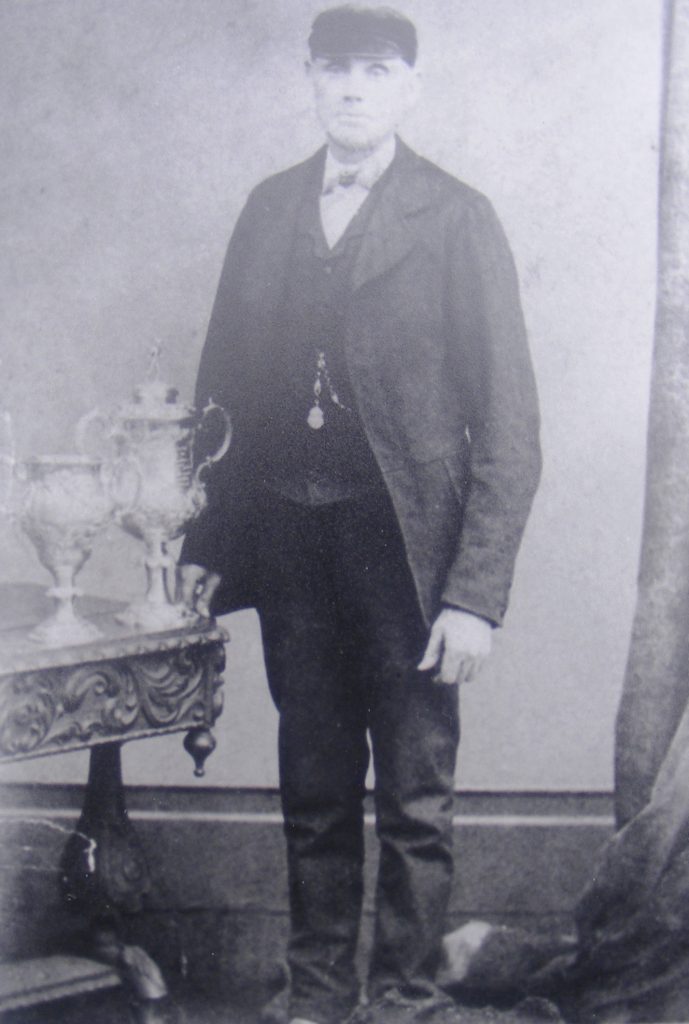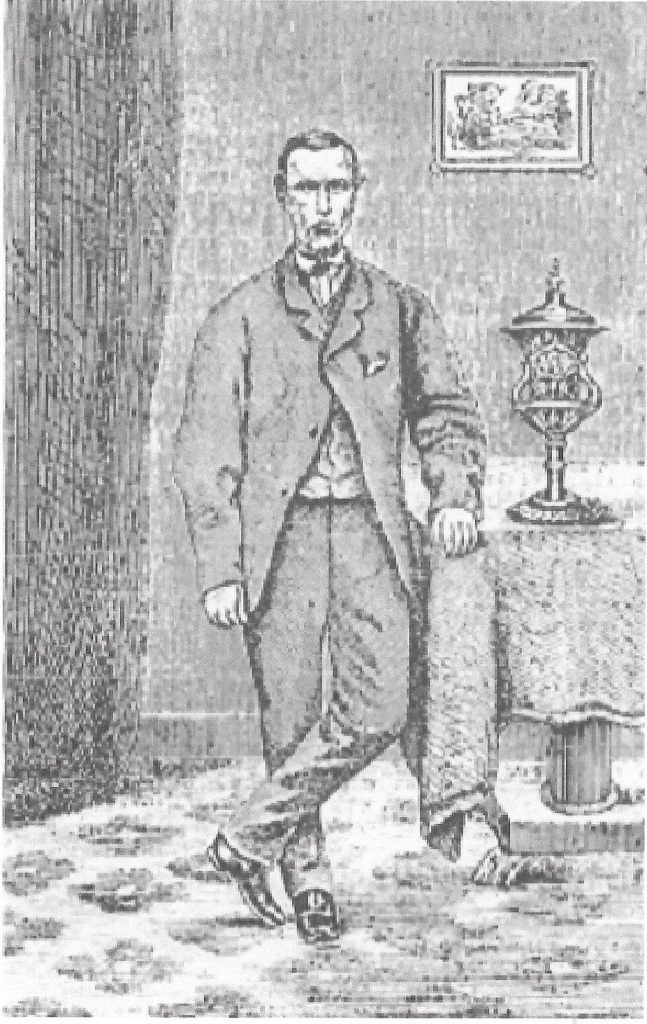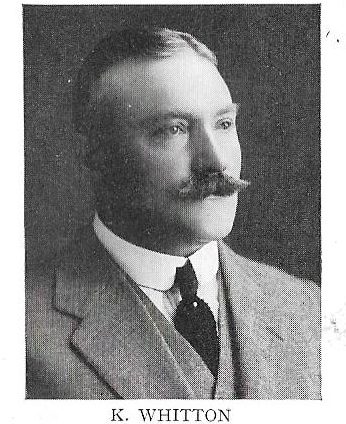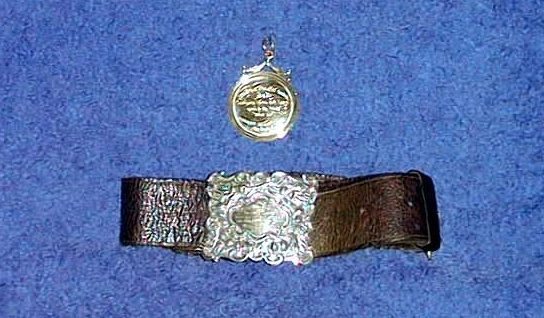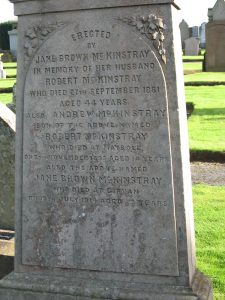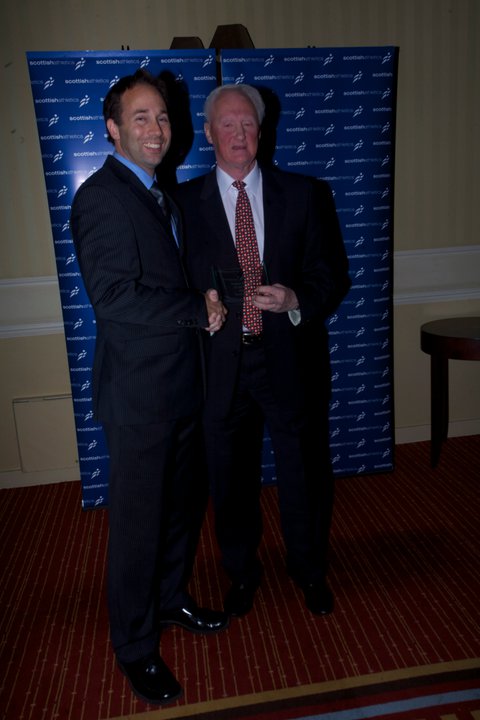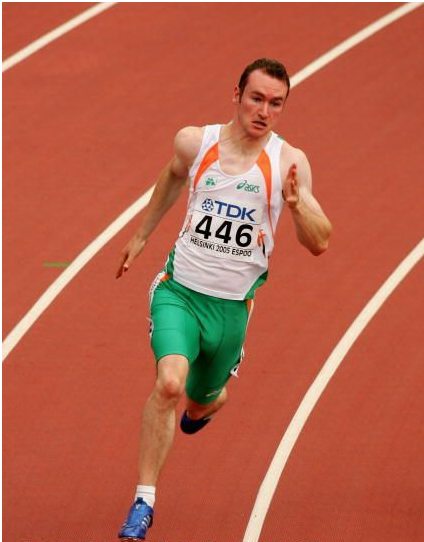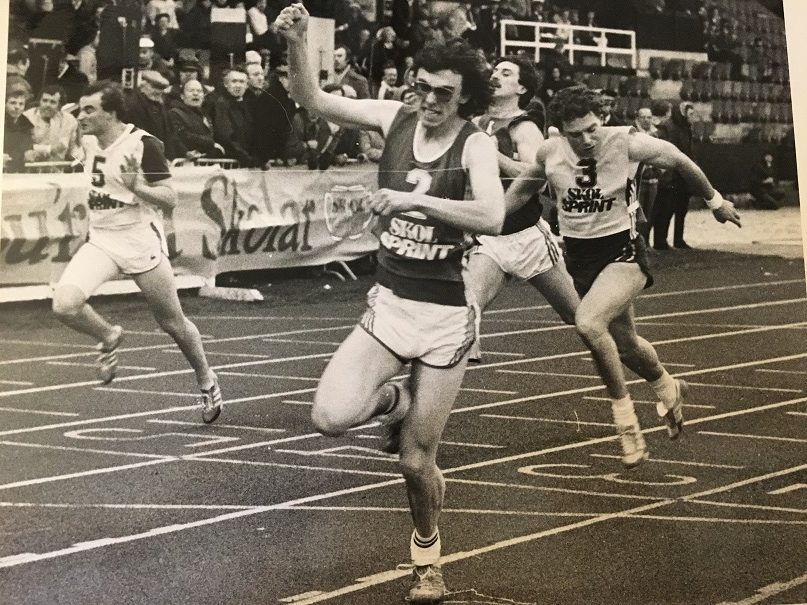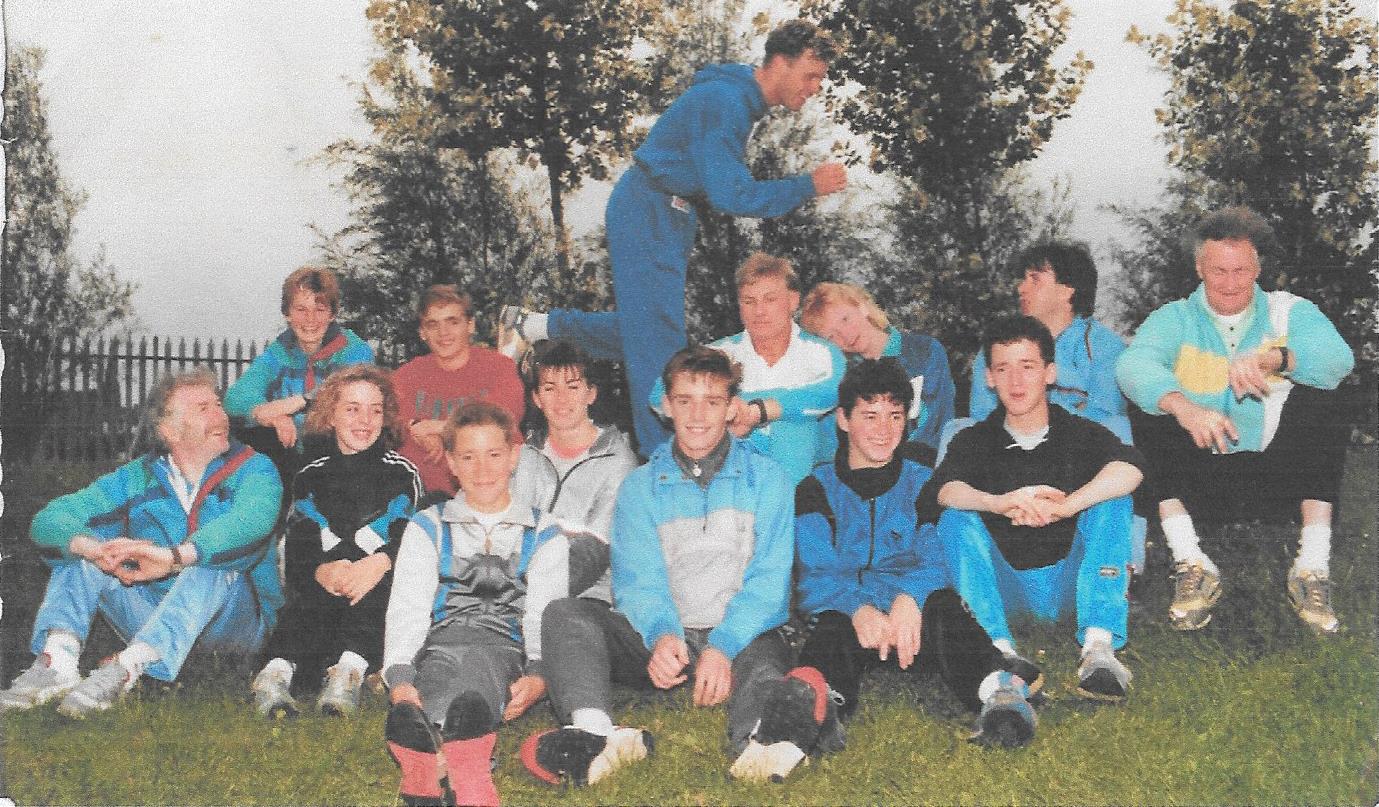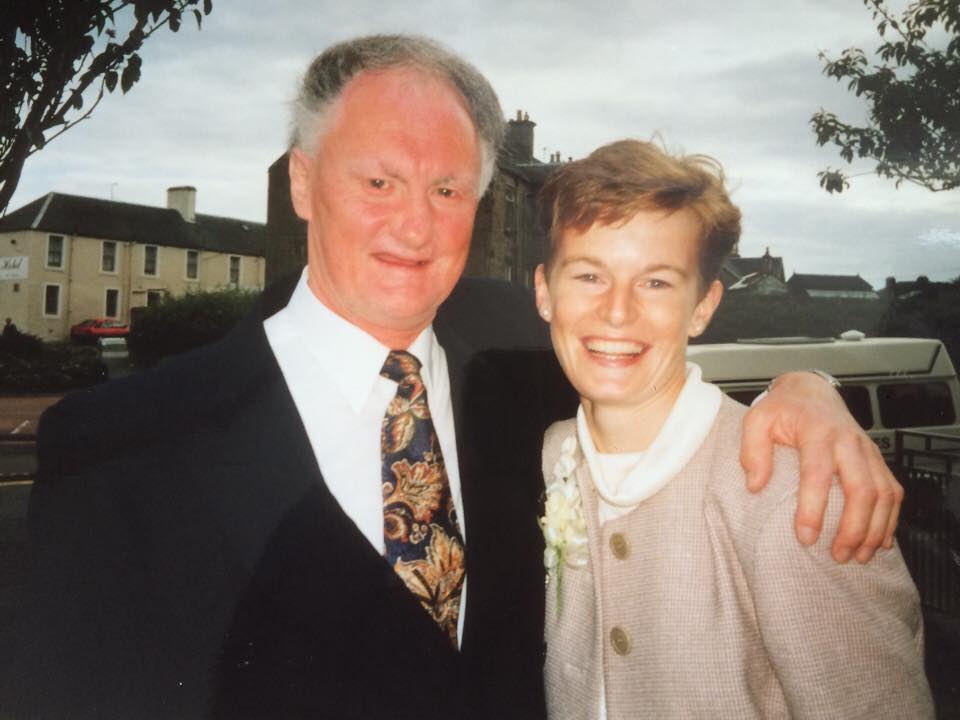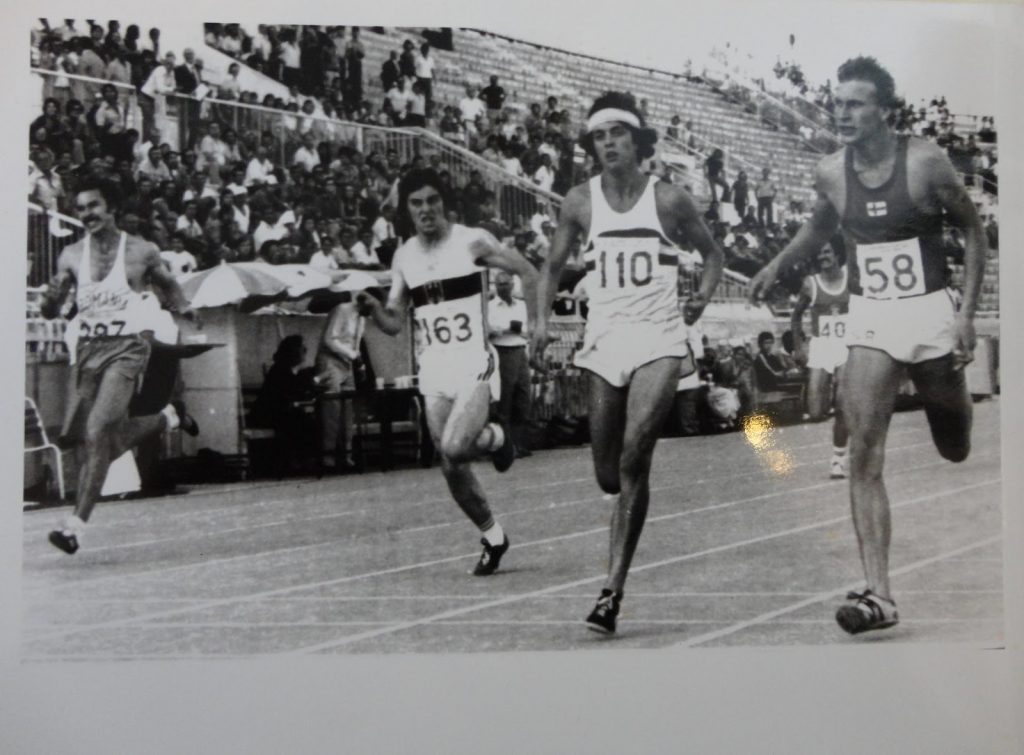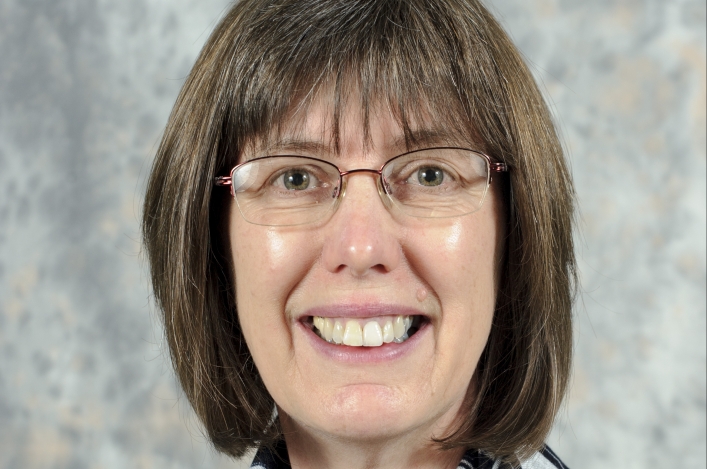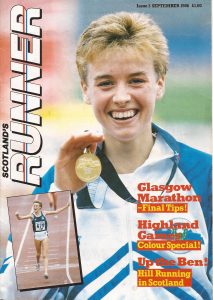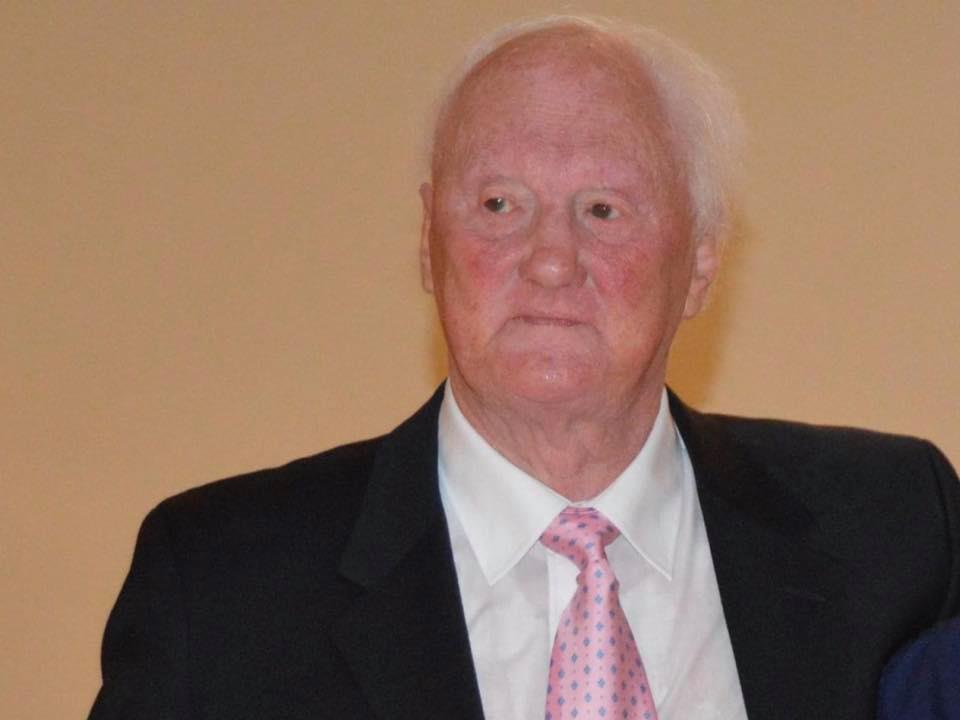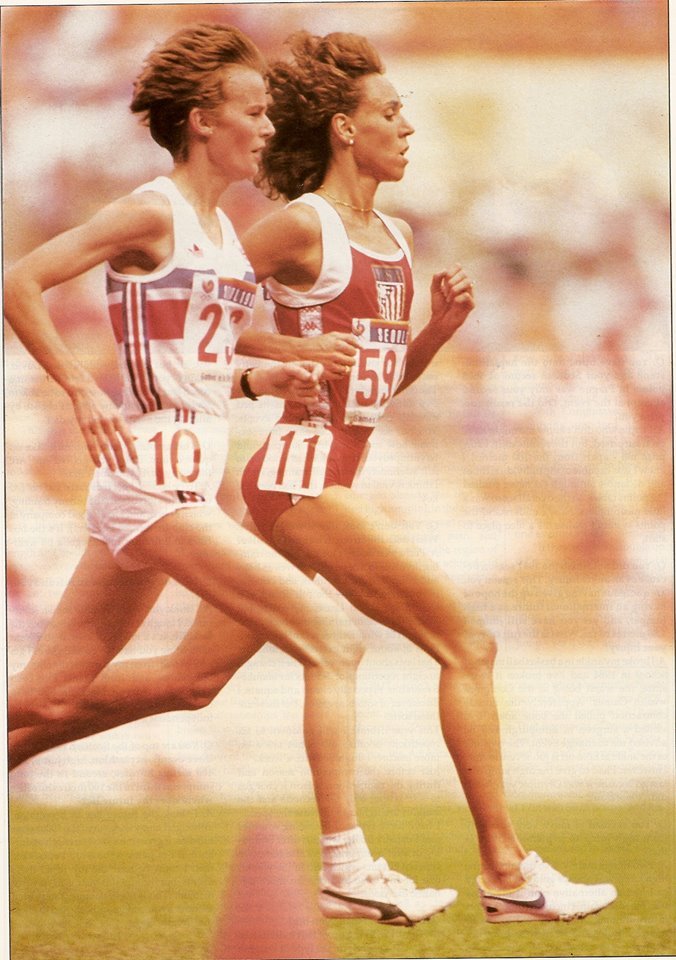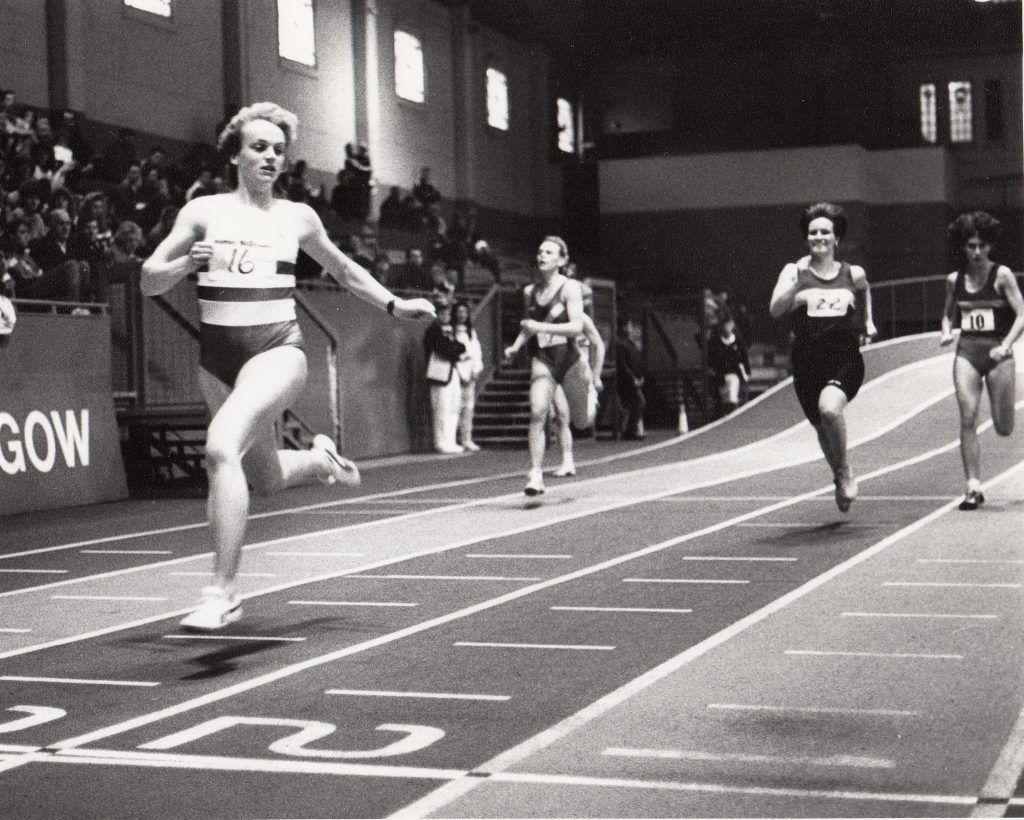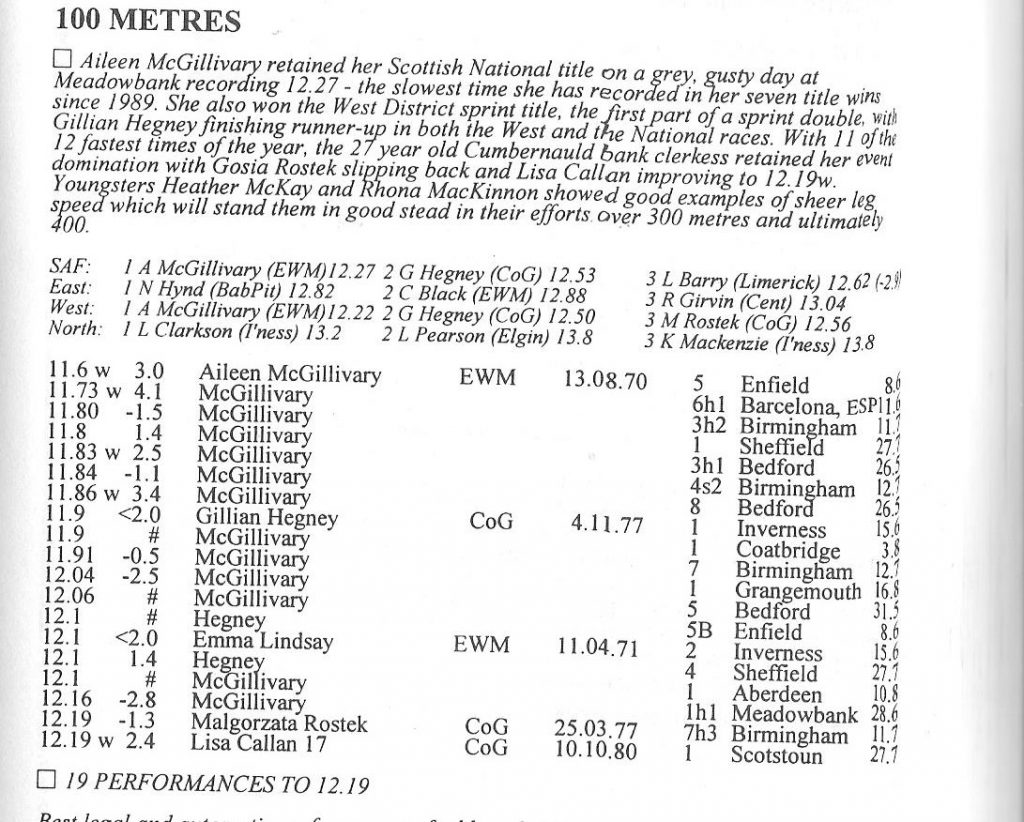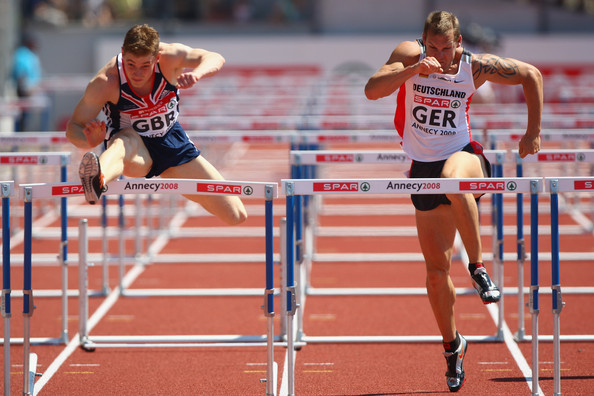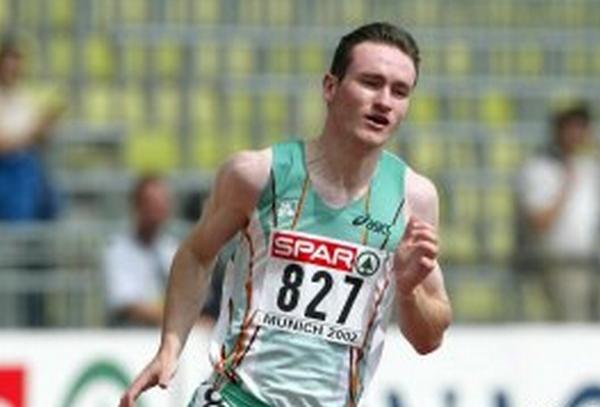.
Author: The Author
Maryhill Harriers: 2
Colin Youngson sent this history of Maryhill Harriers written by Gordon Porteous for the Scottish Veteran Harriers magazine. It should be read in conjunction with the Maryhill Harriers article in ‘The Fast Pack’ section.
Tom Scott: Races 5 – 8
By the fifth running of the race, its reputation was firmly established and it had by far the biggest entries of any of the Scottish distance road races. The picture above shows the scene at the traditional finish of the race in 1976 with Eric Fisher of Edinburgh AC (33) centre stage. It was still a 10 miles race for Senior Men only and it was not until the eighth running of the event that a Junior Man’s race was added to the bill of fare. As before, We will only have the cover page, runners and results sheets on this page.
The sixth: When the results were not available on the day, you could have them sent for a small fee. It ws an excellent service – you usually had them before the following Thirsday. This year, there must have been a shortage of envelopes because the results were simply folded, stuck shut and addressed before postage. The last sheet of the results shows what I mean!
The seventh: The programme this year was the first which was mae of stiff paper, almost like a thin cardboard in contrast to the paper used up to this point.
The eighth race included the first ever five miles junior road race and this might be a good opportunity to reproduce the entire programme and catch up with the winners from past years, note the ever present officials as well as the runners. Unfortunately the official results are not available this time: the programmes is all there is.
The lucky ticket never paid off: so many programmes defaced for naught.
Tom Scott: Second, Third and Fourth Races
For the second race, the Road Runners Club in England presented plaques in memory of Tom: the above is that awarded to Hugh Barrow of Victoria Park AAC for his third pace in the hotly contested second running of the race. On this page I will simply print the runners and the results for the next three races. The second race:
Next, the results:
Hugh Barrow finishing third, ahead of Fergus Murray
The Third Running
the fourth:
the
Tom Scott: the first races
The first Tom Scott 10 miles Road Race was a revelation to road runners who had been turning out in races with fields of twenty or twenty five runners – sometimes even fewer. The story is told on another page of the website. What this page is doing is reproducing the first ever programme and then the official results sheet. Two comments then on to the document: first, there is a bit torn from the foot of the last page where the tear-off slip for the lucky prohramme draw as located. It was the only chance most of us had of coming away with a prize! Second, the results sheets were printed on foolscap paper which was longer than the current A4 size and the bottom line on the results page might be missing. Here we go, then, with the first programme, cover above.
Now for the results
That’s the first ever Tom Scott:
Two, Three and Four will be next up
Hugh’s Gems: 2
There are 42 excellent interesting and thought provoking pictures and documents on our Hugh’s Gems pages. Hugh Barrow is an outstanding Scottish sports historian and a former top class miler and his selections are usually classics. This is the start of his second selection.
Starting this group with a French touch –
From A.W. Everybody’s hero – look at the DoB!!! Dou your sums. Frightening how recent it all seems.
Now an original marked programme for a significant race!
Herb Elliott in the Blue Jacket with Trevor and Jack Davey who ran in the 1960 Empire Games.
If you had a copy now, it would probably be quite valuable: note that it was put out by a commercial organisation.
The cover and the relevant inside pages from the London Meeting between London and New York, and Rome.
This one is self explanatory
How about this picture of the Rangers Sports in the late 50’s? Note that there is a 5 a side taking place, the grass track marked for the 100 yards complete with markers for the handicaps, the podium ready for the starter, markings on the outer track, etc.
American college coaches are known for keeping their eye on up and coming talent – it’s their living after all – and some do come on stronlg to the athletes they want. The best don’t have to do that: have a look at this letter that Hugh has spotted:
A prominent English coach said at one time that there was room for invitation middle distance races at football matches where there were big crowds and where there was a need for pre-match and half-time entertainment. Hugh promptly pointed out that such races had been held in Scotland for many years – he had run in quite a few himself! The first picture below feres to onesuch race:
.Next we have a Scotsman involved in a close victory – the caption tells the story
Jock Semple was one of the main organisers of the Boston Marathon working on it – and his business as a physiotherapist – right up to the year before he died. He was in Scotland almost every two years and he appears in the next photo when he went to see the Luddon half marathon.
Staying with the Luddon – a very successful race organised and master minded by Hugh – we have the start of the race with many well-kent runners clearly shown.
Hugh was, is and always will be a proud member of the Victoria Park AAC, having run with the club when it was flying high as probably the top club in the land. He certainly ran with Ian Binnie and the two pages below are from the programme at Cowal when Binnie smashed the Scottish 10 mile and one hour records, and just about every other on the way.
If you are a regular user of the website, you’ll know at least one of these …
Signatures from Emil Zatopek and his wife
.
Robert McKinstray
Maybole is a very attractive village in Ayrshire, south of Ayr, four miles inland from Culzean Castle and with the ruins of Crossraguel Abbey two miles to the South. Like the people of Ayrshire generally, the people always had a keen interest in sport but at the end of the nineteenth century and into the twentieth, it was well known for long distance running with many very famous ‘peds’ coming from the area. Robert McKinstray and William Rodger were among the best. The local website comments on this and actually has a page on McKinstray at :https://www.maybole.org/notables/robert_mckinstray.htm It says:
“In the last part of the 19th century and for the first decade of the present century the great interest for Maybole men was foot running and cycling. The milestones on the Cross Roads from West Enoch to Cargilstone were carefully set exactly one mile apart and this became known as “The Measured Mile” where all the local athletes trained. An up to date sports track with cambered bends was formed at Gardenrose Farm and many sports meetings were held there and famous runners and cyclists from all over Britain came to compete at them. After the great exodus from the town about 1909 the interest in athletics fell away through lack of young men (it was nearly all young men who emigrated, leaving a population of older men and young children) and the sports ground fell into disuse although the raised camber at one end of the track could, for years, be seen behind the farmhouse at Gardenrose.”
When amateur sport became prevalent in the 1880’s the performances of the peds, or professional runners, were either quietly forgotten about or diminished. That did not take away from the exploits of the men who took part in them or from the quality of some of the running. This well seen though when the individual runners and their careers are inspected. McKinstray was probably the best so it is McKinstray that we will look at fairly closely.
Robert McKinstray was born in Welltrees Street, Mybole in April, 1837, and became the greatest runner in Britain in his day, over all distances from 160 yards to 5 miles. Nowadays that would include sprints and what we would call middle distance racing.
He was not a big man, he stood only 5′ 6″ in height, but many of top distance runners are of a slight build. It certainly did not impede his progress. . Bob first came to the attention of athletics supporters when he made his debut as a pedestrian as a 15 year old at the Culzean sports, where he won half of the races on the card. Away from the sports field, the young McKinstray was apprenticed to a local butcher and served his time faithfully. He was lucky with his employer who indulged him in his running and every summer he toured the Games circuit and defeated nearly all comers on sprints, long distances and hurdle races. He had a wider range of events than most going from short sprints to what we would now call middle distance races. He was “King of the Red Hose” at Carnwath for many years: the red hose race is reported and generally accepted as the oldest foot race in the world and is held annually at the end of July.
*
McKinstray learned his trade as a runner by racing at all the local Sports and Games. There were many held in Ayrshire at the time, some were full scale athletics meetings, some races were add-ons to local gala days. For instance he ran in
“The annual Trades Races and Sports came off on Thursday last, on the Town Green, Newmilns, when a large concourse of spectators assembled to witness the proceedings. The day was fine and the different races were, on the whole, well conducted. The Newmilns Instrumental Band was present, equipped in all ts splendid new uniform; and the variety of airs performed by it during the day contributed in no small degree to the pleasures of the meeting. The following is the result of the running:- First Race, 2 Miles – 1st Robert McKinstray, Maybole, 2nd Matthew Brown, do, 3rd Cock of the North, Strathaven. “
Ardrossan and Saltcoats Herald, 25 July, 1857.
When you are starting out on your road as an athlete, you run at all sorts of meetings, this one was a particularly small one – there were three races and a running high jump.
*
1863 was a good year for him – he won the Three Mile Champion Belt at West Calder on 29th July and on October 3rd won the Two Miles championship and £50 in cash at the Stonefield Grounds in Glasgow, defeating the well known J Murdoch of Stonehouse to whom he was conceding 150 yards. Alex Wilson had a look into the Stonefield Grounds, which is a name unknown today to any of our acquaintances, and says, “The Stonefield Recreation Grounds, were first mentioned in Bell’s Life in London and Sporting Chronicle in 1861, making them Scotland’s oldest enclosure. The Royal Patent Gymnasium opened in Edinburgh in 1865. The Powderhall Grounds didn’t opened its gates for business until 1870. I was unable to find a map showing the exact venue as a running ground but did narrow down the location to a plot of land across the Clyde from the Glasgow Green, and this was leased out in late 1860.” He later pinned it down to “The site of the former Stonefield Recreation Grounds is today located between the Adelphi Conference Centre and the Strathclyde Distillery. Shawfield is however nearby. And the district was the Gorbals”
The following year, 1864, started with a defeat by Dan Shannon of Glasgow, on February 6th in a 400 yards race for £50 at the Stonefield Grounds venue. Then on 12th March, he beat W. Park for the 2 mile championship and £50 at Stonefield,. This was followed by a win over Charlie Mower of Norwich for the 2 mile championship and £50 at Glasgow on June 11th. He then won the 5 mile championship at West Calder, on July 27th. 26th Nov 1864, at Manchester Royal Oak Park grounds, where the track was 651 yards, he was fourth in a race for sweepstakes over three laps (1 mile 193 yards).
In 1865, his first victory was over Dan Shannon on April 22nd, in a 600 yards race for £30 and then he headed for the Manchester Royal Oak Grounds, where on May 20th, McKinstray won the half mile sweepstake, £75, beating W. Richards of London and J. Heyward of Rochdale/ He ran the half mile in 1 minute 56 seconds, a world record. The report is from Bell’s Life in London and is given almost in its entirety, partly because of what it tells us about McKinstray himself.
“This was another red letter day in the annals of pedestrianism. A few weeks ago Robert McKinstray of Glasgow, William Richards (the Welshman) and John Haywood of Rochdale, entered into a sweepstake of £26 to run half a mile, the winner to take the £75. Ever since the articles were signed, the affair has created more than the usual amount of interest, not only from the fact of their being tried public performers, but also on account of the men representing Scotland, England and Wales. Before entering on the proceedings of the day, a few particulars relative to the men engaged may not be uninteresting to our readers.
McKinstray was born at Maybole where he resided until about twelve months ago when he migrated to Glasgow. He is 28 years of age, stands 5 foot 6 1/2 in and when in condition weighs 9 st 11 lbs. For a long time he has been accustomed to attend the various Caledonian athletic gatherings where he has carried off nearly all the pedestrian honours of note. He has also contested against the cream of the fleet of foot over the Border with great success, and from one to five miles McKinstray is champion of Scotland. For the present contest he was trained by Mr William Straker of Newcastle-on-Tyne, and arrived last Monday at his final quarters, Mr John Booth’s King’s Arms, Newton Heath. There followed brief notes on the other two runners but not as much as there was on the Scot, the odds were quoted (5 to 4 on Heywood, 7 to 4 against for McKinstray and 3 to 1 against Richards. Shortly after 5 o’clock the stake holder and referee My John Brittain got them under way’by report of pistol’..
“Intense excitement prevailed as the men came bounding along the straight which is 400 yards long and rather uphill, and on passing the stand McKinstray led the way closely followed by Heywood and Richards in the order named. As they came sweeping round into the circular course the same order prevailed, the pace being terrific. No change took place in the relative positions until coming along the back stretch, about 250 yards from home. The Scotch representative now held a commanding lead of half a dozen yards, Heywood second and the Welshman close up. Richards now buckled himself together, and putting forth a most determined effort breasted Heywood when the pair joined issue for second place which was obtained, after a gallant struggle, by Richards. For a few strides the Welshman gained slightly on the leader, but as they neared the goal, the race became a certainty for the Glasgow man who was running well within himself and going in splendid style. Richards and Heywood soon showed symptoms of distress, but the former in the most game and resolute manner struggled, though unsuccessfully, to overhaul McKinstray who turned his head to take a parting look at his men, and breasted the tape in easy style five yards in advance of Richards, who was two yards in front of Hayman. The Scotchman had a large number of friends on the ground who were in ecstasies at the success of their man, and they may indeed feel proud of him as he has eclipsed all previous performances of half a mile, the stipulated distance being covered on the present occasion by the winner in 1 min 56 1/2 sec, the fastest time on record. That time is 1 1/2 sec less than the great race between HA Read and Tom Horspool which took place several years ago at West Hill Park, Halifax, for £100 which the former won, having completed the distance in 1 min 58 sec which was then, and continued to be until the present day the quickest half mile race ever run. We may add that the Scotch division won about 300£ in bets.”
This of interest for several reasons, one of which is that the Scottish amateur record only dipped below two minutes for the half mile in 1895 and that time was 1:59.5. It was run on a standard two laps of 440 yards cinder track after three or four men had been inching it down over several years. It came from 2:00.4, to 2:00.2 and then 1:59.5. The runners involved (Mitchell of St Mirren, Malcolm of Morton and Langlands of Clydesdale, urged on by such as William Rodger, another Maybole runner) were all good men. McKinstray is recorded as having run sub 1:57 on a track with a 400 yard straight, a bend and a circular track.
He then beat W. Bell at Newcastle over 2 miles for £40, on June 4th; defeated E. Ashworth of Bury in the short distance of 160 yards winning £20, on July 14th; came back to Scotland and won the gold medal at Johnstone on July 15th, for a 3 mile handicap race; went on to defeat W. Richards in a 1 mile race, in which Richards received a 15 yards start and staked £30 to Bob’s £25 on July 29th, 1865. Then came another major event, again held in Manchester where he ran third from scratch on August 19th, in George Martin’s championship one mile handicap. The race was held at the Royal Oak Grounds and there was quite a big field of 10 runners for this important race. S Albison, W Richards (alias The Welshman), C Mower, R McInstra, J Sanderson, P Stapleton, W Lang, alias The Crowcatcher, J Nuttall, J Neary and E Millis, alias Young England. The report gave a lot of detail on the competitors and it told us that McInstra (their spelling) was the oldest in the race – now being 30 years of age, having aged two years since the half mile record run.. He was reported to be only 5′ 6 1/2″ in height and weighing 9 stone, He had again been trained by Mr W Straker of Newcastle on Tyne.
Mr Martin himself held the positions of stake holder, timekeeper and referee and started the race at 5:22 pm. The report in Bell’s Life on the race itself read: “[at the half mile ..] Nuttall led the way, Neary and Sanderson, almost side by side, lying next, these being followed by the Scottish hero, the Welshman being alone in his track, and Lang, who being the outsider at the start, soon made up leeway, and with determined action, he proceeded. Stapleton lying near, followed by Albison – Mower having no chance and toiling in the rear. The distance of one mile required two laps and 458 yards to be covered, and on passing the first time Nuttall was still in front, he being attended by Neary, Richards, Lang, McInstra and Sanderson. Stapleton was then seventh, Albison eighth and Mower last of the lot. Shortly afterwards, McInstra headed the field, but on going along the back stretch, Sanderson wrested the honour from the Scotchman and at the same time increased the pace which even up to this point had been fast. The “son of the heather country” once more, prior to arriving at the stand, gained the supremacy, and before passing the referee, Neary, Mower and Nuttall gave up. However, on went the residue, McInstra just in front, Richards next, Lang, third, Sanderson fourth, Stapleton fifth, Albison sixth; and in this order they entered the last revolution of the course. Then came the “tug of war” when Sanderson and Stapleton, not possessing sufficient speed, the race was reduced to a trio; the performers nearing the final turn being Richards, Lang and McKinstra, the three lying well together, the latter holding the lead, Richards second, Lang third , Sanderson fourth, Stapleton fifth and Albison then last. Just before arriving at the final turn, Lang and Richards gave McInstra the go- by, and between the last named pair a brilliant struggle ensued. The concluding 150 yards were warmly contested – Richards and Lang being nearly breast and breast – and they came along at high pressure speed, their wonderful efforts resulting in a dead-heat; five yards behind them came McInstra and then followed Sanderson at a distance of 20 yards, Stapleton came in next and Albiston brought up in the rear.
It is almost needless to say that the race was of an interesting description, when we add that it proved to be the quickest on record – 4 min 17 1/4 sec, the time of Mills, Lang, Albison, Hospool and other renowned pedestrians being thus far excelled. The dead-heaters received an ovation, many, however, maintaining that Lang had won by a few inches. Mr Martin’s decision was, so far as we could perceive, a just one, not withstanding the hubbub occasioned thereby.”
After this excellent performance, McKinstray finished his year’s efforts with a race on Boxing Day against James Sanderson (Treacle) at Hackney Wick, just outside London, in a 10 miles sweepstakes. He retired in the fifth mile but led at 4 miles in 20:45.0.
The rivalry with Treacle continued on 31st March 1866, again at the Manchester Royal Park Grounds. It was a two miles race which he won in 9:57 , after coming through the Mile in 4:50. Back there again on 30th June, it was a three quarter mile sweepstakes, where he was 4th: he came through 880 yards in 2:02 leading the field. Race result: W Richards 3:07 .5e; 2nd James Nuttall (3 yards) 3rd Siah Albison (15y) 3:10e, 4th McKinstray 3:11e
According to the Maybole historian, McKinstray then took up his quarters in England where trained at Newcastle, and on February 23rd, 1867, gained the mile and a half challenge cup, value £80, won three times in succession, but this time was third behind Richards and Bill Lang.
1st June, Manchester: 1 Mile, 1st 4:31
22nd July, Manchester, 1 mile against John Fleet,dnf but 4:26.6e (off 9y, 68, 2:14, 3:20)
3rd August, Manchester, one and a half miles against J Sanderson and J Fleet, 1st 7:02.5 (64, 2:11.5, 3:15.5, Mile in 4:30.0, 5:39
“PEDESTRIANISM. A foot race for a sweepstakes of £25 eachtook place on Saturday at the Royal Oak Park Grounds, Newton Heath, Manchester. The pedestrians who took part in the contest were J Sanderson of Whitworth, near Rochdale, J Fleet of Manchester, and R McKinstray of Glasgow. The betting at the start was evens on Sanderson, 5 to 4 against Fleet, and 3 to 1 against McKinstray. On the pistol being fired, Sanderson shot to the front, immediately followed by Fleet, McKinstray bringing up in the rear. In this order they ran for nearly half a mile, when McKinstray took the lead, was not afterwards headed, and won easily. Fleet and Sanderson gave up before entering the straight. Time, 7 min 2 1/2 sec.”
On 19th August, at Coatbridge, in the 5 miles championship of Scotland, he was first:
“COATBRIDGE ATHLETIC GAMES. These annual Games and Sports were held on Monday in a field near Coatdyke. A drizzling ran fell all the morning and the the spectators at the commencement were few, but during the afternoon and the evening the rain held off and a large crowd gathered. … The Coatdyke Sports got up in opposition were held in an adjoining field. Captain Clark and a posse of constables kept excellent order. There were the usual number of thimble-riggers and card-sharpers on the ground, along with a sprinkling of the “fancy”and members of the PR.”
One of the bigger meetings on the circuit, there were 18 events on the programme including the 5 Miles Race. It may seem strange in the twenty first century but the race for the Five Miles Championship of Scotland was a handicap race. That made no difference to McKinstray – he won from J Steel of Glasgow and William Parks, also of Glasgow, with Newcastle’s W Bell dropping out. No time given but the report said that he ‘won easily’. He also won on 8th October at Crystal Palace over 4 miles. and on 2nd November, back in Manchester, in a one and a half miles race against J Fleet He was first after quarter mile splits of 60 sec for quarter mile, 2:05 for half mile, 3:19 for three quarters – finished at leisure but no time given.
“PEDESTRIANISM: Important Foot Race in Manchester. A foot race for £50 and a champion cup of the value of £80 came off at the Royal Oak Park Grounds, Manchester, on Saturday between Robert McKinstray of Glasgow, and John Fleet of this city, the stipulated distance being one mile and a half. The cup, which is a challenge one, had been previously won by McKinstray, and a few weeks ago Fleet challenged him for its possession. The betting opened at evens on Fleet, and shortly afterwards 6 to 4 was laid on him, but at the start 5 to 4 was freely offered on McKinstray. The pedestrians went away on the first attempt, McKinstray leading by about 2 yards at a quick pace and the first quarter mile was gone over in one minute. In this order the men proceeded and they ran half a mile in 2 min 5 3/4 sec. Fleet gradually fell further behind his opponent and when three quarters of a mile had been passed, 3 min 19 sec had elapsed. Before a mile had been run Fleet, finding that he had no chance of success, resigned the contest, and McKinstray went over the remaining portion of the distance at his leisure.”
1867 had been a good year for him and he started 1868 on 7th March with a one and a half miles race against J Sanderson, where he was first in 7:04.5. The report in the Dundee Courier read:
“GREAT FOOT RACE AT MANCHESTER. Victory of the Scottish Champion. The Manchester Examiner gives the following account of a foot race in that city, in which McKinstray, the Glasgow “ped”. proved an easy victor:- On Saturday at the Royal Oak Park Grounds, a contest: distance one mile and a half took place between Robert McKinstray of Glasgow, and James Sanderson, alias Treacle, of Whitworth, for a champion gold cup and £50, the parties engaged having staked £25 each. The cup, which is of the value of 80 guineas, and is given by the proprietor of the above grounds, was originally contested for on the 23rd of February, 1867, when it was won by John Fleet of this city. The principal condition on which this cup was given was that the winner shoud successfully defend it, against all comers, on receiving six weeks notice, for twelve months, before it became his absolute property. Not being satisfied with his defeat, McKinstray subsequently challenged Fleet, and Sanderson having also entered, it became a sweepstakes of £25 each and the cup, and the contest came off on 3d of August last when McKinstray won easily. Fleet, the original holder afterwards challenged the Scotsman and they met on the 2d of November when McKinstray again defeated Fleet, the latter having resigned the contest when about a mile had been covered. Sanderson, being also dissatisfied with his previous defeat, again challenged McKinstray and hence the match on Saturday. The attendance of spectators was meagre in consequence of the weather, not more than 600 persons being present. The betting commenced at evens on McKinstray, but when the start took place as much as 2 to 1 was laid. To complete the distance the course had to be traversed four times and 36 yards. As soon as the men left the crease, Sanderson took the lead by a yard, and held it on sufferance until three laps of the course had been traversed, when the Scotchman passed him and gradually left him further in the rear, and when reaching the turn for the straight in to the finish had a lead of 30 yards. From this point he slackened his speed but passed the tape an easy winner by a dozen yards. The time occupied was : quarter mile, 1 min 3 sec; half mile, 2 min 11 sec; three quarter mile, 3 min 25 sec; mile, 4 min 34 1/2 sec; one and a quarter mile, 5 min 46 1/2 sec; 1 1/2 mile, 7 min 41 sec,”
Then on 10th April,, back in Manchester over 1 Mile,he finished second in an estimated 4:27.0 20 yards behind the winner’s 4:23.5.
McKinstray:
1869. 8th November at Hackney Wick, McKinstray was pushing the limits of his rane when he ran 10 miles. He finished 3rd after leading through 2 miles in 10:07.8. Shortly thereafter, still at Hampton Wick, 0n 27th December, he ran in a 5 miles sweepstakes. He retired after running well for most of the race – 1 mile 5:03.0, 2 miles 10:17.4, 3 miles 15:36.2, 4 miles 20:28.4. George Hazael won in 26:05.0.
His last appearance before the public was at Edinburgh, December 31st, 1870, when he ran a match against an Iroquois Indian named Debeaux Daillebour, alias Redhead, especially brought over from America to race him, 3 miles level, for £30 a side, on. which occasion our friend Bob made short work of the Redskin, leaving him so far behind that he gave up the race, leaving McKinstray to walk in at his leisure in a little over 15 minutes. The report this time read:
POWDER HALL GROUNDS
Saturday, December 31st – DAILLEBOUR (THE INDIAN) AND R McKINSTRAY FOR £30 A SIDE. The interest attached to the Three Miles match between the now celebrated Indian runner Daillebour and R McKinstray (the Scottish champion was very considerable. McKinstray may now be termed a veteran, having figured in various matches, handicaps and sweepstakes during the last 20 years. His greatest achievements were twice carrying off the one nd a half Champions Gold Cup given by Mr T Cooper of Manchester, when he beat Fleet and Sanderson. The weather being most favourable for this season, there was a large number of spectators from 1,200 to 1,500. On the appearance of the men the Indian was scanned with eager eyes and the general impression was that he would be proved the winner. but he appeared somewhat careworn and stale, either from over training or the fatigue of travelling. Mr T Callaghan having been appointed pistol-firer and referee the men toed the scratch at 3:30 and away they flashed at fine speed, the Indian with the lead. He covered the first half mile in 2 min 20 sec, the mile in 4 min 52 sec. Here McKinstray took the lead, passing the Indian on the outside. McKinstray’s style of running looked far easier than the Indian who, like all his tribe, has a rolling gait, which does not look as graceful as our local peds. Co,ming up for the eighth lap – two miles – the Indian came up to McKinstray’s shoulder and looked like passing him but Bob was equal to the occasion and on passing the two mile crease in 10 min 6 sec was still leading by two yards; and here the Indian’s jolly condition began to tell on him and he was in difficulties, McKinstray leaving him further in the rear gradually and surely every lap until at two miles and a half he was fully 60 yards behind. Here Mac put in a spurt, amidst the plaudits of the spectators; the Indian tried manfully to do so but his condition told its tale, and his backer beckoned him to stop just before he had completed two miles and three quarters. McKinstray ran a bit further before he too stopped. Any odds could have been had on the Indian before the start but no one offered to back McKinstray until they saw that he had the race in hand, when it was too late of course. McKinstray received quite an ovation and was warmly congratulated on his victory over the hitherto invincible Indian.”
As was often the case, there was a rematch on January 7th, 1871, which was reported as follows. “Debeaux (The Indian), R Hindle and R McKinstray a short time back were matched in a sweepstakes of 2,000 yards, each man staking £25, the winner taking the whole. Today was the day appointed for the contest but the weather was of the most cheerless disposition. Snow fell from an early hour, with but a brief interval, till shortly before the hour fixed for the decision of the event. This no doubt had a most material effect on the attendance which was very small. The race resolved itself into a match between Hindle and Redhead, as McKinstray failed to put in an appearance. Hindle looked in far the best condition, as it was apparent that the Indian had not recovered from the effects of his recent labours. Shortly before the men went to the mark, snow again began to fall, rendering the competitors and spectators alike uncomfortable. The race itself requires but little description. On the signal being give, both went off together, but Redhead took the lead shortly after, Hindle being about a couple of yards behind. The positions of the men underwent no change until they were about 100 yards from home when Hindle passed Debeaux, and coming up the straight in front won easily by six yards. The time for the first quarter mile was 1 min 5 sec; second quarter 1 min 12 1/4 sec; third quarter 1 min 19 1/2 sec; fourth quarter 1 min 19 1/2 sec; the entire distance ( 1 mile and 240 yards); occupying 5 min 42 sec.”
McKinstray’s last race then was on 31st December. When he retired from running he returned to his home town of Maybole, respected by all and honoured as the greatest British runner of his day.” The following tribute was written by Kenneth Whitton who was an amateur athletics enthusiast, president of the SAAA in 1902-03, and a man who wrote two chapters in the official SAAA history of the association’s first fifty years. One was on DS Duncan and the other was on the early years of the amateur era. Whitton was not just an administrator and official but also a very good competitor who won four SAAA shot titles (1883, ’84, ’85 and ’89) as well as four hammer throwing championships (1884, ’85, ’89 and ’90). His opinions as a respected and experienced lover of the sport are to be respected.
On May 9th, 1931 he wrote:
“While many wonderful runners such as T Carruthers, Yetholm, who was in business in Edinburgh for many years; D Wright, Jedburgh; A McLearey, Alexandria; W Cummings, Paisley; D Livingston, Tranent; and a field of others almost equally good did fine performances, it is of an Ayrshire runner who in his time, the ‘sixties and early ‘seventies, was the finest mile runner in the country, that the present article deals. “Bob” McKinstray was brought up in Maybole in the late ‘thirties and very early came to the front. At this time Maybole was a great sporting centre, and the Garden Rose Park housed for many years a great athletics festival of which many old cyclists and ‘peds’ have pleasant memories. Bob was 5′ 6 1/2″ in height and was beautifully proportioned . He was a butcher’s apprentice and his master gave him every facility for training and for competing. After his running days were over he carried on his business in his native town and gave every assistance to prospective speedy men. Bright and cheerful and of a genial disposition he was esteemed by his fellow peds.
One of McKinstry’s first races was against a pony! His butcher confreres, then as now, were great sporting men and keen on horse- and dog-racing. They matched him against a speedy pony over a distance of 100 yards on Ayr racecourse. Bob won by a very little, only because he got up speed quicker than his fleet opponent. Culzean Sports, now defunct, saw his first real outing when he won more than half of the races. Later he became “King of the Red Hose” at Carnwath, and this title he retained for many years. 1st July, ’63, he won at West Calder over a distance of three miles, a championship belt, which along with an £80 Cup won in England over a distance of a mile and a half is I understand in the possession of a grand-nephew.
.McKinstray’s prize belt
In October ’63 Bob won at Stonefield Grounds the two miles championship and £50, and in October of the same year, conceding 150 yards he beat Murdoch of Stonehouse over the same distance.Next year he met and defeated W Park in a two miles championship for £50 and in June of the same year, over the same distance and for the same sum, ???
In England he was well known and feared. Appearing in Manchester in May ’85, he won the half mile sweep which brought him £35. In doing this he easily outran W Richards London and J Heywood, Rochdale, finishing full of running in 1 min 56 1/2 sec; a performance which stamped him as the greatest runner of the day. After an all-conquering career, he took up residence in England, a move that did not commend itself to his friends, for it was thought he had got into the hands of the “pencilling” fraternity. This is indicated in a great mile race that took place against Lang and Richards of England. The first quarter was run in 60 sec; the half mile in 2 min 5 1/4 sec; third in 3 min 14 sec and the mile in 4 min 17 1/4 sec. McInstray was beaten by a yard, but finished quite fresh, though his opponents were “all out”, and the impression was general that McInstray was running to “instructions.” Robert P Watson, the famous referee, who judged the great race between George and Cummings, was of the opinion that up to that time no mile runner the equal of McInstray had appeared on the track. Further, that though WG George had run the mile on 4 min 12 1/4 sec, he was convinced that McInstray was the superior of George.
It may be interesting to know what the great Bob Hindle thought. Last June at the SAAA Championships, I discussed with J Rodger, a fellow townsman of McInstray, the doings of the old “ped”. Rodger himself was the amateur half mile champion and one of the best we have had. And his opinion should carry weight. He told me that it was the definite and well considered opinion of Hindle that McInstray at the top of his form could run the mile in 4 min 10 sec, and that frequently in practice he was round about this time.
As to timings, Watson, who timed the George v Cummings match, says that the timekeepers were sound and solid, and were known as “show watch holders” who depended on their accuracy for their bread and butter. They could, he says, split hairs in their division of a quarter of a second.”
During his career over the Border, Sanderson of Whitworth, Lang of Middlesborough, Leet of Manchester and Millis of London. and many other notable runners had all to yield to the Scotsman. His last public appearance was in Edinburgh on December 31st, 1869, when he ran a match level over a three mile course for a £30 a side with an Iroquois Indian named Debeaux Daillebout, alias Redhead. On this occasion he made short work of Redhead, leaving him so far behind that the Indian gave in, leaving Bob to walk in, in a little over 15 minutes.
A well-known Edinburgh sportsman, Mr Clark, lately in business in Gorgie Road, has told me of this race, which he saw when a lad. For McInstray, McLeavey, and Cummings, Mr Clark had a great admiration, and saw them all run at the Gymnasium, the making of which, with the Pitt Street Baths and Craiglockhart Pond, was due to Mr John Cox of the Gorgie, who was an early pioneer in creating recreation grounds for the toilers of his day.”
Kenneth Whitton
McKinstray was undoubtedly a super performer over a wide range of events. In the twenty first century we are debating whether a runner should specialise in either the 100 metres or 200 metres rather than be a sprinter; 400m runners are a breed apart and some may run the 200m and others the 800m but their true event is 400m; there is even a split between the 800 and 1500m specialists with the 5000m, formerly a long distance event, now a middle distance event. If we say that 10 miles was stretching his distance running a bit and the under 440 yards races a bit short we see him as an 880, Mile, three miles runner and finally settling on him, ideally, as a miler. Comparing his times with those of the best amateurs after 1883, we note that it was not until 1935 that the record reached 4:12 (Bobby Graham of Maryhill Harriers), and if we believe Hindle’s statement that he could have run 4:10, the SAAA record in 1953 was 4:11.2 (Breckenridge of Victoria Park). He must have been a remarkable talent and doubts have been cast on these times on the grounds that (a) the timekeepers were incapable; or (b) the distances were wrongly measured. Whitton was as staunch an amateur official/administrator/historian as it is possible to get and he seems to have been sure that the timekeepers were were good men and true. As for the measurement of distance, most of his best races were at the Manchester Royal Oak Park Grounds which had been used for decades, which were universally acknowledged to be well maintained and used weekly, often more than once a week, and it can probably be taken that the distances were also accurate. AlexWilson has this to say on the topic of course measurement: “The Royal Oak Park Grounds housed a 651 Yards circular track. I`m not sure how long the “straight” was. The ground had a 400 yard straight but that must have been tangential. There were no rules then as how a track should be configured and the size of the ground really dictated what shape it took. Tracks such as the one at Lillie Bridge and Manchester were probably more accurate than some might be inclined to think. They would have used chains to measure them.”
The most damning charge against McKinstray was made by Whitton – ie that the race against Lang and Richards he deliberately lost the race. One of the reasons for the popularity and tremendous growth of amateurism was that the professional game was corrupt. Roping and personisation were frequent – and often substantiated – charges against athletes at the time. However this is only a hint by Whitton and only refers to one race. There is no reason to think that it was a common practice for McKinstray or his backers.
By all the judges at the time, he was a remarkable runner who was the best in Britain and certainly a credit to Scotland.
Many thanks to Alex Wilson for all help with this article and for most of the photographs.
Talking about Stuart, …
We learn more about a person by listening to what his friends say and what follows are just some of the comments about Stuart as a friend and coach by some of those who know him. First of all there are some words by Aileen McGillivary:
It’s funny thinking back on my relationship with Stuart Hogg which is now approaching its 32nd year! Our journey as coach – athlete lasted approx. 14 years; following that we had 10 years as joint coaching partnership and through the latter years have remained in touch regularly. I find it difficult just capturing what he did for me as an athlete and try to reflect more on what he did for me as a person. The great Philosopher Coach Vince Lombardi has an expression that ‘Coaches coach sport; Great coaches coach people’ and I would summarise that this was his driving principle to try to help those he coaches to get the best out of themselves. It would be fair to say that he has had a huge influence on shaping some of my values, standards and beliefs and my unashamedly elitist approach to performance sport which has now transferred into my career.
He was a hard task master whilst also caring at the same time, his attention to detail was second to none and in the initial years I was on a fast-track to really understand what it took to succeed. Fair to say that we had quite a few run-ins and differences of opinion whilst I was going through my latter teenage years!
My career was by no means a roll of honour but I take great pride in the fact that Stuart’s influence, alongside support from my family and others, allowed me to get the most I could out of the ability that I had been given – ‘you cant put in what God left out’ I guess and it was important for me always to be realistic about that! The unfortunate thing is that we can never measure these things and it’s not how careers or success are defined. Having said that, the most important thing is that I know that and will be forever thankful for the applied teaching that I received from someone who I still consider as my best friend after all of these years.
….Aileen winning the indoors 200m in the Kelvin Hall
Paul Hession was an Irish athlete who moved to Scotland to train with Stuart and lived with him and his family. The bond that developed was more than coach/athlete and has a permanence shared by few. He says:
“I first met Stuart in 2005. I was coached previously by an Irish coach, Jim Kilty, who was very successful. However, I knew that I needed to change to get the best out of myself. Stuart had coached Nick Smith, whom I knew from doing some races with Shaftsbury Barnet, and I had heard good things. I met with Stuart at a hotel near Dublin Airport and I immediately knew this was a coach that I wanted to work with.
Stuart has many attributes that only the best coaches have. He’s dedicated and passionate. He has an incredible attention to detail. He commands a room…you could never be in room with Stuart Hogg and not know he is there. He is very loyal, and expects the same loyalty and dedication in return. As Stuart often says…’I coach people, not just athletes’. He recognises that athletes have lives outside the track and that these can impact on their performance in training. Therefore, he takes an active involvement in all aspects of his athletes’ day-to-day lives. This breeds a tight coach-athlete relationship that remains to this day, long after I have retired from athletics. He always looked out for me, and still does.
We had great success together. We built a great team around us, pretty much from scratch. I think the consistency I had throughout my career and staying, for the most part, injury-free is a testament to the way Stuart operated his schedule. He has a sixth sense. He knew when to attack and when to back-off in training, even if you didn’t yourself. He planned everything and stuck with it.
With Stuart guiding me I had my best success. I ran Irish records at 60m, 100m, 200m and 300m that still stand 12 years later. I was consistently one of the best 200m runners in Europe over a 4-5 year period. During my best years (2007, 2008, 2009) I was top 10 in World Championships and Olympic Games. However, almost better was Stuart’s ability to get me competitive right through the European season. I never won a Diamond League race, but I also don’t know if I ever came last. I was always knocking on the door, in the top 5 or 6 in some of the biggest races in the calendar. This is still something that gives me pride to this day.
You needed to buy in to Stuart’s way of doing things to get success from it. I guess this is the same with all coaches but even more so with Stuart. Part of the strength of the way he coaches comes from that coach-athlete bond. The sum of the whole machine was always greater than its parts. This is the art of coaching that can’t be taught, that only some people are lucky to have. Stuart had it in spades.
I look back to my 7 seasons with Stuart as the best of times. I have many happy memories of hard training sessions in Pitreavie, especially as the summer season approached and the excitement of racing began to hit. Perhaps my best memories, and where Stuart really came into his own, were away on training camps in Portugal, South Africa etc along with other top athletes from Europe. Both myself and Stuart kept to ourselves in many ways, not very showy about our success. We let our performances do the talking and it was a lot of fun! I am still in regular contact with Stuart and he takes a big interest in my personal and professional life. The coach-athlete bond remains strong to this day!”
I feel like I have known Stuart all my life, but, I really only got to know him a little later in my athletic career. I had first heard off him as a coach to a young talented sprinter called Drew Harley in the late 1970’s. At that time, I had no idea as to the massive impact Stuart would have on my athletic and professional life.
In 1980 I took an athletic scholarship to the University of Arizona in the USA, an opportunity, which for me was, literally, life changing. I returned from Arizona after my first semester, having broken the British record in the Discus 5 times in 3 months. I came home and was preparing for the Moscow Olympics at Glenrothes Sports Center, where Stuart had his squad training base. One Tuesday, he questioned me about going back, because of the success I had experienced. I remember telling him of the financial difficulties that would involve, I was broke, but had strong desire to return to the States and the positive atmosphere I had encountered over there both in training and in competition. I was about to start fund raising to see if it was possible to return to Arizona. Bear in mind, I did not know Stuart well, I think this was the second or third time I had ever talked with him. On Thursday, at the track, after my throwing session, he came over to me and told me he had my money to return, two days later, I nearly fell over!!!! That one helping hand was the catalyst to everything I have accomplished in the states and none of it would have happen without that initial help from Stuart.
But, people who know Stuart would understand his willingness to help and his contacts, I did not know that at the time, but his big hearted generosity and his ability to go straight to the heart of a matter, no BS, straight to the action, that is Stuart. So, Stuart had put together a pool of businessmen from Fife they clubbed together and I was off to the States. Just like Stuart, none of these men wanted any publicity, all they wanted was a dinner and a couple of post cards from the US. I was most pleased to repay them by bring back a gold medal from the Brisbane Commonwealth Games and we all celebrated the event. If it had not been for Stuart, I am not sure where my throwing career would have gone.
I remember most, the evenings I spent talking athletics at Stuart’s home in Glenrothes munching on chocolate biscuits, Penguins were the preferred, setting the world of Scottish Athletic straight, and Magge running with cups of tea. When I considered returning to Scotland to take the post of National Coach, Stuart once again cut to the chase, again in his forth right manner told me exactly what he thought, and his thoughts turned out to be absolutely accurate.
Again, when it came time to selecting a sprints coach for the Manchester Commonwealth Games the obvious choice with all the experience in the World, literally, Olympic, European, Commonwealth Championship experience Stuart was the natural choice. Besides the experience, in a position such as National Coach, you need blind, straight forward honesty, and that is what I you got from Stuart, and 20 years on nothing has changed. How would I summarize my friend Stuart Hogg? Does not suffer fools gladly, honest, straightforward, blunt, sometime he will tell you things you may not want to hear, but need to hear. Always a gentleman, loves his family, highly committed to the sport, a true valued friend, but more like a brother. When Mike and I come over to Scotland each year Stuart is the first person we call. Scotland is lucky to have him, the most undervalued, underappreciated coach in Scottish Athletics.
Neil Turnbull was a very good professional runner who, with Stuart’s help, won the famous New Year Sprint, the top professional race in Britain, was reinstated as an amateur in the amnesty of the mid 80’s and had a successful career there too, winning the SAAA 200 metres championship. He says –
“I first got to know Stuart through my running coach in Peebles ( Tom Beaumont) as Stuart had a tie to Peebles as he used to train here as a young man in the sixties with a runner called Tommy Allan from Peebles . We would travel to Glenrothes on a Sunday to train with Stuart’s running squad and under his supervision i developed my speed.
It had been Stuarts goal to win the New Year Sprint and in 1983 he achieved this. Our next goal after winning the New Year was to win the equivalent Stawell Gift in Australia. Having run there in 1985, the plan was to go back in 1986 and win it – only George McNeill had done it before. But in 1985 the IAAF granted reinstatement to former professional athletes so that they could compete on the amateur circuit and I got reinstated in 1986.
In 1987 I won the Scottish 200m championship at Meadowbank and numerous Scottish international appearances. I owe a great deal to Stuart Hogg who was not just a trainer but a friend as he still is to this day. As you get older you get wiser and I can now see looking back how much time Stuart devoted to athletics and in developing training schedules for his athletes .”
Tommy Boyle has sent his comments – and given the relationship between the two men, they relly have to be included here and read in their entirety. It shows an additional side to his character and coaching – the ability to work as part of a team. Not all coaches can do this but it ties in with his thoughts as a new coach that the pro world was too secretive in their training and there was little or no collaboration between coaches. Tommy says:
“Stuart was a very successful athlete on the pro-circuit for many years, a fierce competitor over 200 metres; my old coach, Bob Henshaw, who had a wee pro school in Bellshill, described him as a “big, strong lad with a good pair of glutes (a big behind) and a very relaxed and rangy stride.”
I guess I did not really realise how good he was until we became friends, before asking him to help with a few of the athletes at Bellshill YMCA athletics club. I did a wee bit of due-diligence and was really impressed with his achievements as an athlete. Over his competitive career Stuart learned a great deal from the varius pro coaches he met or observed. However as he moved over to coaching and focused more on the amateur side of the sport, he like many recognised the differing objectives regarding the competition season, length, intensity and conditioning to compete at a high level over a longer period. Stuart has always had his own views on the strengths and weaknesses of the various coaching processes and regimes. He was however ingrained with the culture of attention to detail which underpins the pro sport in preparing an athlete to peak for the big one, a knowledge that few amateur coaches really grasped.
I was coaching a young sprinter, Ian Callendar from Bellshill who won the Scottish Schools, and I guess it was about that time I noted Drew Harley’s performances and what a fine job Stuart was doing with him. It was clear to me, even in those early days, that it takes real knowledge and experience to develop pure speed and it was also clear to me that many of the pro coaches were good at this aspect back in those days. Indeed it could be argued that many of the great sprint performances in Scottish Amateur Athletics in the 70’s and early 80’s had their roots in the professional game where Stuart had well and truly served his time.
Fast forward to the mid 80s and I was coaching a young athlete, Tom McKean, a prodigious talent, even then I recognised the critical importance of speed and speed endurance in world class endurance running, and did my coaching exam in sprints. However it was also clear that despite the qualification my effective experience in speed development was limited, so I sought out coaches who knew the game, were strong minded, spoke their opinions and were trustworthy – Jimmy Campbell, Frank Dick, Sandy Robertson and of course Stuart Hogg. Gradually I confided more and more in these guys, all with different skill sets. Stuart was a great bouncing board for ideas, my early impression were that he had a Growth Mindset, open to learning different ways of improving performance and when Tom qualified for the Commonwealth Games in Edinburgh, Stuart took him up to Glenrothes and did a mini-rehearsal for the big day, including call-room and paced time trial. He also facilitated the use of his friend’s flat at the back of Meadowbank Stadium, as a place to escape to between the rounds on the competition day and of course a bowl of pasta – it’s that old attention to detail again! Tom won a magnificent silver medal in the final.
However it was in 1987 when Stuart volunteered to come along to the World Championships with Tommy and I that we grew closer as friends. It was amassive learning experience for all of us. There was ridiculous expectation on Tom (then ranked world 50th) especially from the Scottish Press. It was all a big new learning experience and we learned the hard way when Tom was held in on lap one and at that level did not know how to deal with it. He was then tripped by Peter Elliott (an accident). However the race was gone, and we all had a bad day at the office. It’s at times like that when you need a friend in your corner and Stuart was great – even telling a preacher who tried to comfort Tom where to go!
In September 1987 I was asked to coach Yvonne Murray. Early analysis of her armoury combined with physiological testing by Professor Myra Nimmo indicated a few areas of opportunity for improvement, one of which was her speed. I discussed with Stuart and he agreed to take some sessions on a Saturday at Glenrothes, and gradually work on the technique and speed aspects. Stuart gave it 100%. Having two girls of his own, he was like a father to Yvonne and sometimes we even managed to get her extensive intervals and circuits squeezed into the week ends at Glenrothes. Stuart was on a steep learning curve leveraging on the professional support team I had established to take Tom McKean to world level. There was no Institute in those days just old fashioned professional business approach to the development of excellence. Stuart maintained the support to Yvonne throughout the winter months. It was open book stuff, I shared the training schedules and Stuart focused on the technique and speed aspects improvement. It was a tough winter for Yvonne, massive changes, but with all those tough sessions with the squad at Bellshill, the weekends at Glenrothes and a great professional support team around her, confidence and performances grew. She qualified for the Olympics in Seoul, and again Stuart volunteered to come along to the prep camp in Japan and the Games in Southe Korea too.
The GB and US teams were held in a secure camp in Nihon, a high class private country club with awesome facilities and food. Highlights I remember were Yvonne doing OBLA 3 mile runs through the village. She was flying, Stuart on a bicycle taking point and me on a bicycle protecting the rear – everyone thought were were mad? We slept in cabins and Stuart always made a big thing of putting my shoes outside at night. He also raved about his great dry toast and we had many long talks about everything in life.
The press were in the village, which was unusual. Stuart made friends with Jim Rosenthal, ITV Sports Commentator, they then proceeded to talk endlessly about football, as Stuart had good insight having done sprints with Rangers, Aberdeen and Dundee United. Tom McKean was on fire in the camp- he ran 73 for 600m and I thought OMG. However he had family personal issues which were uppermost in his mind and were to become the dominant factor in his Olympic failure. Yvonne was going great guns.
There were also issues with the opposition: old friend Derek Ibbotson was with us as the Puma Marketing Manager, a wily old fox, he said, “Did you see that athlete go into the loo with her bag?” He timed her and it took 14 minutes before she re-appeared, just before the final. The athlete medalled and we were later informed via an anonymous letter under the door how she cheated. However the great news was that Yvonne was switched on, fitter, stronger more confident and she ran a massive PB, won a bronze medal – a fantastic example of a professional team in action supporting an athlete to become the very best she could be – on the hour, on the day, one the minute, just like Powderhall!!!
It was not until 1990 that we truly witnessed the benefits of her improved speed and ability to change pace. We knew after the Olympics that she would be targeted, and also that the athletics world was saturated with drug cheats and especially so in the female events. Many long phone calls and meetings throughout 1989 with the support team: Stuart continued to refine her speed in preparation to change pace, combined with specific sessions with her training partners at Wishaw track. These sessions were in parallel with all of the other physical and mental improvements we incorporated into her training and racing: experimenting with going from different distances in the European circuit from 200m through to 1000m out. The plan was to send confusing messages about where she would go from in the Europeans.
Stuart again travelled to the Europeans in Split, Yugoslavia, this time with wife Madge, which was great. I was with my wfe Julie. I remember we had a very relaxed pasta lunch with Tom and Yvonne on the day of the European finals. Stuart had ‘great crack’ and it helped the athletes relax and was indeed the start of a historic day in Scottish and UK athletics. Tom ran first and we decided that he would front run and he executed a magnificent race dominating the race and winning the gold. Yvonne heard the news in the warm up area. Now much more mature and experienced at this level she kept control, executed the plan precisely and took 10m off Romanova, going at 500m, on the crown of the bend. A second gold medal and the culmination of years of hard work by the whole team that supported the athletes.
Yes, Stuart, it is fantastic when a plan comes together especially given the massive effort and contribution you made over those years of improvement. A big well done.
In summary: Stuart Hogg, long time friend, has a fantastic family, and Madge was a special person – sincere and true lady. Stuart is a “one off”. Like many effective Scottish coaches he was not part of a club, he said what he thought which many did not like, and yes, to be truthful, he was outspoken when he felt he needed to be. However, he is one of a dying breed which I fear we may never see again and sadly all that hard earned knowledge is being lost to the sport as our coaching knowledge and experience is gradually eroding.
I personally believe that Stuart gave Scottish Athletics and the Sport a great deal more than they realised or ever appreciated – or indeed than he got in return.
“HE DID IT HIS WAY”
Achieving great results with Drew, Aileen, Neil, Paul and many, many more
YES, A GREAT SPRINTS COACH
Yvonne Murray’s name has appeared several times in the course of his profile and it is clear that Stuart has a lot of respect, admiration and affection for Yvonne and her abilities. She clearly feels the same about who he is and what he has to offer.
I’ve always said, over the years, that Stuart never received the recognition he deserved for all his hard work with me. I have some amazing memories, not only with Stuart but also with his family – Madge, Tracy, Graeme and Kim.
Stuart and I worked extremely hard the first season I was with him. I spent the first four years predominantly with Stuart at Glenrothes, Pitreavie and Wishaw. Tommy spent his time with Tom McKean. Changing coach one year before the Olympic Games was always going to be a challenge. I had a superb back up team with Myra Nimmo (physiologist) and Dave McLean (Physio) along with Stuart and Tom. Everything changed – for the better. I lost my markers and pointers from previous years (a guide to how I was getting on) but I knew that if I wasn’t successful it certainly wasn’t down to the team. It was a leap of faith but Stuart was so professional, calm, supportive, encouraging and caring that gave me confidence and determination. I started to believe in myself again.
Stuart was instrumental in my success at the 88 Olympics, World Cup, European Championships and Commonwealth Games. Having a devastating kick, which I never had before, was a new tactic in my armoury. I remember my first sprint session with Stuart at Glenrothes. I thought I was ok at sprinting but after the first couple of runs Stuart asked me if that was my strides – I had a lot to learn. He brought humour into the sessions which I needed at times.
Stuart’s professional attention to detail was very impressive – on and off the track. No less than 100%. I believe that our successful athlete/coach relationship was down to the fact that he “coached the person”. He was interested in what was happening in my life because ultimately this would affect my training/racing programme on the track. It was 100% input or nothing, but I understood that was required in order to become a top athlete. Stuart understood me so well. He knew when to step in to lift my mood, if down and also when to give me some space.
One side of Stuart’s character was his sense of humour. I remember when we were at the Nihon Centre in Japan. I had to do a three mile obla run with Stuart and Tommy on bikes (to give me some protection as the road was particularly busy). If there is a time in an athletes life when they can get their own back on the coaches – in a nice way of course – this Was it. I took off and and enjoyed passing both of them trying to keep up.
One other incident at the Nihon Centre was when I was doing some 100m sprints on the track when out of the blue Mary Decker (who was also competing in the 3000m); came over and dumped her bag in the lane next to me. There was no one else on the track at the time so she could have used the other straight. Anyway, Stuart and Tommy clocked what she was doing. I started the session and Stuart started to call out my times rather loudly. My times were incredible – I’ve never run that fast in my life!!!!!!!! A few minutes later Mary Decker picked up her bag and left. A lesson learned in the power of psychology.
I know that Stuart has talked about the World Cup in Barcelona but when the event was stopped initially due to heavy rain no one knew when it would resume so it was pointless warming up, so I sat down and listened to my music and Stuarts voice came into my head saying keep calm, relax, save your energy…….it worked.
There’s more to coaching than writing a schedule for the athlete to follow, especially at the top level. Knowing the person, their strengths and weaknesses. When to give assistance and when to stand back. Good communication is essential.
One event that sticks in my mind is the Europa Cup 91, when we were trying a new tactic (suggested by Tommy). Running from the front from 200m out. Running laps at a different pace. I have to be honest and say that I had my doubts which unfortunately came true in spectacular fashion. I was gutted because I could have won it quite easily using my normal tactics. I was really upset afterwards and Stuart was the first person to come to my aid – the only one to come to my aid.
I feel so lucky Stuart, to have met you, to have you as a coach. I have benefitted so much from your expertise but most of all to have your friendship which means so much.
I promised Stuart I wouldn’t mention the dog mince story (pet food), from the 1990 Commonwealth Games. It’s a cracker of a story but one I am saving for my book which I am currently writing with my ghost writer which is called “Setting the record straight”. Stuart, you have nothing to fear. In fact, quite the opposite.
I’ve included a paragraph below because I know that Stuart is worried about this, he needn’t be. Tommy Boyle has commented on his profile and that of Stuart’s here on what happened at the Olympic Games 1988 at the training track in front of athletes and coaches of the British Team. This was not the first time!
There are many ways to coach an athlete, but one way that doesn’t work is grabbing your athlete’s tracksuit lapels, lifting them off the ground and shouting expletives in their face. Not only does it destroy the coach/athlete relationship but can end up with the coach being arrested for abuse. Its totally irresponsible for a coach to put this information on the internet and to brag about it as if it is okay, IT’S NOT. Hardly a Positive Coaching method.
An excellent photograph of Yvonne and Stuart
Finally, you can often gauge a lot about a person by the remarks that are made about them when they don’t think their remarks are being recorded.
For instance, British internationalist Peter Hoffmann commented on one website
“Stuart was one of the good guys – when he’d moved into coaching and I was racing he was often very supportive either at competitions or training.”
Leslie Roy is one of the best team managers and administrators that the sport in Scotland has ever had, and after listing Stuart’s achievements, her comment was :
“When I worked on teams with Stuart he was meticulous in everything he did. He always wanted the best from and for the athlete and his preparation was second to none which led to the athletes he coached winning many Scottish Championships over many years.
….there was a Facebook message on “I was or am a runner” where there was a quote from top Scottish distance runner Liz McColgan which read “Stuart Hogg is indeed an unsung hero and never received the true accolade as yet from Scottish athletics for his coaching of Scotland top athletes in his day. A very quiet unassuming man who just got on with it behind the scenes, lovely man and even now still enthusiastic and will chat forever regarding athletics coaching”
It was unsolicited and all the more welcome for that.
Stuart Hogg: Athletes
Stuart receiving Coach of the Year Award from Laurent Primeau
It is possible for a coach to have a reputation based on success with only one athlete: one famous coach that I knew was world renowned and gave talks all over the place, because he had one very good athlete a multi medallist at Olympic level – who said he wanted a different athlete to work with since he didn’t want to be known as a one-athlete coach. He did take on another athlete subsequently – but this one was already a GB record holder and an Olympic silver medallist. Stuart is not a one athlete coach, nor did he have five or even ten years of success with a single group of athletes. From the 1970’s right through to the twenty first century, he worked with a range of athletes and we look at just four of them below: Yvonne Murray and Aileen McGillivary from the 80’s to Paul Hession and Allan Scott in the twenty first century.
YVONNE MURRAY
Yvonne is one of Scottish athletics’ best known and best loved athletes – known and respected the world over her rivalry domestically with Liz McColgan in Scotland and Paula Radcliffe in England which helped develop all three athletes and attract others to the sport. She was a wonderful ambassador for the sport. Starting out with Bill Gentleman in Edinburgh her principal coach in the 1980’s was Tommy Boyle from Bellshill. Stuart takes up the tale of his involvement from here.
“Although Tommy Boyle was her main coach I was a part of the team from 1987 until 1991, I had a great deal of contact time with her especially in the first three years this involvement certainly had a great bearing on my learning of performance athletics.
There were many great days with Yvonne there were the down times as well, all athletes will go through this that is when they need the coach most. This was a learning experience of a real world class female athlete, how she applied herself to training, lifestyle, diet, determination both in training and competition. At the major championships how she went about her business focusing on the business at hand and able to shut everything out that had nothing to do with her race at the same time the ability to shut that out when needing to relax.
The emotions she went through in the days leading up to the Olympics of 1988 were amazing to witness – up one day, down the next. However when it came to the crunch she performed, as history tells us she won a bronze medal against what can only be described as “some dodgy athletes”.
A few of those “dodgy athletes” were there in Split at the European Championships in 1990 they followed her home as again she ran a brilliant race this time winning.
One other story that bears telling is that in 1989 competing for Europe in the World Cup in Barcelona second race on the track when it absolutely poured with rain delaying the meeting two hours. Neither Tommy nor I were there but she had the presence of mind to stay calm put her music on, stayed relaxed until the event was reprogrammed, warmed up to the new timetable and proceeded to win the 3000m with a great run and testimony to her mind set in adversity.
I worked on her technique, speed and change of pace it took a great deal of time to fix this but her learning curve and application was first class.
She was a good pupil took everything in, applied it and it worked.
She was a very emotional person as a result her highs could be very high and her lows very low, it was the job of the coach to work on these once you got to know her it could be done.
She was a dream to work with and I am pleased to say we are still very good friends.”
Aileen McGillivary
Aileen was Stuart’s first British senior international runner and he had started coaching her when she was 17. When she started as a Senior in Scotland she had to contend with Sandra Whittaker, Wendy Addison and other very good, experienced athletes. In the Scottish championships she won the 100m in 1989 after finishing second the year before and third in 1987. That was to be the first of seven 100m victories in nine years at national level, and there was a 200m victory in 1991, She completely dominated the Scottish rankings for many years – the cutting below is from 1992. [NB Stuart was also coaching Morag Baxter!]
Her complete championship medal record reads:
- European Junior championships 100m;
- Europa u/23 cup winning the 100m this was held twice before becoming the European u/23 Championships;
- On two other occasions for the G.B. U/23 team 200 and 4×100;
- World indoors 60m;
- Senior Europa cup 4×100;
- Four other occasions for the G.B. senior team;
- Commonwealth Games 200m.
Her career was managed astutely by Stuart – witness the following at the beginning of her career: “The first chance that she had to achieving her ambition of a GB senior vest was when 20 years of age she ran the indoors season breaking Scottish senior records in the 60m and 200m. Though her time showed that the 60m was better there was a 4×200 in a GB v Italy international in Milan it was the latter that would be her best chance of making the team therefore she ran in the 200 at the indoor AAA championships (there were people surprised at me suggesting this) and was chosen in that event in the international. She would not have been chosen for the 60m.
The reason for choosing the relay was as she had never at that point gained a British senior vest this would be her best opportunity to do so which I considered would boost her confidence as well as gaining valuable experience. Traveling to another country (Italy) competing then traveling home all in three days, the opportunities to do this were limited then not like now when it is fairly normal to do so, it worked all that I was looking for in doing this was gained.”
That and other such smart decisions, added to her undoubted ability, had the result that he could say at the end of her running career that ” She achieved her ambition, she adapted, became a really good professional and in my opinion got out of herself what was available to her, this is an impossible to quantify this with any athlete but it was my unbiased opinion she did and that is something to be proud of. Her athletics career gave her confidence in life working in high performance for Scottish Institute of Sport and to this day we are really good friends.”
The two cuttings reproduced here were taken at random from the SATS Yearbooks covering her career – this one is from 1997
Allan Scott
Allan was already a very good athlete when Stuart was asked to help him. He was coached by Bob Somerville in Glasgow who was a well liked, highly respected, hard working hurdles coach with a string of medal winners and GB internationalists to his credit. Where did Stuart fit into all this?
“Allan was a good athlete before we got together having competed at European Indoors, World Championships and Commonwealth Games however there was some fine tuning that needed to be done which was stopping him from making a difference to his performance.
Allan had really structured his training himself before I got involved with him and although he was a fit lad the programme was not right for what he was trying to achieve. He is a very intelligent lad who had got away with too much as his previous coach was too nice, he needed someone that was stronger to tell him – I must admit I was that guy. Don’t get me wrong I did do it in a slow and I think clever way and we had a good relationship.
His daily structure was not the best, his speed endurance was not the best, as a great number of his sessions were strength endurance based and his pure speed could be better. I knew Allan had a good application to training therefore I knew this was a great starting point and one that was essential if he were to make that small improvement to get him that Olympic vest.
Working with two other athletes that had PBs of 10.18 and 10.28, as well as more speed endurance based sessions, helped him greatly. Off this he ran 6th. In the world indoors and broke the Scottish Record for 60m hurdles (3rd. all time in the UK) during that summer qualified for the Beijing Olympics. At the Olympics he ran to within 3 hundredths of his PB, made the quarter finals which was a satisfactory result. During the time we were together he also ran in the final of the European indoors and was 3rd. for GB in the Premier division of the Europa Cup. I only wish we could have met each other a few years sooner.
Very interesting at the World indoors, the heats were in the morning with the semi-finals and final at night. They took the athletes out into the arena a bit earlier for the final than in the preceding rounds for tv purposes. Because of the extended period on the track Allan, who done his normal track warm up, had five minutes longer to wait for the race and as a consequence slightly lost his concentration. He was in a position to gain a bronze medal started the actual race with his hips slightly down nicked hurdle 4 and finished 6th. A great but hard lesson. We should have prepared for this situation but didn’t . That is how fine a line it can be at this level He did learn from this as the Olympics had the same situation for all the races we knew that beforehand therefore he had the experience to cope and we prepared for it beforehand.”
Paul Hession
If you look at the Athletics Ireland website for Paul Hession, then you see this:
| Date of Birth: | 27-01-1983 |
| Club: | Athenry A.C |
| Coach: | Stuart Hogg, Scotland |
| Place of Birth: | Athenry, Galway |
| Height: | 184cm |
| Weight: | 76kg |
| Career Highlights: | World Track and Field Championships, semi-finalist Berlin 2009 Olympics Games semi-finalist 2008 World Track and Field Championships, Osaka 2007: semi-final (6th) World University Games 2nd 2003, 3rd 2005 European Indoor 60m 7th 2007 National Record holder for 100m and 200m |
It also tells us that his personal best times are 6.61 sec for 60m indoors (Mar 2007); 10.18 for 100m (Jun 2007); 10.36 for 100m indoors (Feb 2008); 20.30 for 200m (Jul 2007); 20.82 for 200m indoors (Mar 2005) and 32.47 for 300m (Jun 2008).
That just about tells you all you need to know about the quality of Paul Hession as an athlete. I mentioned him to another coach of international runners who remarked on the fact that Paul actually lived with Stuart and his family for several years. Stuart says of Paul: “What a professional. A coach’s dream.” The two of them got together in March 2005 while Paul was studying medicine and Paul did stay in Stuart’s home for several years while applying himself to training. Stuart had put it to Paul in 2005 that he had a serious decision to make – there was no way that he could run world class times and do the 5th and 6th years of medicine simultaneously. The decision taken was that the medical career would be put on hold for several years while he became a full-time athlete. This was not Stuart’s decision but that of Paul’s family after the coach had told them straight what the demands of training for international competition would be. It can be seen from the notes above that it took from 2005 when they met up to 2007 before his track times for 60 and 100 metres right down. Work was done on his starting, his pickup; the weights were carried on right through the summer racing season. Everything came together to the satisfaction of both coach and athlete (not always the case) and Stuart says:
“Paul finished his career being the Irish Record holder for 60, 100, 200 and 300 unless I am much mistaken it will be a long time before they are broken. Paul is a very highly intelligent human being while he was a full time athlete he done an Open University degree in history and gained a first class honours degree!! He is now a fully qualified anaesthetist in Ireland we are still good friends.”
If a coach’s ability and character can be seen in the athletes he works with, then Stuart had it all.
[Stuart Hogg: Sprinter ] [Stuart Hogg: Coach] [ To The Top] [Achievements ] [ Talking about Stuart …}
